 Leading Blog | Posts by Category |
 Leading Blog | Posts by Category |
04.26.24

Possible: How to Transform Any Conflict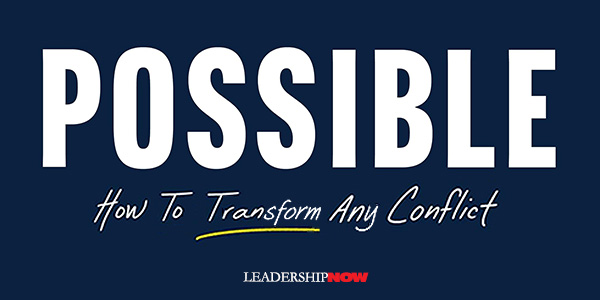
CONFLICT will always be with us. We’re human. William Ury says, “We actually need more conflict, not less—if we are to learn, grow, evolve. The problem is the destructive way we handle conflict—destroying relationships, lives, and resources. Thankfully, we have a choice.” In Possible: How We Survive (and Thrive) in an Age of Conflict, Ury explains how to embrace conflict and transform it constructively to bring out the best in us—not the worst. From his own experience dealing with eminent civil war, coal strikes, boardroom battles, Cold War nuclear tensions, and his own family feuds, Ury has developed a framework to help turn challenge into opportunity. Many conflicts seem impossible. But if you start from that assumption, that is most likely where you will end up—it’s impossible. But if you start from possibility, you might just end up with a practical solution to de-escalate the conflict. You become what William Ury calls a possibilist. One of the problems we face when in conflict is that we get caught up in the past instead of focusing on what is possible—what the possible future could look like. We attack one another instead of the problem. Possible does not mean a neat resolution. More often, it means gradual improvements in relationships that, over time, can make a difference. Relationships can be messy. Possible means finding ways forward where there seem to be none. It means creating little breakthroughs that can build into bigger breakthroughs over time. Possible means gradual transformation. The core principle of possibilists is humble audacity. That is, the “audacity of our goals needs to be balanced with the humility of our approach.” Humility is important because, in the heat of conflict, it is exceedingly hard to be calm, patient, and listen. Humility helps us to learn and be creative. The Circle of Possibility Ury has developed a model that can, over time, help us develop a mindset for navigating conflict. It is a way to see, create, and act on new possibilities. It creates a circle of possibility around the conflict. It begins with the balcony and moves clockwise to the bridge, then to the third side, and around again until the conflict is transformed.
Going to the balcony unlocks the potential within us. Building a golden bridge unlocks the potential between us. Taking the third side unlocks the potential around us. We need all three working together synergistically. Ury carefully explains each section of the path with engaging and detailed examples. I will provide a brief overview here, but by reading it, you will discover a powerful tool for taking on your toughest issues and revolutionizing your interactions. Go to the Balcony Rather than reacting to difficult situations, we first go to the balcony. “The balcony is a place of calm and perspective where we can keep our eyes on the prize.” We go to the balcony by exercising three powers that we all have: the power to pause, stop, and reflect; the power to zoom in and focus our attention on what we really want to achieve (the interests that lie underneath our positions – the why versus the what), and the power to zoom out and keep our focus on the big picture. The biggest obstacle to getting what I want is not the difficult person on the other side of the table; it is the person on this side of the table. It is me. When I react without thinking, I become my own worst enemy. I am the one who keeps getting in my own way. Build a Golden Bridge A golden bridge is a compelling invitation for the parties to cross the chasm of conflict. It begins with listening and discovering what the other party really needs and what they are most worried about. It is detective work. Listening for what is behind the words. Ury importantly notes: In conflict, we naturally start with where our mind is, what our position is, what we think is right. Deep listening means leaving where our mind is and starting the conversation where their mind is. It means listening from within their frame of reference, not just ours. Listening shows respect, and it is the greatest concession we can make, and it costs the least. We easily get confused about respect, often thinking that others have to earn our respect. Not so. Showing respect does not come from weakness or insecurity but rather from strength and confidence. Respect for the other person flows directly from respect for yourself. You give respect to the other not so much because of who they are but because of who you are. Building a golden bridge is where we get creative and turn an either-or dilemma in a both-and outcome. This is where listening becomes critical. “By delving deep into what people really want, we may discover that although the parties’ positions may be rigidly opposed, their interests may not be.” From what we have learned, we make it easier for the other party to say yes. “Our job in difficult situations is to make it easier—more attractive—for the other side to make the decision we’d like them to make.” You want to construct a narrative that makes both sides appear to be the heroes to the people that they care about. Engage the Third Side We are all connected. We are part of a whole—a community. The third side is the side of the whole. It is each of us working together for the good of the whole. Instead of us against them, if we take the perspective of the whole, we use the power of peers to transform a conflict. The third side unlocks the potential around us to transform. The third side involves three powers. “The first is the power to host—to welcome and connect the parties. The second is the power to help—to help the parties go to the balcony and build a golden bridge when it is not at all easy to do. The third is the power to swarm, which brings the full influence and leverage of the community to bear.” To help, we begin by asking clarifying questions. Often, they will persuade themselves. Advice is different from counsel. Ury adds, “To offer counsel is different, in my experience, from simply offering advice. Advice starts from the advisor’s perspective. Counsel, by contrast, starts from the other person’s perspective.” To help, you need to understand the local knowledge or context. It is easy to take what we have learned and impose it on the situation in the form of advice. General knowledge, if it is applicable at all, is sometimes hard for people to apply to their specific situation. “The trick is to blend general knowledge with as much local knowledge as possible.” “To swarm a conflict means to surround it with a critical mass of ideas and influence. Swarming integrates the balcony, the bridge, and the third side.” The community can often persuade and influence a situation better than any individual can. Swarm is the power of the community acting together. It is amazing to think of how many bridges we have seen burnt as a result of not applying these principles in conflict situations. We tell or demand rather than attract and guide. We go to the gutter instead of the balcony. We burn rather than build. We reduce everything to either-or rather than making room for the whole. Be a possibilist 
Posted by Michael McKinney at 10:46 AM
04.08.24

How to Make Wise Decisions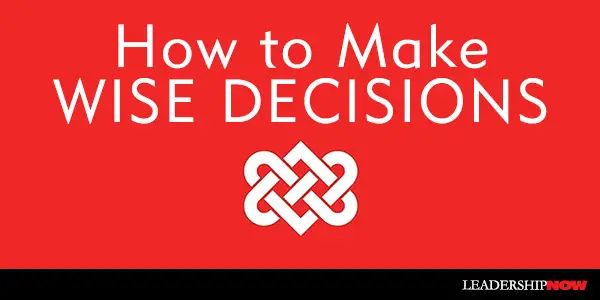
WE ALL MAKE bad or certainly less-than-stellar decisions for any number of reasons. Sometimes, there are too many options to choose from. Or, conversely, we don’t bother to explore other options than the ones in front of us. We easily create narratives to fit our interpretation of reality, cherry-picking the information that gets us what we want. And these are just the more common challenges we face. So, what do we do? In Wise Decisions, Jim Loehr and Sheila Ohlsson take us through some science-based approaches to help us make better choices. The starting point for good decision-making is perhaps obvious but easily overlooked and ignored, especially amid the rush of life. Our health is the foundation for good decision-making. Our holistic health—mental, physical, emotional, and spiritual—is the vital starting point for sound, thoughtful, and measured decision-making. We simply cannot take in, consider, and thoughtfully process multiple streams of relevant information, both tangible and intangible, when we are anxious, depressed, sleep-deprived, sedentary, isolated, and self-medicating with wine and M&Ms! Good decision-making is a process of reflecting and responding rather than reacting. We all hear something that can be vital to making good choices, but it doesn’t always get through. We block it. Inside of us, we have a gatekeeper who decides what gets through and what gets blocked. The authors call it our Y.O.D.A. – Your Own Decision Maker. To be your best advisor possible, Y.O.D.A. should be preloaded with critical life coordinates such as core values, beliefs, and purpose in life. Your own resident advisor holds the keys to extraordinary decision-making. Wise decision-making requires that we preload the control center in our brain our Y.O.D.A., with a complete grasp of who we want to be and what matters most to us. These values become the reference points that guide the decisions we make. Wisdom is the acquired ability to rise above the immediate demands and stresses of the moment; to make decisions that are grounded in transcendent values, core beliefs, and high ethical standards; and to achieve real and enduring perspective on the issues question. Those preloads need to be protected. There are always forces at work that can derail our thinking and compromise our choices. We must guard against corrupted input by reflectively analyzing and scrutinizing all information before letting it in to our control center. “When a belief is consistent with what we deeply want or need, we are less likely to scrutinize its authenticity.” We are not as rational as we think we are. Rather, we are “emotional creatures who have the capacity to be rational. Our emotions run the show in life, and our capacity for logical thinking serves to moderate the flow of emotion.” When we reflect, process, frame, and reframe life experiences work for us rather than against us, we keep our hands firmly on the proverbial cognitive steering wheel. And this is precisely how we maintain a sense of control when the storms of life are raging. What’s the mind is also real in the body at a molecular level, and the stories we tell ourselves can either help or harm our health and, hence, our decision-making capacity across life. Our emotions signal to us that something important requires our attention. It signals a need to pause and reflect. Should I act on them or not? “All emotions, whether we think of them as good or bad, are a fundamental part of being human. The goal is not to feel joy, inspiration, and happiness 24/7, but rather to identify all our emotions and to manage the resulting feelings in a way that way that enhances our overall health and well-being.” Stress, of course, has an impact on our ability to make sound decisions. Stress causes us to overthink and hyper-focus on the issue at hand. What we need is perspective. Without a view of the bigger picture, we often resort to poor thinking and behaviors that we rationally know don’t serve us well. Seeing only a sliver of the story, usually the bad part, too often results in a form of mental inflexibility and rigidity that can completely undermine our ability to make sound decisions. When stress levels are excessive, and we fail to buffer the stress with sufficient recovery, we tend to fall back on old and well-trodden behavioral paths. This happens because our narrow aperture simply doesn’t allow any other viable alternative to rise to the surface. During particularly stressful times, it is important to stay connected to others. And as stated above, we need to buffer stress with sufficient recovery or restore the energy consumed by the stress. The authors break down ways to do that: Balancing physical stress with recovery involves #healthy nutritional input, hydration, exercise, strategic movement, sleep, and intermittent periods of rest. The more our personal view of reality and the sorties we tell ourselves align with the world as it really is, the better the choices we will make. “When we fail to recognize that a piece of incoming data is faulty, the stories and beliefs and the decisions built upon that data will also be faulty. The stories we form in life, even those we consider foundational, perhaps even sacred, can be contaminated by biased data and faulty interpretation.” 
Posted by Michael McKinney at 12:17 PM
11.10.23

Michael Caine: Use the Difficulty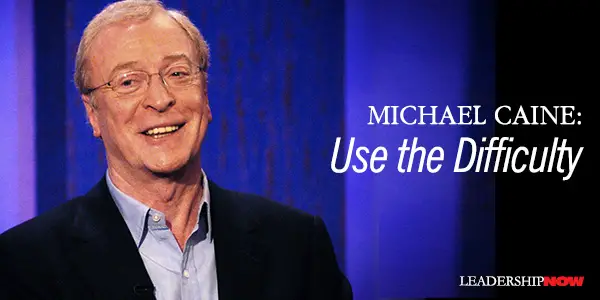
PROFESSIONAL golfer Phil Mickelson has played golf with a lot of elite performers like Tiger Woods, Michael Jordan, and Tom Brady. He said, “The biggest difference between people who get the most out of their talent and those who don’t is the ability to retake control of your thoughts, to quickly turn it around when things start going bad.” He adds, they “have the ability to retake control of their thoughts, to refocus on what they want to have happen, on where they want the ball to go. When things start going bad, they have the ability to quickly turn it around.” They are resilient. In an interview with BBC celebrity chat host Michael Parkinson, Michael Caine put it this way: PARKINSON: I came across a line which I just wanted you to sort of explain to me. You said that if you did have one philosophy of life, it was use the difficulty. Yes, use the difficulty. What does that mean? CAINE: Well, yeah. I was rehearsing a play when I was a very young actor, and I had to come into this scene—it was a stage play—I’m behind the flats waiting to open the door. There was an improvised scene between a husband and wife going on inside, and they got carried away, and they started throwing things. And he threw a chair, and it lodged in the doorway. And I went to get open the door, and I just got my head round, and I said, “I’m sorry, sir, I can’t get in.” He said, “What do you mean?” He sees a chair there, and he said to me, “Use the difficulty.” “What do you mean?” He said, “Well, if it’s a comedy, fall over it. If it’s a drama, pick it up and smash it.” He said, “Use the difficulty.” Now, I took that into my own life. You asked my children; they said directly if anything bad happens, they go, “Gotta use the difficulty. How can we work—what can we get out of this?” You know, use the difficulty. And so, there’s never anything so bad that you cannot use that difficulty in. If you can use it a quarter of one percent to your advantage, you’re ahead. You didn’t let it get you down. You know that’s my philosophy: use the difficulty. Also added philosophy is avoid them if you can’t!
Posted by Michael McKinney at 06:36 AM
08.25.23

The Art of Clear Thinking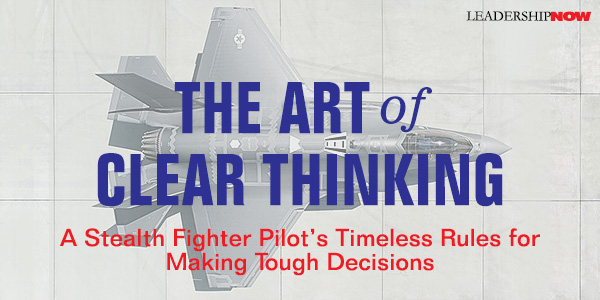
FIGHTER PILOTS must make thousands of decisions, often with incomplete information during each flight. U.S. Air Force fighter pilot and Chief of Training Systems Hasard Lee helped develop a program to boost pilots’ critical thinking skills and mental toughness to skew the odds in their favor when making these critical decisions. He passes the lessons learned on to us in The Art of Clear Thinking. Understanding how our decisions are made and how they can be improved going forward is essential with high-stakes decisions, but it is also important in our business and personal lives. The right approach to decision-making can save us a lot of regret down the road. He organizes his experience and training into a concept they call the ACE Helix. It has three parts: Access, Choose, and Execute. It is designed to bring out the best options while remaining flexible in ever-changing circumstances. 1. Assess the Problem Lee spends a lot of time explaining this step as the foundation for the success of the other two steps. “Developing a proper understanding of the problem is the first step to solving it. Our instinct is often to bypass this critical step and begin acting.” If we aren’t solving the right problem, we can make the right decision. It is important to keep the big picture in mind and not focus on just one piece of information. This is the ability to “make sense of a chaotic environment while simplifying and structuring information. This requires judgment, and judgment requires non-linear thinking. Often, our actions don’t result in a single outcome. Instead, they can lead to outsized outcomes that go beyond our imagination. They are non-linear outcomes. “For a multitude of reasons, people consistently fail to account for them, which often leads to a skewed assessment of the problem they’re facing and results in a poor decision.” These non-linear relationships are governed by power laws that can lead to exponentially greater or encompassing outcomes than we anticipated, which Lee explains in the book. “We become accustomed to how our actions are affecting a system, and then suddenly, the outcome is much different from what we were expecting. It helps if we have a broad understanding of the probable consequences of our decisions. We can adapt more quickly and accurately to changing circumstances. We can move our thinking beyond a narrow set of conditions. Lee talks about the approach they have during fighter training that all too often goes against the approach we have and certainly have experienced throughout our life. He says, “Our job wasn’t to weed them out but to coach them throughout each training event so that they could leave as the best possible pilots.” We tend to eliminate to try to cultivate the best and brightest. He adds, “We found that almost everything is coachable and correctable if identified early enough. Even supposedly intangible attributes, such as attitude, work ethic, and flying instinct, can be significantly improved if coached properly.” 2. Choose the Correct Course of Action To find the best solution, simplify. They use a technique called fast-forecasting. It is designed to build a mental model of the problem focusing on the few variables, due to strong power laws, that drive the system. This allows you to quickly approximate a ballpark solution. “We’re starting with the big-picture concept and slowly adding in detail until we have a good enough resolution to make a decision.” The key to fast-forecasting is to not get overwhelmed by the details—logic and reason are what drive the technique. Precision is often the enemy of conceptual thinking. What we’re trying to do is bring to bear the mental framework that we’ve accumulated over our lifetimes to estimate the expected value of a decision. If we instead make the problem overly complex, we lose the ability to quickly manipulate the relevant information through the lens of our concepts, principles, heuristics, and facts. Lee writes, “Creativity is one of the few resources that can provide an exponential advantage to those who are able to harness it.” Encourage creative decision-making with an effects-based approach. Start with the desired outcomes and work backward. “Breaking down the requirement into effects needed gives us at least an opportunity to explore alternative solutions.” Our desire to quickly find an answer or solution can lead us to jump to a solution that we are familiar with that might have worked in the past but is not really relevant to the current circumstance. 3. Execute Good execution requires the management of stress and, emotional control – and resilience in the face of failure. “While stress exposure can slightly increase performance for simple, well-rehearsed tasks, it severely reduces performance for tasks that require complex or flexible thinking.” Mental toughness is a skill that can be learned and improved. In fighter training, they incorporate a number of concepts into their training. Preparation is key. Mental toughness needs to be practiced until it is a subconscious reflex. They also include focus-based training. “The key to maximizing our mental resources is to focus only on what we have control over, which is the next decision to make.” Part of the training involves systematically building confidence. Confidence is not something you have, or you don’t. “Confidence is a skill that can be improved, primarily through our internal dialogue—how we talk to ourselves.” Perfectionism and focusing on our mistakes creates self-doubt, which is detrimental to high-stakes decision-making. Trainees are taught to reframe and replace negative self-talk with a successful counterexample from their past. In stressful and uncertain moments, it is important to keep your priorities your priorities. Focus on and prioritize what is important. “If there isn’t a clear vision, our minds will default toward urgent tasks.” At some point, you have to be decisive. You’ll never make the perfect decision. You can remove all uncertainty from your decision-making. When making decisions, “we’re just trying to remove the choices that are clearly not optimal.” Lee says that “when there are multiple seemingly equal choices,” he has found that “going with the riskiest viable option usually provides the greater return in value. Most people hate uncertainty, particularly when it’s combined with risk. As humans, we are biologically programmed to overestimate risk. If you’re able to overcome that mental hurdle, it becomes easy to differentiate yourself and greatly increase your odds of success.” The Art of Clear Thinking is full of great stories to illuminate the concepts and makes this business book read like a gripping novel. He shares a lot of information, so you will need to go back and reflect on how it can best be applied to your tough decisions. 
Posted by Michael McKinney at 04:39 PM
05.05.23

Align Your Organization to Succeed in Today’s and Tomorrow’s Changing Environment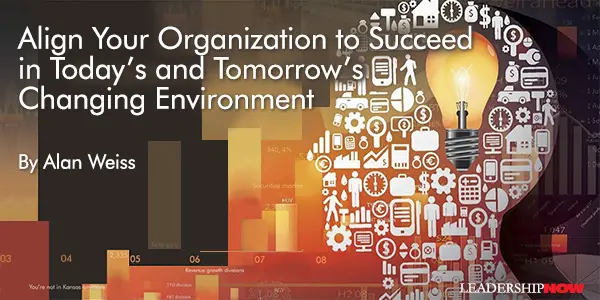
THE PANDEMIC threw all strategies into the junkyard. We now have the opportunity to deal with new realities, but that calls for an entirely new approach to half-century-old strategic processes. Conduct your “forensic implementation analysis” to examine these five dynamic forces: 1. Which Practices to Sustain In this dynamic, you are doing things today that will also serve you well in the future in achieving your vision. Ford’s F-150 pickup truck is the best-selling vehicle in the U.S. and has been for some time. It will probably maintain this status in the immediate future. Ford needs to sustain that type of vehicle and capabilities, whether powered by gas, batteries, hydrogen, or advertising heft. My landscaper has been working with different crews for the 30 years I’ve known him. He consistently sustains a scientific method about grass height, shrub diseases, removal of pests, and so forth. His equipment has changed as his crews have, but not the criteria he uses to keep the property looking great. 2. Which Practices to Improve You may currently be conducting business and engaging in actions that are working well now but won’t be for the future. You can build on their momentum by altering and changing them to maximize progress toward your vision. Championship golf courses use an architecture and difficulty that challenge the best in the world. But as the best keep getting better (improved equipment, better conditioning and strength, smarter course management, better coaches and caddies), it’s vital to improve the courses to meet the new abilities. Second and third cuts of growth may be made longer, bunkers deeper, and hold lengths extended. And the Professional Golf Association (PGA) also makes new rules to adjust to advances, including how many clubs players may carry and what kinds, the construction of the ball, and so forth. The improvements have to be consistent with an existing strength that required augmentation if it’s to remain effective in helping to drive the enterprise forward. 3. Which Practices to Jettison The poorest-run organizations refuse to fire people. Sometimes the excuse is legal concerns, and sometimes it’s someone in human resources trying to prove the department is actually important. Yet terminating poor performers is a service to the performer as much as to the organization. And too many organizations hold on to processes and procedures that not only will not help to reach the vision, but will usually impede progress. 4. Which New Practices to Retain Some adjustments due to the pandemic led to a great many new and effective practices — such as take-out food from high-end restaurants, virtual meetings, and heightened streaming entertainment. What we improvised for the moment should be analyzed as potential longer-term factors for success. You must identify those initiatives, innovations, and even behaviors that you may once have thought were temporary or ad hoc to deal with the pandemic but which are, in actuality, permanent advantages if you allow them to be. 5. Which Practices to Acquire The greatest innovations have come in times of war, pestilence, natural disaster, and so forth. Aside from weaponry, warfare created huge advances in medicine, trauma treatment, and communications. Moreover, innovation needs to be rather immediate. Strategically, you must look to acquisition in support for your strategic factors constantly, given changing times and priorities. You can’t look outside only when you’re failing inside! The point of your new strategic alignment is to ensure that you sustain your strengths, improve what is good but needs to be better, retain what you’ve created, jettison what will no longer support the organization, and acquire what’s missing to lead you toward your vision.  
Posted by Michael McKinney at 06:33 AM
04.25.23

The Four Workarounds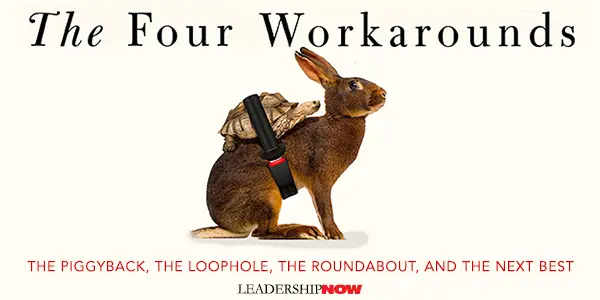
WORKAROUNDS are a deviation from the norm. They are nonconformity. Conformity isn’t all bad; we often do it without much thought. But there are times when we are better served when we ask why and perhaps deviate from the expected. Oxford University professor Paulo Savaget makes a distinction between disobedience and deviance in The Four Workarounds: Strategies from the World's Scrappiest Organizations for Tackling Complex Problems. He says that disobedience isn’t the opposite of conformity. “Disobedience blatantly antagonizes the establishment, and the establishment almost always retaliates in kind. Deviance, on the other hand, is trickier. Deviance entails unconventional approaches that use parts of the status quo that work (as intended or not) in order to change the parts that don’t.” Deviance is the opposite of conformity. Savaget identifies three approaches to deviance or standing out from the crowd. First, there’s confrontation which “always means clashes against dominant power structures.” Second, there’s negotiation to put pressure “on authority figures to legitimize changes in the system of rules.” And finally, there’s the workaround. “Through workarounds, we can promptly get things done and defy the status quo without directly antagonizing rule enforcers.” Workarounds are the lower-risk option for moving something along. There are four workarounds each using a different attribute. Knowing each approach can help you determine the best response to getting things done. The Piggyback “The piggyback workaround enables us to circumvent all sorts of obstacles and address our problems by using seemingly unrelated relationships.” The piggyback often creates relationships between unconventional partners. Piggybacks occur “between silos rather than in them.” A couple solved a problem of distributing life-saving medicines in Sub-Saharan Africa by piggybacking on the distribution of Coca-Cola that was readily available in the region. Oreo piggybacked clever Twitter advertising on the 2013 Super Bowl power outage. The Loophole “The loophole either capitalizes on an ambiguity or uses an unconventional set of rules when they aren’t the most obviously applicable.” In looking for loopholes, remember that “there’s often more than one way to be right, and simply following or breaking rules isn’t always the best way to get something done. Often there is an option that lies in between.” The Roundabout A roundabout may not solve the problem, but it can buy us time until we can find a permanent solution. It can be useful if you use that time wisely. “Roundabouts don’t so much tackle systemic challenges as interrupt self-reinforcing behaviors and but time to mobilize, negotiate, and develop alternatives, alleviating an urgent problem while building momentum to pivot in a different direction.” The Next Best Next-best workarounds use what is available to solve an immediate goal. “Using limited resources, scrappy organizations and mavericks teach us that often the best step forward is not focusing on what the ideal ought to be, but instead drawing attention to available opportunities that tend to be ignored.” A great example of a next-best workaround is the non-profit Rainforest Connection to thwart illegal logging. By repurposing old cell phones strategically placed in the rainforest to listen for the sound of chainsaws, they are able to send real-time alerts to rangers and community patrols with the location of the logging to catch loggers in the act. Each of the workarounds has a primary element at play. When you think about piggybacks, consider the existing relationships in your situation. Loopholes require paying close attention to different sets of rules. Roundabouts involve examining behaviors that lead to inertia. And if you’re searching for next-best approaches, fiddle with the resources you have on hand. Not every situation is going to necessitate using each of these four workarounds, and that’s okay. In the end, you really only need one workaround for most challenges. 
Posted by Michael McKinney at 07:20 PM
03.13.23

Decision Making is Not What You Think
HOW TO find a spouse? We all know how to make important decisions. First we diagnose (figure out what the problem is), next we design (identify possible solutions), then we decide (evaluate each, and choose the best), and finally we do (carry that choice into action). In other words, we think in order to act. I call this thinking first. Finding your spouse was probably the most important decision you made in your life. Did you think first: made a list of what you were looking for — say, brilliant, beautiful, and bashful; or strong, sexy, and steadfast — then list all the possible candidates, analyze their score on each of these criteria, add up all the scores to find out who won, and inform the lucky person? The problem is that your chosen is likely to have replied: “While you were going through this rigamarole, I got married and had two kids.” Thinking first does have its drawbacks. If this is how you proceeded, you’re probably still single (unless you’re Indian — it often works in India, but with the family doing the thinking). So maybe you proceeded differently, like my father, who announced to my grandmother: “Today I met the woman I’m going to marry!” There was not a lot of analysis in this decision, I assure you, but it worked out well. A long and happy marriage ensued. This is known as “love at first sight.” As a model of decision making, I call it seeing first. Even some rather formal decisions happen this way. For example, some might buy a car because they like the looks of it. Others might even buy a company upon first sight. These aren’t necessarily whims; they can be insights. But there’s another, sometimes more sensible way to make decisions. We don’t think in order to do, we do in order to think. Hence, I call it doing first. Not being sure how to proceed in the affairs of love, or what might make a suitable spouse, we meet someone and try living together to find out how that works. If it does, we continue. We may even get married. If not, we try someone else. Start small to learn big. In business, this could apply when thinking of raising your prices. You start with some test market. If that doesn’t work, you re-engineer your product to lower its cost. This too has its drawbacks. As described by Terry Connolly, a professor of decision making, “Nuclear wars and childbearing decisions are poor settings for a strategy of ‘try a little one and see how it goes.’” No doubt! But there are a lot of other decisions for which this proves to be a perfectly acceptable course of action. IKEA came up with its strategy of selling its furniture unassembled after a worker had to take the legs off a table in order to get it in his car. “If we have to do this, what about our customers?” Rest assured that IKEA must have tried this on a few items before it changed to its “assembly required” line of products. These days, there’s a lot more seeing first and doing first than you might think, and not only in the world of romance. Look for it in every business, government, and NGO. For example, to hire a new employee, we can, of course, go through the whole process of diagnosing and designing and deciding. Or we can just interview some likely candidates and pick the first one who just seems right — decision at first sight — trusting our intuition. Or, if we’re not sure, we hire one on contract for a few months to see how they work out. We learn from doing. Of course, just as thinking first can be tricky, so too can seeing first. We might not see past the surface. As for doing first, think about, not only having a baby or starting a nuclear war, but also wherever other small engagement can result in an irreversible commitment from employing this tactic. Think, See, Do. All are necessary in the world of decision making. Sometimes one, sometimes another, sometimes together, but not necessarily in that same order.  
Posted by Michael McKinney at 07:14 AM
12.19.22

How to Solve Our Wild Problems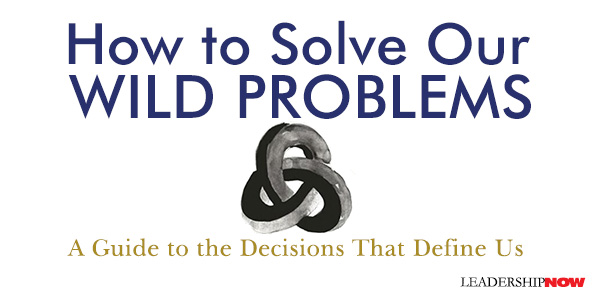
THERE ARE PROBLEMS that can be solved by a simple cost-benefit analysis. But there are problems where the solution lies beyond that — something deeper — something irrational even. The big decisions in life, what Russ Roberts calls Wild Problems — whether to marry, who to marry, what career path to follow, ethical dilemmas — “can’t be made with data, or science, or the usual rational approaches.” In 1838, Charles Darwin faced a wild problem. Darwin was trying to decide if he should marry. Like many, he made a list of the pros and cons and wrote them down in his journal. But marriage, like most wild problems, can’t be reduced to measurable rational reasons. It is much more nuanced than that. Not everything can be boiled down into a yes or no. But more than that: Making a list of pluses and minuses when facing alternative universes is a way of trying to imagine what it will be like under each choice. Thus seems rational and is a version of trying to maximize what economists call expected utility—your expected well-being in the future.
At the top, he wrote, “This is the Question – Marry – Not Marry.” Then on the pro side, he tried to imagine what it would be like to be married. On the right side, he tried to imagine what it would be like not to marry.
Darwin is looking at marriage from just what you can see from the outside—the outer life of marriage. Darwin’s list tells us more about Darwin than it does about marriage. His list of pluses and minuses—especially the pluses—is the list that someone would make who has never been married and has no access to the upside of the inner life of a married man. Darwin’s ignorance is part of the reason his negatives about marriage (banishment! Degradation! Idle fool!) are so emphatic and his positives are so mild (female chit-chat). It is hard to define what the consequences of your choice are about to make if you have no experience with the choice you are about to make. You can’t really know the costs and benefits of a choice until you have experienced it. Darwin can’t rightly judge the upside of marriage and so he can’t know if the expected costs outweigh the expected benefit. Not only that, if he gets married, the experience will change him in ways he can’t imagine—what he values and what is important to him. Moving beyond costs and benefits—pain and pleasure—is the idea of flourishing. “Flourishing includes living and acting with integrity, virtue, purpose, meaning, dignity, and autonomy—aspects of life that are not just difficult to quantify but that you might put front and center, regardless of the cost.” So what do we do when faced with a wild problem? Roberts suggests we begin by approaching the issue by privileging our principles. That means considering what kind of person you want to be and what you want to become. Your decisions define who you are. Don’t make tradeoffs when it comes to your essence. Live with integrity. Do the right thing and respect yourself. That at least should be the starting place. One way to do this is to have rules that you follow no matter what. It helps to make deciding what to do simpler. For example, your rule might be, “I am the kind of person who doesn’t make jokes about my spouse in front of other people even when they are incredibly funny.” Roberts adds, “Rules are useful in maintaining who you are, our sense of self. But they’re probably even more important in helping us become who we might want to become.” Here are a few concluding thoughts from Roberts: Try to have more experiences than fewer. Try stuff. Stop doing the stuff that isn’t for you. 
Posted by Michael McKinney at 10:58 AM
07.25.22

Antigone and the Psychology of Leadership Decision-Making: The Art of Reflection and Compromise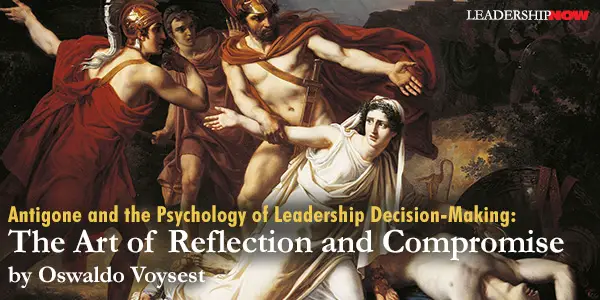
ONE OF THE MOST crucial aspects of leadership is decision-making. We all know why good decisions matter and how bad decisions can be catastrophic. Broadly speaking, the decision-making process for leaders looks something like this: identify the problem(s), gather information, weigh the evidence, develop and analyze alternatives and risks, select an alternative, and then take action. After completing this process, you are pretty confident you have made the right choice. But what happens when an equally right decision arises conflicting with yours? Antigone, a fifth-century BCE play by Sophocles, can help us think through 21st-century leadership situations where two right decisions are at odds with one another and where events overpower what a person thinks or believes in. The Story A quick background. The ancient Greeks constantly sought to improve their polis (city-state) by delving into issues of human nature, social organization, and political life, among many others. The struggle and the attempted balance between the individual and their organization was one of the central features of ancient Greek literature, philosophy, and history. In Antigone, we see the clash between the individual religious imperative and the political interest of the state, both competing to assert the moral high ground. But which is the right decision? What can 21st-century peak performance leaders learn from Antigone when the right versus right dilemmas seem to thwart your plans? As the play opens, Antigone declares her intention to her sister Ismene to defy Creon’s (the Theban ruler’s) order to bury one of their brothers. We find out that her two brothers (Eteocles and Polynices) have killed each other in battle outside the walls of Thebes, and the enemy forces have been successfully driven out of the city. Since Eteocles defended the city, but Polynices attacked it, the former gets a burial with full honors while the latter is to be left to rot under the penalty of death for whoever attempts to bury him. Antigone, uncompromising and knowing full well the consequences of her actions, obeys “the laws of the gods” (lns. 91-92) instead of the “laws of men” (ln. 502). After she is apprehended for performing burial rites on Polynices, Creon’s son (Haemon), who is betrothed to Antigone, pleads with his father to show mercy, but to no avail. Creon orders Antigone to be walled up “alive in a rocky vault” with short rations (lns. 871-72), but the city prophet tells him that doom and tragedy will befall him if he does not reverse his decision. At first, Creon mocks and insults the prophet, but in the end decides to heed his warning, only to arrive too late for Antigone, his son, and his own wife have all killed themselves. Importance of Sound Reflection In his book Questions of Character: Illuminating the Heart of Leadership through Literature, Professor Joseph Badaracco argues that Antigone shows us the importance of sound reflection for leaders “in the midst of enormous pressures and ceaseless distractions” and the calamitous “consequences of failing to do so.” For him, on the surface, the play appears as a conflict between two principles: family and country. However, Badaracco adds, it’s more like two similar leaders defending their single highest moral value for leadership —religion for Antigone and civic duty for Creon. This conflict seems analogous to Dennis Prager’s critique of idealists and extremists in his book Think a Second Time. Taking extremists as an example, Prager argues that extremism is a much easier and more comfortable position than moderation since the latter involves wrestling “with and [weighing] competing values.” He adds that those who are not extreme idealists “frequently are plagued by the realization that competing good values almost always exist, and are always assessing the consequences of their commitments to any given value” (161). Seeking Compromise and Solution-Driven Collaboration Similarly, in Antigone, we see the tragic consequences of unbending thinking in not acknowledging competing goods and not seeking compromise and solution-driven collaboration. Sophocles seems to suggest that good reflection “is not an individual exercise but a fundamentally communal one” (Badaracco 177). Creon does not heed the words or advice of his son, to the blind prophets, or to the Chorus. Like Dennis Prager’s description of an extremist, he “can never have too much of this good value” (160)—patriotism, in his case. For her part, Antigone, throughout the play, cannot acknowledge a competing good value either: “I alone, see what I suffer now at the hands of what breed of men— all for reverence, my reverence for the gods!” The decision-making process for leaders is not a simple one since it often involves a balance between emotional and reason-based considerations. Weighing options, looking at alternatives and implications, considering the viability of projects and proposals, etc., are all important considerations. Most decisions involve making tough calls between equally valid and viable choices, and in our technological and digital-driven age, the large amount of data and information available almost instantaneously can contribute to the conflict between competing good ideas. Yet, there are cognitive biases, past experiences, individual differences and beliefs, and other relevant factors that cannot be ignored. Take the well-known Blockbuster case, whose downfall was due to more than just the appearance of Netflix as a competitor or the inability to join the tech bandwagon advances. Alan Payne, the former franchisee who owned the second-to-last US Blockbuster in Alaska, told corporate offices that Blockbuster’s business model was not addressing competition from other sources, but nobody listened. Years later, Blockbuster’s owner, Wayne Huizenga, found in time a solution for the floundering profitability of the company—he sold it to the media conglomerate Viacom in 1994. In the end, the new boss, CEO John Antioco, reportedly laughed off an offer by Netflix and made Netflix an example of what is called, in business theory, disruptive innovation. As mentioned above, the deliberation process encompasses a range of feelings and emotions, unforeseen changes, open-ended situations, possibly moral and ethical considerations, and a host of other factors. Ambiguities are a part of life and certainly of the decision-making process. Like both Antigone and Creon, many leaders display a seemingly admirable tenacity. Nonetheless, many get carried away by their own tendencies and instincts, and even their own apparent success, and fail to reflect on the more complex series of variables beyond the basic decision-making paradigm (right vs. wrong). Choices are normally tough and may challenge our ideas, beliefs, or identity. They involve more our moral force and integrity than any sophisticated algorithm or technical skill. Just like in Antigone, where we see “Creon’s greatest challenge is not Antigone or rebels hiding in Thebes, but his own character, [a]nd Antigone’s great challenge lies withing herself, not in Creon’s edict” (Badaracco 171), for any leader, in the final analysis, it will be his/her character combined with shrewd pragmatism rooted in ethical choices that are tested. How they respond will depend on reflecting deeply and knowing how and when to compromise accordingly. 
Posted by Michael McKinney at 11:01 AM
06.06.22

A New Way to Think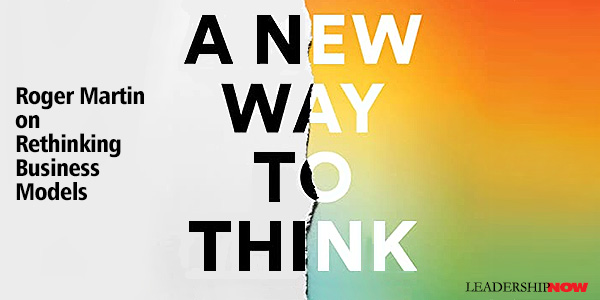
A BUSINESS MODEL reflects the way we think a business works. They shape how we conduct business. We have models related to all business activities, from production, pricing, and selling to how we motivate, hire, and manage. Every business model is based on assumptions that, too often, we don’t make explicit. And that’s where we can get into trouble. Roger Martin reports in A New Way to Think that when a model—“a given framework, general practice, theory, or way of thinking”—doesn’t seem to be working, we simply double-down on it and try to execute better. “If making execution a priority doesn’t result in better execution, make execution still more of a priority. If your culture doesn’t change in the direction you want, then mandate culture change even more aggressively.” “The models are extraordinarily persistent in the face of ineffectiveness and that is because our use of models to organize our thinking and action is so automatic.” So, we never rethink it. When Martin has been asked to help figure out why something isn’t working as well as the CEO wishes, he says, “It has become clear to me over the years that in nearly every case, the poor results weren’t down to their not working diligently enough in pursuit of their goals, it was because the model that guided their actions wasn’t up to the task.” In 14 self-contained chapters, Martin compares a dominant but often flawed model with an alternative that he believes is more effective and based on better assumptions. He states, “One should always use the best model available, but watch closely to see whether it produces the outcomes that it promised,” he writes. “If it does, keep using it. If it doesn’t, then you should work on creating a better model — one that produces results more in keeping with your goals.” All of the now dominant models make sense and have been used for obvious reasons, but they need to be re-evaluated from time to time. Each topic reveals the underlying assumptions of old and new ways of thinking: 1. Competition
2. Stakeholders New model assumption: To actually create shareholder value, put customers before shareholders. A single-minded focus on profits guarantees you won’t get them. 3. Customers
4. Strategy
5. Data
6. Culture
7. Knowledge Work
8. Corporate Functions
9. Planning
10. Execution
11. Talent
12. Innovation
13. Capital Investment
14. Mergers & Acquisitions
As each chapter is a self-contained real-world story, it allows you to skip to subjects of interest. In that way, it is a management handbook that you can return to again and again according to your circumstances. 
Posted by Michael McKinney at 06:36 AM
05.09.22

The Crux: How Leaders Become Strategists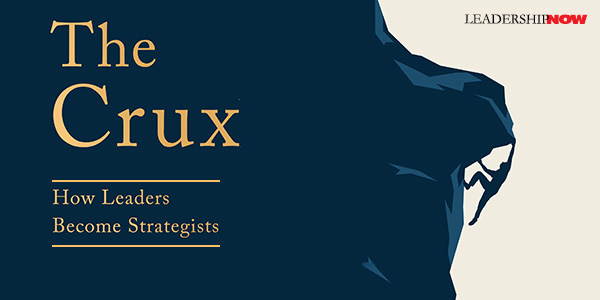
THE CRUX of the matter is a phrase that has been around for over 200 years. Richard Rumelt recalls climbers in France calling the boulders they climb “problems,” with the toughest part of the problem referred to as “the crux.” Climbers will often look for a challenge that has the greatest reward and whose crux they believe they can solve. In The Crux, Rumelt uses this as a metaphor for life. We all face problems, and finding the crux is the secret sauce where we “can gain the most by designing, discovering, or finding a way to move through and past it.” Rumelt uses the term crux to describe a three-part strategic skill: The first part is judgment about which issues are truly important and which are secondary. The second part is judgment about the difficulties of dealing with those issues. And the third part is the ability to focus, to avoid spreading resources too thinly, not trying to do everything at once. The combination of these three parts lead to a focus on the crux—the most important part of a set of challenges that is addressable, having a good chance of being solved by coherent action. We often get off to a bad start by not understanding what a strategy is. “There is a widespread misconception that a business strategy is some sort of long-range sketch of a desired destination. I encourage you to think of strategy as a journey through, over, and around a sequence of challenges.” To have a single unchanging strategy that spans through challenges “reduces the concept to a slogan or motto, like ‘Be the best.’ Strategy is problem-solving, and it is best expressed relative to a particular challenge.” Strategy is for problem-solving, but to do that, you need to get to the crux of the problem. “Don’t start with goals—start by understanding the challenge and finding its crux.” The concept of a crux narrows attention to a critical issue. A strategy is a mix of policy and action designed to overcome a significant challenge. The art of strategy is in defining a crux that can be mastered and in seeing or designing a way through it. Strategy is an exercise in power because it always involves a shift in power and resources. When faced with a number of challenges, we tend to deliver incoherent goals—actions that contradict each other. They may sound like nice goals designed to please but are incoherent and therefore unattainable. We get nowhere. (And this sums up our political gridlock.) One sees how coherence is easily lost. The cost of coherence is saying no to many interests with reasonable values and arguments. A strategist tries to not be a politician. The art of compromise and building the big tent that everyone can shelter under is not that of the strategist. Rather, it is coherence aimed at the crux of the problem. In other words, actions should not conflict with one another. For example: Don’t base your competitive edge on continuing development but then cut R&D to make your numbers. After Rumelt goes through a series of business problems that give birth to his concept of the crux as it relates to strategy, he then dispels some myths and explains how we get to the crux. Getting to the crux of the issue is harder than one might think. We are too often stuck in our assumptions. Often it requires a reframing, a new analogy, or a reanalysis of data in ways that we have not previously considered. Organizational issues “can be resolved successfully using the principles of crux-strategy problem-solving diagnosis, reduction to a crux, performance concepts, and coherent action.” You don’t want to start with goals. You want to start with challenges. “A collection of goals or metrics is not a strategy. A strategy is a reasoned argument about the forces at work in a situation and how to deal with them.” Further, “Strategy work defines the goals and objectives to be sought. Good strategy work begins with recognizing a challenge and in understanding the difficulties in overcoming it. Good strategy work produces policies, actions, and objectives.” About mission statements, Rumelt says, “If you accept that strategy is a form of problem-solving, that it is a journey, and that it is a response to challenges, then mission statements are not helpful in strategy work. They are a waste of time and effort.” Financial goals, mission statements, and quarterly earnings become distractions when strategy work. Rumelt walks us through a crux defining, strategy creating process, which he calls the Strategy Foundry. It is an intense challenge-based discussion to get to the crux that will form the basis of the strategy. It is not goal setting or budgeting. By starting with the challenge, the group becomes responsible for designing a response rather than choosing among plans already advanced by members or others, or just filling in the blanks for a longer-term budget. Each story in The Crux will make you rethink strategy—what it is and is not and how it is created. The principle of the crux is also a good life lesson. Finding the crux will help you determine the appropriate response to a given set of circumstances. 
Posted by Michael McKinney at 10:31 AM
04.18.22

How to Make Difficult Decisions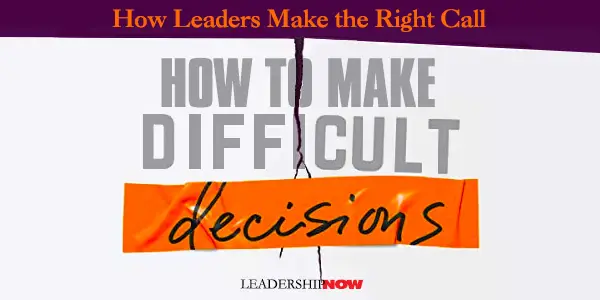
MOST difficult decisions are not difficult because we lack information but because we are juggling three subjective dimensions: moral, ethical, and our role responsibilities. While I believe that there are black and white absolutes that cross all boundaries, we live in a world that presents us with gray areas and nuances. Knowing how to apply your morals and ethics in the context of your job is critical to effective decision-making. We like to think we are objective, but the circumstances often call for subjectivity. Machine learning and artificial intelligence are not bias-free and can’t tell us what to do and the consequences of our decisions. In Difficult Decisions, Eric Pliner says we have to rely on our judgment, and “our ability to make those judgments skillfully is informed by what’s going on inside of us, what’s going on around us, and what we understand is expected of us.” This presents us with the Moral-Ethical-Role Responsibility Triangle.
It works like this: For example, “when my role requires me to engage in activities that are generally considered acceptable (Ethics) but that I personally believe to be wrong (Morals), the moral and role responsibilities dimensions of the triangle are in conflict. In those cases, I use my morality to challenge my role responsibilities (a one-time proposition), or I can look to contextual ethics – what does the world at large have to say about what I am being asked to consider or do? – to help me to test the extent and depth of my morality.” Naturally, you could quit (a one-time option), but the goal is to stay engaged and lead even when you are navigating contradictions. This triangle framework helps to sort out the issue in our mind in relation to our decision-making ecosystem when dealing with difficult decisions. The intersection of these three constructs informs how we make decisions: what we believe at our core; what we understand to be acceptable in our current sociocultural or sociopolitical context; and what we commit to, explicitly and implicitly, by taking on a role—formally or informally—in an organization, a community, or even a family. When these align, decision-making is easy. When they do not—and for the most difficult challenges, they usually don’t—our ability to understand each element on its own, and sort through their apparent conflict, is at the heart of whether we can make difficult decisions with skill, insight, and empathy. Pliner takes us through each of the three dimensions of the triangle to help us understand and be fully conversant with each. Knowing your moral boundaries, the ethical context of the times you lead in, and your understanding of your role will help to strengthen your ability to make difficult decisions when you are called upon to do so. Your job as a leader is to affirm the decision you’ve made—to reflect on how you got there, be clear about what you plan to communicate about both the decision and the process of arriving at it, and to whom you intend to communicate and how to match your message with their priorities and belief and interests. 
Posted by Michael McKinney at 09:01 PM
01.25.21

Leadership U: The Six Degrees of Leadership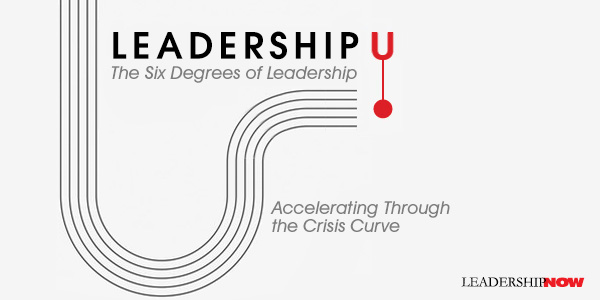
TO LEAD people from one place to another in good times and in challenging ones requires a framework like the one presented in Korn Ferry CEO Gary Burnison’s concise book, Leadership U: Accelerating Through the Crisis Curve. The framework is called, The Six Degrees of Leadership. These six degrees are mastered separately but work together in practice. Degree #1: Anticipate
Anticipating is 90% bottom-up and only 10% top-down. To anticipate, you need to make the hierarchy invisible. Take a total inventory across the organization as you listen for what people are thinking, feeling, fearing, and experiencing. Burnison says no matter the climate, the question is always, “What does this mean going forward?” Degree #2: Navigate
Impatience doesn’t get the job done. It inspires more fear than high performance, which can override critical thinking. Anybody who has gone into a skid on black ice can relate: your instinct is to slam on the brakes and jerk the wheel in the opposite direction. It takes a clear had to do the opposite—the counterintuitive—of steering into the skid to regain control. Degree #3: Communicate
When there is trust in what you say, there will be belief in what you do. That starts with modeling a “say/do” ratio of one-to-one. You do what you say and say what you mean. When you’re viewed as an authentic leader, people will not only trust your words and actions, they will also mirror what you say and do. Degree #4: Listen
What often can hold people back from giving honest feedback is the lack of perceived economic independence. Those over us control our resources. “Economic stability is the ultimate truth serum, and leaders need to recognize that.” As you listen, you need to distinguish between the urgent and the important. When a crisis hits, though, everything blurs as events and their implications constantly change. What’s important often becomes urgent, and the urgent becomes critical. You must delegate others to lead around a common purpose. Degree #5: Learn
The distance between your company and its competitors is not absolute; it’s relative. If you want to transform your organization, you must grow your organization through learning. Degree #6: Lead
In a world where so much has be reimagined, nobody has all the answers. This is not a time for individual heroism. It’s all about the team—and you need talented people around you. 
Posted by Michael McKinney at 07:46 AM
01.22.21

Embrace the Suck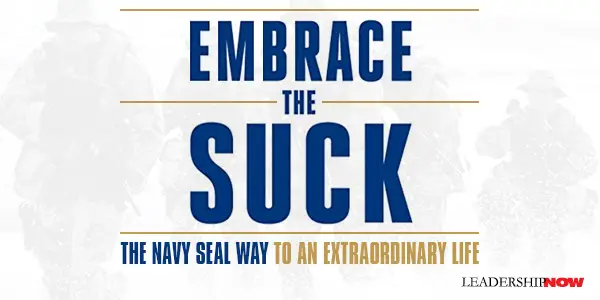
RESILIENCE is what carries us through life to reach our goals. Pain will always be with us, but if we can learn to lean into it and get comfortable with being uncomfortable, we can live a more fulfilling life. Resilience is what Brent Gleeson’s book, Embrace the Suck: The Navy SEAL Way to an Extraordinary Life is all about. He writes, “To avoid pain is to basically deny our potential. We can’t develop psychological resilience without experiencing emotional pain and suffering.” Resilience is about perspective and embracing reality. The most mentally and physically tough people I know constantly practice the fine art of building resilience—deliberately pounding away at the boundaries of their comfort zone in pursuit of their passions and causes greater than themselves. Simply put, they choose adversity over mediocrity and continue pushing forward despite the odds stacked against them. By strengthening our minds, we can overcome obstacles and pave the way to an intentional life. Gleeson provides us with several mental models to help us navigate misfortune, pain, and uncertainty. One simple but effective model Gleeson offers for this is the Five-Step Root Cause Analysis. When we understand cause and effect—the consequences of our behavior—we can grow and move forward. Observe, learn, and grow.
Gleeson uses the example of being laid off—the bad thing that happened to you. The High-Level Cause is at they had to downsize, keeping only the top performers. But as you dig deeper, focusing only on those issues you can control, like your actual or perceived underperformance, you can discover something actionable. Then ask what you did well and what you could work on and list them in step four. Then in step five, make specific goals that are concise, realistic, and time-bound, starting with an objective statement like “I will never lose another job for underperformance.” A useful tool for learning to identify and then control what you can control. This personal feedback loop will “place you in a constant state of course correction and improvement.” Of course, we need to be clear about our values. Your values help you know what winning looks like. “Essentially, any action or choice should clearly fit within your value lane markers. Deviation outside those markers typically ends in tragedy. You need to ask yourself what you are willing to do to live by those values and, even more importantly, what you are unwilling to do to avoid deviation.” Like removing temptations. When working towards our new goal, we have to remove anything that stands in the way of it. “Remove every opportunity for temptation and distraction—any obstacle or competing priority. Maintain total mission focus.” Develop self-control. Temptation is just a reality of life. Without it, there would be no such thing as willpower. Life will test you on a regular basis. So be prepared to ace the test!” And as Gleeson points out in chapter 7, chose wisely what you suffer for. “Life is a series of choices.” Successful Seals training students make it through because they “accept it as a means to a better end.” And he encourages, “If you stumble, find the root cause and move on. Don’t let yourself get wrapped up in guilt, anger, or frustration, because these emotions will only drag you further down and impede future progress.” Throughout the book, you will find many mental models with practical steps to move you forward. Models like Eight Failure Realities, Five Steps for Taming Temptation, Practicing the Things That Suck, Mastering Self-Discipline, and a model for Violent Execution, among others. How willing are you to embrace the suck? Go to war with yourself. 
Posted by Michael McKinney at 08:05 AM
12.15.20

Uncharted: How to Navigate the Future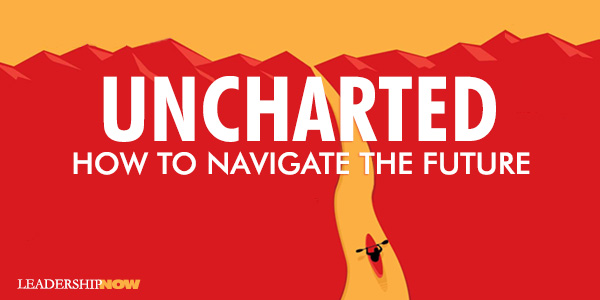
PREDICTION has never been easy – or that accurate. Over and over again, forecasts and models fail us. And when they do, they won’t go away because the agenda behind them lives on. As a model or a forecast is designed to do, we become “recruited into an army of believers.” “The more we believe, the less we question,” says Margaret Heffernan. In Uncharted: How to Navigate the Future, she writes that “Overwhelmed with complexity, we seek simplification and too quickly reach for binary perspectives, just at the moment when we need broader ones.” How true. We crave certainty in a world that remains ambiguous. In an outstanding first chapter—False Profits—she reviews the work of three economic forecasters and the shortcomings and consequences of each. Forecasts and models are useful if they get you thinking, but only if we see them for what they are—propaganda.
Our past informs our present and future, but it can’t predict it. History, especially our personal history, defines a trajectory and provides us with probabilities. It tells us how we tend to react to what life throws at us, but we also have the capacity to learn and grow and change. New experiences shape us.
Believing that his history always repeats itself can lead to “blindness and blunder.”
Much of what she is talking about here defines the year 2020. So, if we can’t predict the future, what can we do? First, we can experiment more. In a time of crisis, we need to know more. We need to experiment. Experiments are an “antidote to helplessness or passivity. They set us on paths that reveal new knowledge and choices.” We can develop scenarios to “identify and test how and where the future and the present meet.” Different from experiments that “reveal immediate internal features of a complex system, scenarios explore where the internal organization meets the external environment, where uncertainties lurk beyond anyone’s control.” Scenario planning always surfaces conflict and there is always a moment when everything seems to fall apart. But getting the conflict out in the open, constructively, is crucial; it’s how and when people start to acknowledge and consider alternative perspectives. Third, we need to think like an artist. Artists think for themselves. They pay attention. Notice more. And then they let it sit—simmer, filter, distill, digest. Then they act. The only way to know if you are on to something is to start. I liked the phrase: “moving in and out of focus, trying to get a feel for something that doesn’t exist yet.” To have insights that are relevant to life requires having a life, one rich in experiences, and the time to internalize them. Fourth, think beyond. Start a Cathedral Project. Cathedral projects are unpredictable from the beginning. “They are destined to last longer than a human lifetime, to adapt to changing tastes and technologies, to endure long into the future as symbols of faith and human imagination.” They are also full of experiments making them “intrinsically, ambiguous, uncertain, and full of risk.” They attract brilliant minds because “the scale of their aspiration ensures that, instead of being passive victims of the future, they are actively involved in making it.” Imagination, creativity, compassion, generosity, variety, meaning, faith, and courage: what makes the world unpredictable are the same strengths that make each of us unique and human. Accepting uncertainty means embracing these as robust talents to be used, not flaws to be eliminated. 
Posted by Michael McKinney at 05:11 PM
11.27.20

The Hidden Habits of Genius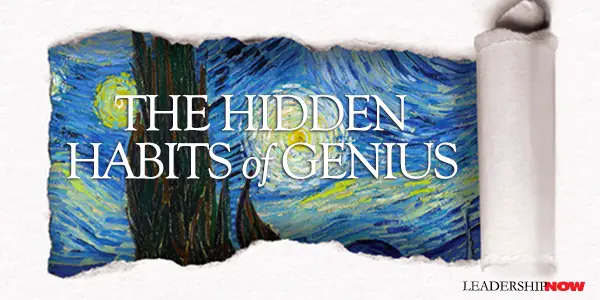
WHO and what is a genius? The label gets thrown around a lot. Are you a genius? Probably not. But then, most of us are not. However, you can learn to think like one. Craig Wright teaches a class at Yale on the nature of genius. He distills all of that work into his book with a hopeful title, The Hidden Habits of Genius: Beyond Talent, IQ, and Grit—Unlocking the Secrets of Greatness. Perhaps there is something we can learn from true geniuses that will help us perform better ourselves. I like the definition of a genius provided by German philosopher Arthur Schopenhauer: “A person of talent hits a target that no one else can hit; a person of genius hits a target that no one else can see.” Wright defines a genius as “a person of extraordinary mental powers whose original works or insights change society in some significant way for good or for ill across cultures and across time.” Geniuses work hard, but it’s not the hard work—the 10,000 hours of practice—that is the secret. “Practice may make the old perfect, but it does not produce innovation.” Talent may be the impetus, but hard work moves it along. To get to the top, it seems “you must max out both.” IQ tests can’t predict the next genius or a person’s potential. Some who have done well academically, like Marie Curie, Sigmund Freud, and Sergey Brin, went on to do remarkable things. But others we look up to today, like Einstein, Edison, Steve Jobs, and Picasso, did poorly in school. What about prodigies—young people who possess talents far beyond their years? Not really. “The difference is that geniuses create. They change the world through original thinking that alters the actions and values of society. Prodigies merely mimic. Childlike creativity plays a part. Picasso said, “Every child is an artist. The problem is to remain an artist as we grow up…. When I was a child, I could paint like Rafael, but it took me a lifetime to paint like a child.” “From Einstein’s mental play with images emerged his famous thought experiments. Einstein was able to imagine the world as a child while keeping apposite scientific information in mind.” Geniuses are lifelong learning addicts. “Students may receive information and learn methodologies in school, but the game changers of this world acquire the vast majority of what they know over time and on their own.” They learn what they need to know. What about passion? “If our passions drive us in ways that ultimately change society, that change is a mark of genius.” Not all passion leads to genius. Geniuses see things differently. They “cannot accept the world as described to them. Each sees a world asunder and cannot rest until things are put right.” Some geniuses are rebels, but not all rebels are geniuses—no matter how remarkable they may seem in the present. Some rebels, misfits, and troublemakers are just that. Not geniuses, but rebels, misfits, and troublemakers—people that just want their own way or push their own agenda. Wright correctly asks, “What is it that all of us believe today that some genius will disprove tomorrow?” We should be more careful pushing our biases and opinions. “Most rebels are not geniuses.” A person that changes the course of history need not be a genius, but rather someone who saw an opportunity and took it. Some people we presently regard as geniuses are clever and creative, but they are not geniuses. Aesop observed in his fable, The Fox and the Hedgehog, that “the fox knows many small things, while the hedgehog knows one big thing.” Wright says, be the fox. Develop a wide range of knowledge, perspectives, and skills. Cross-train. “The more broadly based the information in mind, the more likely that disparate ideas are combined.” Jeff Bezos observed, “The outsized discoveries—the ‘non-linear’ ones—are highly likely to require wandering.” “The lesson for all of us,” says Wright, “stay nimble.” Imagine the end and work backwards. Think opposite. Again, Bezos instructs: “You see a new technology, or there’s something out there, … and you work backwards from a solution to find the appropriate problem.” Wright says, “the more a person can exploit the contradictions of life, the greater his or her potential for genius.” To coax out your best ideas, relax. “If you need a fresh idea, go for a walk, or jog, or simply get into a relaxing conveyance so as to allow your mind to range more freely.” Then concentrate. Like a genius, “create a daily routine for yourself that comes with a four-wall safe zone for constructive concentration…. At the end of the day, you alone are responsible for synthesizing that information and producing something.” Could we use more geniuses? Well, yes. But what we really need are people who learn to think like a genius. Not the pandering and the misuse of statistics to push an agenda that has become so prevalent. We need people who will take a measured approach and contribute constructive ideas that will benefit the rest of us. 
Posted by Michael McKinney at 02:31 PM
08.21.20

Touching the Jaguar: How to Transform Your Fear into Action
FACING OUR FEARS is often what is standing between us and success. Touching the Jaguar is a cathartic memoir by John Perkins about confronting the things you fear to make the necessary changes in your life. In this memoir, he touches on the value of altering your perception to change your reality. It’s a valuable lesson expressed in a new way. While working in the Amazon, a shaman told him about touching the jaguar: The jaguar stands on a Perception Bridge “that could convey us from a reality based on preconceived ideas and values to a reality based on new ideas and values. If we are scared off by that jaguar, held back by things we’d been taught in the past or our fear of change, for example, we would not get past the jaguar and cross the bridge. If, on the other hand, we touched the jaguar, recognized the voices, teachings, values, or other barriers that stood in our way, confronted them and altered them, we are empowered to take the actions necessary to cross the bridge into a new reality.” We live with two realities. There is reality itself, and then there is what we perceive it to be. By crossing the perception bridge, we are taken to a new perspective. We can find compassion and empathy from other perspectives. We receive the energy to move forward and take positive action. We can ask what we might do to help others cross the Perception Bridge. By touching the jaguar, we are “recognizing that human reality is molded by our perceptions and that to change ourselves or our world, we must break through the barriers that imprison us in old ways of thinking and acting. If we run from or deny our fears, they will hound us. By confronting them, we take their power.” 
Posted by Michael McKinney at 12:01 AM
06.12.20

You’re It: The Call for Meta-Leadership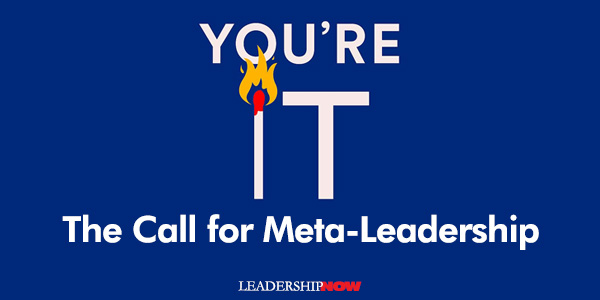
A crisis demands a certain kind of leadership. But crisis leadership is not something you turn off and on. The ability to handle a crisis is something you develop long before a crisis hits, and people turn to you for guidance—before they declare, “You’re it!” You’re It: Crisis, Change, and How to Lead When It Matters Most by Leonard Marcus, Eric McNulty, Joseph M. Henderson, and Barry C. Dorn, details the mindset of successful crisis leadership. They call it Meta-Leadership. The following excerpt describes well exactly what the authors are advocating. Meta-leadership is a strategy and practice method designed to expand the impact of your leadership. It is both conceptually rigorous and intensely practical. It guides being, thinking, and doing. What they are describing requires quite a shift in thinking and behavior from much of the leadership we see today. It speaks to the question, why do you lead? It requires an outward mindset rather than the underlying motivation of leaders wishing to win points for themselves. Crisis leadership is complex. Some responses may be linear in nature—a checklist of actions—but the meta-view is most often complex. An adaptive approach that acknowledges the evolving nature of situations and the ambiguity of the unknowns is fundamental to meta-view, inclusive leadership. To illustrate this point, they present the Cone-in-the-Cube illustration.
Two groups of people are assigned the task of describing a shape inside an opaque cube. One group looks through peephole A on the side of the box. They see a triangle. The other looks through peephole B on the top of the box. They see a circle. The two groups fall into conflict about what is in the cube, and each substantiates the validity of its claims based on professed superior experience, values, intelligence, or power. It is the job of the meta-leader to integrate both viewpoints and to help others see the big picture as well. A crisis compounds the problem because when people are fearful or in a state of panic, they become very rigid in their thinking. Meta-leaders need to respond to the emotion of the problem as well as the technical issues. In a crisis, we are programmed to take a narrow view and become tightly focused. When a crisis hits, the first thing that happens is your higher-level thinking shuts down, and you descend into the basement. When this happens, “extraordinarily smart people can go to the basement, get stuck in the basement, and say or do the dumbest things, often to their later regret.” The trick is to learn what you can do to bring you up out of the basement and out of survival mode. It can be pausing, taking a deep breath, or something you do that prompts self-confidence. To overcome that overwhelming feeling, it is good to pull back and provide some structure to the crisis and to guide your thinking and your response. The authors have developed a tool called the POP-DOC Loop.
Start at the top on the left side of the figure-8 and move counterclockwise: Perceive what is happening. Orient yourself to detect patterns and understand what they mean. Distinguish between what you think and what you know. Test for bias-driven blind spots. And then, based on the patterns and the probability of their recurrence, predict what is likely to happen next. These are the learning steps. They integrate the dimensions of the person and the situation. The meta-leader’s role is to keep their eye on the big-picture, delegate, and allow others to do their job—to connect and coordinate all of those involved in the response. They practice the principle of “stay in your lane and help others succeed in theirs.” Through your meta-leadership, you are seeking a wider perception and a deeper understanding of people, their experiences, and what affects them. That understanding—through connectivity—allows you to find patterns of behavior, reaction, and response. The intersection between what occurs in your surroundings and its impact on people becomes clearer. You take and guide actions in this broad human panorama. You’re It is a playbook for crisis leadership to be sure, with many examples from various crisis situations. But more than that, it will develop you into a leader that can act when a crisis strikes. The principles found here are not only valuable in an organizational setting, but the mindset will help you personally to think through a crisis with clarity informed by a mind open to various perspectives on the situation. 
Posted by Michael McKinney at 09:03 AM
06.08.20

How to Achieve Optimal Outcomes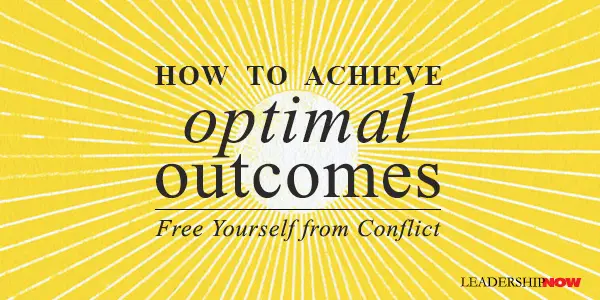
CONFLICT is inevitable. It is part of life. Some of it is good for us. We grow from it, it moves us forward, and it makes life more interesting. However, there is a kind of conflict the seems to reoccur no matter how hard you try to resolve it. And some of that becomes self-perpetuating as we react in ways that cause even more conflict. Jennifer Goldman-Wetzler calls a conflict loop. In Optimal Outcomes, she writes: What I’ve discovered is that when you are stuck in a conflict loop, you develop conflict habits, including blaming or avoiding others, blaming yourself, and relentlessly seeking “win-win” solutions even when other people refuse to cooperate. And your conflict habits interact with other people’s conflict habits to form a pattern of interaction that keeps you stuck in the conflict loop. Wetzler offers a set of eight practices called the Optimal Outcomes Method, that we can use to free ourselves from the habits and patterns that reinforce the conflict loop. The dynamic woven throughout each practice is the capacity to observe or pause to acknowledge the factors that have contributed to the conflict and then take a pattern-breaking action. Another key point is this: In reoccurring conflicts, we tend not to be very good at imagining what we want. Instead, we’re focused on what went wrong in the past and who is to blame. If we do think about the future, we tend not to look honestly at the reality we’re facing. The degree to which you are able to create an Optimal Outcome is determined both by your ability to imagine an Ideal Future and to acknowledge the reality of the situation and people you’re dealing with. Practices one through four help us to pause and understand a conflict situation and break out of the conflict patterns of the past. Practices five through eight will help you to exit the conflict loop. Briefly, the eight practices are: 1. Notice Your Conflict Habits and Patterns We begin by identifying and understanding our own conflict habits. Wetzler has identified four conflict habits: Blame Others, Shut Down, Shame Yourself, and Relentlessly Collaborate. What habit do you tend to gravitate to? She has provided an assessment to identify your primary habit on her website. Optimaloutcomesbook.com/assessment 2. Increase Clarity and Complexity: Map Out the Conflict When emotions run high, we end to see things in black and white. If we step back, we can see more layers to the conflict and better understand the nuances. With awareness comes possibilities. She introduces a practice called Conflict Mapping to help widen your perspective on the situation. 3. Put Your Emotions to Work for You How do you tend to express your emotions? When it comes to our emotions, we tend to fall into the Knee-Jerk Reaction Trap, the Inaccessible Emotions Trap, or the Lurking Emotions Trap. The way out is to pause and allow your emotions to settle. Calm, you can begin to understand where they are coming from and what messages they are sending you. Then take more constructive pattern-breaking action to represent better the message you want to send. If other people’s emotions are triggering you, remember they are dealing with their own emotions, too. 4. Honor Ideal and Shadow Values—Yours and Theirs We have ideal values that we share proudly and shadow values that we have pushed out of our consciousness because we’ve received mixed messages about them, but they affect our thinking and actions, nonetheless. We need to identify and understand both. Our shadow values tend o come out in words or actions in ways we don’t intend. Noticing the tensions between our own values is key to freeing ourselves from conflict with other people. Those inner tensions often prevent us from being clear about what we want in any given situation, which makes it impossible to be clear with others. Look for ways to close the gap between our ideal values and our behavior. “Considering others’ shadow values can enable you to develop greater empathy for them, which is likely to have a freeing effect on you. Thinking about others’ history will help you break free from the conflict loop.” 5. Imagine Your Ideal Future Your Ideal Future will help to pull you out of the conflict loop. In this step, don’t worry about how feasible it is. That will come in practice eight. Describe it in detail with enough clarity so that you are prepared to communicate it. The more emotions are involved in the conflict, the less likely that rationally derived solutions will solve the problem. 6. Design a Pattern-Breaking Path A Pattern-Breaking Path (PBP) is a linked, yet simple set of action steps that will help to push you out of the conflict loop. The PBP has three characteristics: it is surprisingly different, simple, and each action builds on the one before it. “Your PBP should compromise action steps that, one by one, will move you and others toward the Ideal Future you’ve imagined. Designing a path begins with you. “What can I begin with?” Then, “Who is the first person, if any, I will involve?” “Who else, if anyone, will I involve?” “Are there any groups that I can engage with?” and finally, “How will I build a path of linked action steps from here?” 7. Test Your Path When designing our Pattern-Breaking Path we tend to either “act recklessly, failing to think about the potentially unintended consequences of our actions” or “anxious about the potential consequences of our actions, we fail to think about the potentially dire consequences of inaction, and we take no action at all.” We do not think about the impact of our behavior on other people, and we almost certainly do not consider the potential impact of our behavior on ourselves or on others over the long term. Anticipate unintended consequences. Often, we assume that we are so right in our views and actions that rarely stop to consider other people’s perspectives. “To create the outcome you intend, begin by testing small patter-breaking actions in a safe environment, review your results, and adjust as needed.” 8. Choose an Optimal Outcome We may hesitate to initiate our Optimal Outcome for several reasons. For instance, it may not seem feasible. Freeing ourselves from the conflict by simply cutting ties and walking away is not feasible or has terrible consequences, or perhaps it is easier to do than your Optimal Outcome. And finally, there is the fear of change or ironically the comfort of the familiar—our new normal state of conflict. To work through this, you have to gauge the feasibility and the cost and benefits of other alternatives. 
Posted by Michael McKinney at 08:11 PM
04.20.20

We Live in A Downstream World
You and a friend are having a picnic by the side of a river. Suddenly you hear a shout from the direction of the water—a child is drowning. Without thinking, you both dive in, grab the child, and swim to shore. Before you can recover, you hear another child cry for help. You and your friend jump back in the river to rescue her as well. Then another struggling child drifts into sight … and another … and another. The two of you can barely keep up. Suddenly, you see your friend wading out of the water, seeming to leave you alone. “Where are you going?” you demand. Your friend answers, “I’m going upstream to tackle the guy who’s throwing all these kids in the water.” THIS metaphor sets the premise for Dan Heath’s book Upstream: The Quest to Solve Problems Before They Happen. We live in a downstream world. We have a bias for downstream action. We spend most of our time reacting to problems downstream rather than dealing with the source of the problem that is found upstream. Heath argues that “we should shift more of our energies upstream: personally, organizationally, nationally, and globally. We can—and we should—stop dealing with the symptoms of problems, again and again, and start fixing them.” That seems pretty obvious. So why don’t we? Time after time, we find ourselves reacting over and over again. Heath identifies three barriers to upstream thinking: Problem Blindness Problem blindness assumes that the problem is natural or inevitable, and there’s nothing you can do about it. And we shrug it off. “That’s just the way it is,” we conclude. So, we don’t try. “When we don’t see a problem, we can’t solve it. And that blindness can create passivity even in the face of enormous harm.” A Lack of Ownership Complacency. What problems do we see around us that we could fix, but don’t? Moving upstream requires that we take ownership of the issues personally. “I choose to fix this problem, not because it’s demanded of me, but because I can, and because it’s worth fixing.” Tunneling Tunneling is a condition where you find that “when people are juggling a lot of problems, they give up trying to solve them all. They adopt tunnel vision. There’s no long-term planning; there’s no strategic prioritization of issues.” When we are in a negative or scarcity mindset, we become “less insightful, less forward-thinking, less controlled.” Here are listed seven fundamental questions that upstream leaders must answer:
In clarifying these questions, Heath reveals some of the big issues through a wide variety of case studies that keep us from moving upstream. Part of what makes downstream efforts so popular is that the results are quite tangible. “Downstream efforts restore the previous state.” If my relationship is broken, and I fix it, the intervention was a success. If I do take preventative measures, I’m fixing what may or may not have happened. The issue arises, too, that I’m putting effort into something that is not broken. Is that necessary? We pay to fix problems, but we are not as keen to put money into preventing problems. “We can pay to fix problems once they happen, or we can pay in advance to prevent them. What we need are more businesses and social entrepreneurs who can figure out how to flip payment models to support the preventive approach.” There is uncertainty in fixing upstream problems, especially when they are not reoccurring. When preparing for a distant threat, it’s often difficult to tell if we are avoiding a disaster or preparing for something that will never happen. Is it worth the effort? “Organizations are constantly dealing with urgent short-term problems. Planning for speculative future ones is, by definition, not urgent. As a result, it’s hard to convene people. It’s hard to get funds authorized. It’s hard to convince people to collaborate when hardship hasn’t forced them to.” Heath asks, “How can you personally move upstream?” He recommends that we “be impatient for action but patient for outcomes.” We need to get moving, but often the change we seek takes time. Also, “macro starts with micro.” Break the action down. Get specific. And finally, “favor scoreboards over pills.” Think in terms of continuous improvement. “Data for learning” rather than “data for inspection.” Test and learn and test again. Upstream is a direction, not a destination. Any movement upstream is a step in the right direction. You can get a little ahead of the problem by or you can go further upstream and look for the more systemic issues. “When there’s a recurring problem in your life, go upstream.” When we don’t deal with problems upstream, we are destined to deal with them over and over again. 
Posted by Michael McKinney at 11:07 PM
04.06.20

Dealing with the Two Fronts of Every Crisis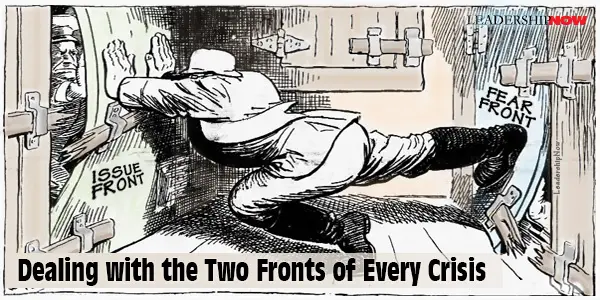
EVERY CRISIS places a leader between two fronts: Issue and Fear. Understanding the difference and managing both is key to dealing with a crisis successfully. There are different kinds of crises, but this dynamic applies to both types. There is the crisis where the issue is known, there is a procedure for handling it, and success in dealing with it comes down to proper execution of the solution. A “routine risk event” can be accompanied with fear, but it rarely evolves into panic as uncertainty is minimal. A true crisis event is different because we lack familiarity with it and there are, as crisis expert Harvard Business School Professor Herman “Dutch” Leonard puts it, “significant elements of novelty to it.” He says as there is no precedent for it, there is no playbook for handling it. There is no script for managing it. In a true crisis, you are faced with rapid, real-time innovation under stress “embedded in fear.” He adds, “That’s a fundamentally different kind of human challenge. It feels chaotic and unsettling, and that’s the way it always feels.” This is where we find ourselves now in April of 2020—a true crisis. The Issue Front A true crisis has many moving parts that lack connection. There is no playbook. Unlike a routine risk event where you have figured out in advance what the key issues are and which ones take precedence, in a true crisis event, you will often see, says Dutch, “competing priorities which you have never had to trade-off before. You have a whole bunch of things that are colliding simultaneously, and you haven’t necessarily had a chance—in previous experience—to sort out which is most important.” Dutch says what crisis management needs is not answers but an effective process. This idea is encapsulated in his phrase, “learning our way forward.” Because of this, we won’t get it right the first time. We simply don’t know. We might speculate, but we don’t know. In some ways, we are operating blind in a crisis, and this often generates a great deal of uncertainty and fear. We must learn to push through the fear and trust in the process. Dutch says organizations need to approach the crisis with a more “entrepreneurial, innovative, and forward-looking leadership stance and convene a process to solve these problems in real-time. The process consists of the people you bring together and the way they interact.” A crisis management team needs to consist of three categories of people. First, you need people who understand the goals and priorities of the organization so as to get all of the concerns out on the table. Second, you need people who know about the crisis. These can be people inside the organization, but depending on the nature of the crisis, more often than not, they will need to be credible people from outside the organization. And finally, you need people who really understand your organization—how it works—how things get done. Together these three groups of people can talk about what we care about, what is the actual situation, and how we as an organization fit into and relate to the crisis. This discussion helps keep everyone centered and serves as a guide to execution. Dutch notes that this team doesn’t get into problem-solving but is tasked with understanding the issues overall. The problem-solving is delegated but delegated in a way that none of the important issues are missed in finding a solution. A crisis calls for agile leadership. Select options, try them, get feedback, and try again—a problem-solving experimental approach. It is learning our way forward. “We are learning as fast as we can. We must avoid quick answers. We get better as we move along.” Leaders must have a learning-oriented, process-based mindset, and this thinking must be communicated to everyone affected by the crisis, to effectively deal with the Fear Front. The Fear Front The critical skill a leader must possess is the ability to separate the signal from the noise. It is the noise that generates the most fear. While there will always be some degree of anxiety, the fear that often leads to panic diminishes our ability to respond and to be patient in working out the response. Fear reduces clarity and trust in the process. We become gullible and self-centered. Fear cripples us. Here are several ways to help fight fear: Always Keep the Big Picture in Mind When dealing with a pandemic, The World Health Organization is concerned not only about the disease itself but the problem of combating the infodemic, which they define as “an overabundance of information—some accurate and some not—that makes it hard for people to find trustworthy sources and reliable guidance when they need it.” In The Signal and the Noise, statistician and New York Times contributor Nate Silver explains that “if the quantity of information is increasing by 2.5 quintillion bytes per day, the amount of useful information almost certainly isn’t. Most of it is just noise, and the noise is increasing faster than the signal. There are so many hypotheses to test, so many data sets to mine—but a relatively constant amount of objective truth.” Not that new evidence will never outweigh all other data and theories, it can, but we tend to “focus on the newest or most immediately available information, and the bigger picture gets lost,” writes Silver. This tendency narrows our view and sends our emotions into a downward spiral if not checked. Keeping the big picture in mind will help us to make measured choices and build trust in the process. Educate to Bring Clarity Leaders provide clarity by informing and educating people on what they know and how they fit into the issue. In the absence of credible information, people tend to gravitate to the worst-case scenario. In his first address to the nation since his Pearl Harbor address on December 7, 1941, Franklin Roosevelt was compelled to inform and educate the American people of the issue. He wanted to provide the big picture. He said, “I’m going to ask the American people to take out their maps. I’m going to speak about strange places that many of them have never heard of—places that are now the battleground for civilization. I want to explain this war in laymen’s language; if they understand the problem and what we are driving at, I’m sure that they can take any kind of bad news right on the chin.”
Roosevelt saw the morale of the American people as his responsibility. His intent was to drive out fear by education and consistent communication. The Crisis Industry—those journalists, politicians, and experts that seek to profit from a crisis—was alive and well in FDR’s time too, and education is the only way to combat it. Remain Steady Communicate the uncertainty. We don’t know, and that’s part of the process. There is a joke about the statistician that drowned crossing a river that was only three feet deep on average. Predictions can only be at best approximations based on current data, and even that can be manipulated if it is not placed in its proper context. All data exists in a relationship to other facts. Over time these relationships add clarity. As we gather more and more data, we come closer to the truth. Blame has no place in leadership. Blame is a form of panic. It is silly to blame others in a situation where the answers are not known, and opinions are rampant. Blame is not leadership; it is reactionary and only impedes the way to a solution. Look for the positive events in the crisis. It will help you to clarify and minimize, if not solve, the remaining negative issues. Make People Agents of Something Positive People’s anxiousness comes from the sense that things are out of control, and they have no capacity to direct the course of their lives. Leaders must speak to that anxiety, give hope, and pull the issues down to the realm of personal responsibility. What can I do now? In The Splendid and the Vile, historian Erik Larson shares that John Martin, one of Winston Churchill’s secretaries, wrote in his diary about Churchill, “Under his leadership Britons began to see themselves as ‘protagonists on a vaster scene and as champions of a high and invincible cause.’” Larson explains how Churchill helped people manage their fears at the beginning of WorldWar II: Recognizing that confidence and fearlessness were attitudes that could be adopted and taught by example, Churchill issued a directive to all ministers to put on a strong, positive front. “In these dark days the Prime Minister would be grateful if all his colleagues in the Government, as well as high officials, would maintain a high morale in their circles; not minimizing the gravity of events, but showing confidence in our ability and inflexible resolve to continue the war till we have broken the will of the enemy to bring all Europe under his domination.” Fear is contagious and has an exponential effect. Nigel Hamilton writes in The Mantle of Command, that FDR felt, “A leader must exhibit confidence since the slightest hint of anxiety or dejection would spread like ripples in a pond.” When we deal with the crisis with a positive expectation and manage the fear, we open ourselves up to possibility, opportunities, and self-efficacy. The crisis will past, of course, but our experience of it and our success in solving it depends on how we respond to it and manage the fear. As leaders, how can we become beacons of hope for our families and organizations? To help people embrace the future and not the past?
Posted by Michael McKinney at 03:31 PM
03.30.20

What’s Your Problem?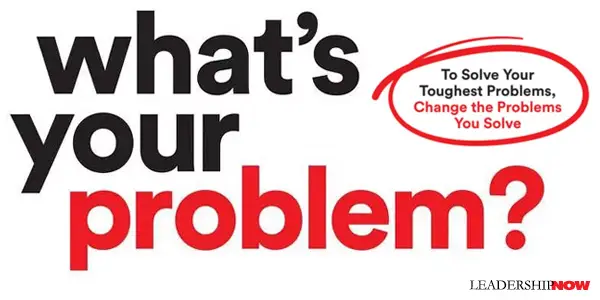
WE HEAR A LOT about reframing, but do we actually do it? True. We get busy, and we start looking for a solution without first analyzing the problem. We want a quick solution so we can move on. And we “solve” the wrong problem. Reframing helps us to avoid this. Reframing helps us to see solutions that we would otherwise not see, as we see the issue from different angles. Sometimes the process of reframing leads us to discover that what we thought was the problem is not really the problem at all. It is a symptom of the problem. Solving for symptoms locks us into a perpetual crisis loop like a hamster on an exercise wheel. We end up with laws and rules that solve nothing because we’re solving the wrong problem. Thomas Wedell-Wedellsborg helps us get a handle on this reframing skill in What's Your Problem?: To Solve Your Toughest Problems, Change the Problems You Solve. “Sometimes,” writes Thomas, “to solve a hard problem, you have to stop looking for solutions to it. Instead, you must turn your attention to the problem itself—not just to analyze it, but to shift the way you frame it. Reframing is not necessarily about the details. It is more about seeing the big picture and having the ability to consider situations from multiple perspectives.” Reframing There are two different ways of reframing a problem: exploring the frame and breaking the frame.
When exploring the frame, you’re looking for aspects of the issue that you might not have considered. “Breaking the frame is when you step away completely from the initial framing of the problem.” It is the more important of the two skills because “if you don’t master it, you will get trapped by the initial framing of the problem.” Thomas provides several examples that help you to see reframing in practice. Reframing, says Thomas, is like a loop off of the straight-line path to a solution. It is “a brief, deliberate redirection that temporarily shifts people’s focus to the higher-level question of how the problem is framed. It results in getting back on the path with a new or improved understanding of the problem.” Problems present themselves in three ways: “an ill-defined mess or pain point, a goal we don’t know how to reach, or a solution someone fell in love with.”
How to Reframe Thomas introduces a method we can use on any problem that we face. No problem is too big or too small. He recommends that we “modify the reframing process to fit the size of the problem.” In other words, you can either use all seven steps in the process or scale it down according to how much time is available. “You don’t necessarily have to stick to the sequence. When solving problems as part of a quick workplace conversation, feel free to jump straight to the particular strategy that seems most promising given the problem at hand.” Complex problems take more time to reframe, but some can be reframed in as little as five minutes. The important consequence of understanding this process is that you become more curious and intentional with problem-solving. You begin to ask questions instead of just jumping to a solution.
Here is a brief overview without all of the insightful and instructive examples: Frame the Problem Look Outside the Frame Rethink the Goal Examine Bright Spots Look in the Mirror Take Their Perspective Research has shown that people focus too much on their own perspective when trying to understand others. Try to disregard your own preferences. Focus only on how they might feel and think. Move Forward Thomas also offers some approaches when dealing with people who resist the process and those who are in denial. What’s Your Problem? is the most thorough and practical book you’ll read on this critical habit of problem-solving and thinking well. Well-illustrated, and full of clarifying examples, he teaches you how to reframe any issue you encounter in either your personal or professional life. On the What’s Your Problem? website, you can find a Reframing Worksheet and Checklist, and other useful downloads. 
Posted by Michael McKinney at 06:20 PM
02.21.20

All You Have to Do Is Ask
IF WE ARE HONEST with ourselves, we know there are times we need help. We just don’t want to ask for it. We’re confident we can figure it out. In time. But here’s the thing. There’s nothing we are going through or trying to figure out that others haven’t blazed a trail for us already. We just need to ask. Wayne Baker says, “you never know what people know—or who they know—until you ask. Asking for help can mean the difference between success and failure.” In All You Have to Do Is Ask he identifies eight reasons why we don’t or won’t ask. As a result, we leave a lot of answers, solutions and resources on the table for no good reason. And here are eight no good reasons:
That last reason—the fear of seeming selfish—relates to the proverb that it’s better to give than receive. That’s true. We want to be givers, but that doesn’t make receiving a bad thing. “There’s no giving without receiving, and there is no receiving without giving. And it’s the request that starts the wheel turning.” Baker offers a quick scientific assessment in the book (or online) to determine what style of asking/giving you tend to choose. And it is a choice. Are you an overgenerous giver, a selfish taker, a lone wolf, or a giver-requester? These types all represent “choices you can make about how you want to operate in the world.”
The place to begin is to understand and articulate your needs. Know what you are trying to accomplish and when. With that in mind, formulate a SMART request. That is a Specific (“a specific request yields more help than a vague one”), Meaningful (“Why is the request important to you?”), Action-oriented (What action do you want to be taken?), Realistic (it may be a serious long-shot, but within the realm of possibility), and Time-bound (“every request should have a due date”) request. After you have formulated your request, you need to figure out who to ask. Who knows what you need to know or who you need to talk to? Go outside your usual circle of contacts. Then ASK. And a good piece of advice: “Rejection is just an opinion. And opinions change. In other words, you can find ways to turn a no into a yes.” Baker offers much more specific advice and examples throughout but let me mention two tools that have proven effective that Wayne Baker and Adam Grant have developed. The first is Reciprocity Rings. Reciprocity Rings A Reciprocity Ring is a group activity consisting of 20 or so people that gather together and share a request with the group one by one. “Other members of the group pause to consider how they could help: Do I have the resource the person needs? Of not, do I know someone in my network who might be able to help? Because it’s much easier for people to make a request when they know that everyone must make one, every participant is required to make a request; asking is the ‘ticket of admission’ to the Reciprocity Ring.” Reciprocity Rings have been implemented successfully at Google, General Motors, IBM, Citigroup, UPS, and others. Givitas Givitas is a collaborative technology platform that provides a safe platform for requesting, giving, and receiving help across boundaries across a vast scale. It helps you share widely beyond the usual suspects. Platforms like Givitas allow people to get what they need without having to repeatedly tap all the same experts or all the usual go-to people because requests are decentralized and broadcast across the vast network. Thanks For Asking We’ve all asked for help only to be rebuffed or made to look stupid. Of course, we recognize and reward people for giving help, but we don’t typically reward people for asking for help. “How our request is received, how we are treated, and how the help is granted determines whether we get discouraged, or encouraged to make asking a personal practice.” With both organizational and individual success at stake, we need to rethink our responses to asking. “Recognizing, appreciating, and rewarding those who ask is as critical as doing the same for those who answer.” Baker shares informal and formal ways we can as individuals and organizations recognize, reward, and encourage asking. Asking improves individual performance and effectiveness. All You Have to Do Is Ask will change your appreciation of asking. It certainly changed my view. 
Posted by Michael McKinney at 05:34 PM
02.14.20

Think Outside the Building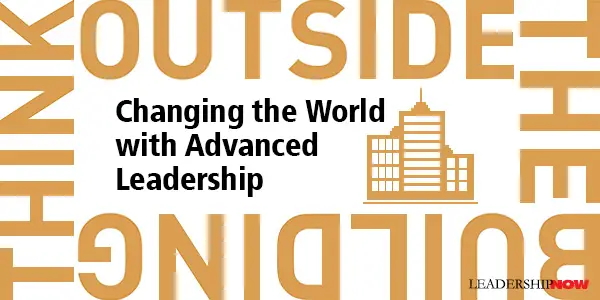
SYSTEMIC SOCIAL ISSUES cannot be solved by a few people working in isolation. They can be better addressed by breaking out of traditional approaches and collaborating with others. Rosabeth Moss Kanter likens these traditional approaches to castles. In Think Outside the Building, she writes, “Castles are any set of institutional structures that loom large and feel permanent. Castles are monuments to the past and to past thinking, museums of preservation.” Moving outside of these castles is the beginning of innovation. For example, “health is equated with hospitals, education with schoolhouses, news with newspapers, spirituality with the church, a city with city hall.” And we look to these institutions for solutions. But the solutions lie outside the “castle.” Health isn’t the hospital or even the doctor’s office. Health might be a function of nutritious food, clean air, or stress-free work. But behemoth establishments dominate health care, including rival fiefdoms such as providers and insurance companies, full of fortification and defenses, sometimes shutting out alternatives for treatment or blocking routes to wellness. The same can be said of educational systems, city governments, and other institutions that we look to for answers. Kanter says the best way to deal with these entrenched systems is not to attack them head-on, but to go around or under, or even start something new that is so attractive that others flock to it. Advanced Leadership To encourage this kind of action, professors Kanter, Rakesh Khurana, and Nitin Nohria co-founded the Harvard Advanced Leadership Initiative as a third level of education to bring together experienced leaders who could then go and address some of the world's most challenging problems. But the Advanced Leadership is not specifically about older, more experienced people, but a level of thinking that takes leaders of any age, out of the building, “beyond boundaries, across silos, and outside established structures.” Advanced Leadership is a different mindset than single-minded leadership furthering its own goals within a single organization. “Complex, messy, ambiguous, contentious institutional problems require more of leaders than exercising the authority inherent in their roles; they take entrepreneurial hustle. That also requires a larger pool of leaders willing and able to tackle them.” We need more Advanced Leaders. Kaleidoscope Thinking A different kind of thinking—kaleidoscope thinking—is required. “Creativity is a lot like looking at the world through a kaleidoscope. Innovators shake up their thinking as though their brains are a kaleidoscope, permitting an array of different patterns out of the same bits of reality. Leaders who take on big, intractable systems problems must be able to break out of prevailing wisdom in order to move beyond it. The fragments of your kaleidoscope as built over time. Experiences, frustrations, and observations waiting to be connected when the time is right. Digital innovator John Taysom said, “Dream your worst nightmare, then invest in it,” or “see the thing that upsets you and use it as an opportunity for change.” Get out and experience the new and truly different to shake the kaleidoscope into new possibilities. “What differentiates advanced leaders from noninnovators is that they can see further because of their quality of preparation and attention. They zoom out to see the big picture; they tune in to the context and read the zeitgeist.” Advanced leaders are always looking. Look for what’s not there. Look for the gaps. Advanced leaders must learn to tell a different story in order to gain support. “If you don’t like how things are going and want to lead change, tell a different story.” Reframe the problem to illuminate possibilities. Stories can’t be fairy tales. Narratives should be evidence-based, meeting a plausibility test. Marshalling the evidence sometimes requires creating new evidence through pilot programs—something that people can see and touch, something that has “street cred” (visible on the street. Prototypes are fundamental. Kanter explains the need, the process, and the trials of advanced leadership in the face of “castles” through example after example of those who are outside the building trying to make a difference. It is an instructive and inspiring book. It is a call to action into the unknown with a distinguished guide. The nature of change challenges, whether inside corporate offices or beyond the walls, increasingly requires more than traditional hierarchical leadership skills guiding teams inside the building; the new challenges require advanced leadership. For institutions that are threatened with disruption and displacement, this kind of leadership is essential because they simply can’t keep singing variations of the same old refrains with a digital note added here or there. And as the routinized parts of jobs are replaced (or augmented) by technology, increasing numbers of people will find themselves working on tasks outside the building. 
Posted by Michael McKinney at 06:48 AM
12.23.19

9 Lessons from Henry Ford’s $5 Day Decision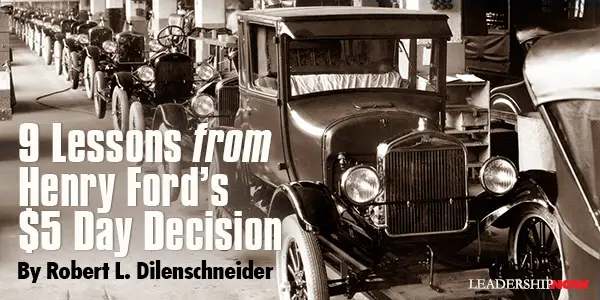
Any decision you make isn’t worth a tinker’s damn until you have formed the habit of making it and keeping it. IMAGINE that this is your situation: Your young company is a raging success. Its product, a simple one that can be produced easily because of a manufacturing process that you invented, is wildly popular. Then imagine that this is your problem: You have to replace your workers three or four times a year. Your great manufacturing process is driving your employees away. They can’t tolerate it! What would you do? Anyone who runs a business knows that a high employee turnover rate is . . . well, bad. The ability to attract and retain employees is key to longevity and success. How long can a business survive if its entire workforce turns over three or four times a year? As someone who has run his own business for over twenty-five years, I have many thoughts on this question. If my business had such a high employee turnover rate, do you think it would occur to me to double my employees’ wages? That’s what this particular business owner did. His name is Henry Ford, and we all know what the Ford Motor Company is. Maybe you bought one of the 2.5 million vehicles that Ford sold in the US last year. Let me set the scene, and then talk about the decision Ford made to save his company—a business decision that Fortune magazine said is the “greatest” of all time. Henry Ford founded his company in 1903 to manufacture vehicles for the “common man.” The automobile itself had already been invented—the adage “success has many fathers, but failure is an orphan” comes to mind, as there are several “fathers” of the first car (in fact, it was probably the German Karl Benz in 1885 or so). But in 1903, automobiles were an elite product. Only the rich could afford them. They were hand-built, often to personal specifications. They were also very heavy, as they had to withstand the rigors of mostly unpaved roads used by the horse-and-wagon mode of transportation. Though his was not the only automobile company, Henry Ford had some key early insights. He simplified the design and construction of the automobile, narrowed the choices available (“any color you want, so long as it’s black”) and marketed it toward what we would today call the “down market.” And as the American road system improved because more people were driving cars, the cars themselves could become lighter, a fact that Ford took advantage of. In 1913, Ford took a huge leap forward. He abandoned the traditional hand-building process that involved each worker performing a number of different tasks to put a car together. That was inefficient! Especially when demand for Ford’s products was ballooning — workers could not work fast enough. Instead of having the car-in-process stay in one place on the factory floor, with workers walking around to different locations to get what they needed and then walking back to the car, Ford instituted the “assembly line.” The car-in-process would be dragged or pushed or otherwise conveyed along a line. Workers would stay in one place, performing one task. Upon completion, the car would move along to the next group of workers, who would perform another task. Revolutionary! More efficient! And, at first, easier on the workers. But workers began to lose the sense that an entire car was emerging under their hands. Doing the same task over and over was not as satisfying. And as assembly-line technology improved, so too did its speed, which soon became a source of great stress. The workers could hardly keep up. And thus was born the problem of high employee turnover. Almost as soon as they learned what to do on the job, workers decided that they did not want the job. Only a year after Ford’s revolutionary invention, it was obvious that the assembly line had a huge unforeseen downside. Ford’s company was in a precarious position. The cost of finding and retraining workers was becoming crippling. The efficiency that was the promise of the assembly line could not be sustained. Both revenues and profits were beginning to decline. It’s interesting to me that Ford’s solution was not to change the nature of the assembly line. As I noted at the very beginning of this chapter, Henry Ford both made and kept to his decisions. We have seen this trait in other key decision-makers. Ford believed in his invention. But his invention depended on human beings, not robots (remember, this was 1914). If Ford’s employees were not thriving, then he would have to change the conditions under which they worked. Make the conditions more attractive. Raising pay was the obvious first step. “The $5 Day” came at a time when most assembly line workers were making about $2.50 a day. This wage-doubling was not arbitrary. Ford and his advisors determined that anything less would not be an effective incentive, and anything more would begin to depress profits. An additional $2.50 was the sweet spot. A related initiative was the three-shift per-day schedule (rather than two), which opened up more actual jobs. The “$5 Day” not only solved Ford’s immediate problem. Deceptively simple, his decision also sowed the seeds of the culture of consumerism that pervades, even defines, our lives today. For good or ill. That’s why Fortune’s editors named it as the ultimate in their 2012 book The Greatest Business Decisions of All Time. Earning $5 a day, Ford’s workers could finally afford to buy that Model T they were making. Henry Ford was nothing if not a visionary, iconoclastic, and decisive businessman. Even early in his career, he possessed those qualities, and his reputation only grew throughout his lifetime. Today, seventy-two years after the founder’s retirement and seventy years after his death, Ford is one of the great companies of our time. Do you think Henry Ford, as astute as he was, had any inkling what his 1914 decision to double his workers’ wages— in today’s parlance, to pay his workers a living wage—would mean? 9 Lessons Here are the top lessons I take from Henry Ford’s $5 Day decision that can apply to us:
 
Posted by Michael McKinney at 07:56 AM
10.03.19

7 Steps to Bulletproof Problem Solving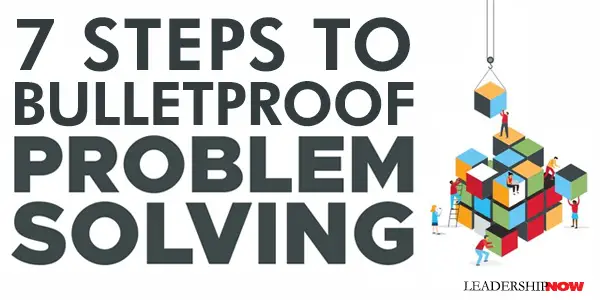
THE WORLD ECONOMIC FORUM’S Future of Jobs Report lists complex problem-solving as the number one skill for jobs in 2020. Organizations are looking for people that can define problems and form solid creative responses. Like leaders themselves, good problem solvers are made, not born. Yet these skills are rarely taught. That’s where Bulletproof Problem Solving comes in. McKinsey alums Charles Conn and Rob McLean teach us how to be bulletproof problem solvers using a simple 7-steps approach. The approach has its foundation in the hypothesis-driven structure of the scientific method. This process is not just applicable to business but is useful in finding solutions for personal problems as well. In the book they apply the process to individual problems such as, “Should I put solar panels on my roof?,” “What career should I choose?,” and “Is where I live affecting my health?” Business examples range from “Should my startup raise its prices?” and “Should we go to court?” to “Can obesity be reduced?” This process can be applied to nearly every problem is responds well to the systematic problem-solving method that this approach provides. The Seven Steps to Bullet-Proof Problem Solving are: Step One: Define the Problem
Step Two: Disaggregate the Issues
Step Three: Prioritize the Issues, Prune the Tree
Step Four: Build a Workplan and Timetable
Step Five: Conduct Critical Analyses
Step Six: Synthesize Findings from the Analysis
Step Seven: Prepare a Powerful Communication
While this is presented in a linear way, the authors make a great point that you learn more about the problem as you go. You shouldn’t be so eager to get to the end that you don’t go back and refine previous steps. “While the process has a beginning and an end, we encourage you to think of problem solving as an iterative process rather than a linear one. At each stage we improve our understanding of the problem and use those greater insights to refine our earlier answers.”

Posted by Michael McKinney at 04:30 AM
06.13.19

Cracking Complexity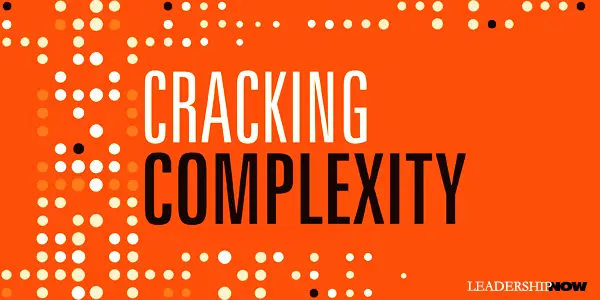
THERE ARE complicated problems, and there are complex problems. Complicated problems are technical in nature. They are linear, orderly, and predictable. Complex problems are adaptive challenges. They are messy, unstable, and unpredictable. “Having a wedding is complicated; having a happy marriage is complex.” If you want to crack a complex problem, you need the code. David Benjamin and David Komlos provide the code in Cracking Complexity. We can master highly sophisticated technical and technological challenges because we’re quite skilled at making linear connections from one technical feat to the next. But complex, multidimensional challenges are categorically different. They are not linear. They are not solved or even solvable through technical prowess. They don’t stand still. They don’t patiently await solutions. Complexity is a whole different ball game. The question is, “How can we best deal with something we’ve never dealt with before, without foreknowledge of what’s going to work?” Conventional approaches to problem-solving typically rely on small groups of smart people cloistered away tasked with deciding the best way forward. We need a new approach to complex problems that allow us to cocreate in large groups. The Complexity Formula A foundational idea behind the formula is Ashby’s Law or the Law of Requisite Variety which states: Only variety destroys variety. “Ashby’s Law says you need to bring a matching amount of variety to the solving process.” In other words, a high-variety group that can collectively address the variety inherent in the issue to be solved. The Complexity Formula helps you to unlock the skills, knowledge, experience, and expertise of the people around you. All the steps in the Formula are complementary and build one upon the next to deliver rapid leaps on complex issues. The first five steps set things up. Steps six through nine are where a requisite-variety of people can spend a short amount of time—typically two days—to sense, absorb, think, decide, and then in Step ten to act on the complex problem. Listed below are the ten steps with some key thoughts on each: 1. Acknowledge the Complexity The first step is to determine exactly what kind of problem you are faced with. A complicated problem or a problem that is truly complex. The first step is “recognizing that there are no known answers, that no outsourced provider is going to figure it out for you—at least fast enough—and that the old way of figuring things out isn’t going to work anymore.” 2. Construct A Really, Really Good Question Frame the issue with a good question. A complex issue needs a question that addresses the complexity. “A good gut check on the question is how people react to it. Are they uncomfortable with it because it challenges the status quo, sets the bar high, or suggests a lot of work needs to be done? Conversely, are they completely comfortable with it because it’s easy to answer? Don’t necessarily retreat from what you think is a good question because people are reacting negatively, and don’t be satisfied if people aren’t pushing back.” Example: “What must we do in the next 12 months to drive necessary changes in mind-set, action, and behavior to fully realize the benefits of…?” 3. Target A Requisite Variety of Solvers Involve the right people. Identify the requisite variety of people needed to match and absorb the complexity. “Your goal is to include the necessary perspectives, characteristics, roles, functions, hierarchical levels, and so on. If you shortchange requisite variety, you’re setting yourself up for no or partial solution and weak execution.” The authors provide a system to be sure you’re getting the right people together. 4. Localize the Solvers Get everyone together face-to-face. It allows for neural synchronization. In Google’s team study, they found what distinguished high-performing teams from low-performing teams is not team cohesion, motivation, or average IQ, but rather frequent turn-taking in conversations and high social sensitivity toward what team members are thinking and feeling. 5. Eliminate the Noise Noise takes all forms: “too much information all at once; too much wrong or inaccurate information; and too much missing, ambiguous, unreliable, or fragmented information.” They recommend that we “Err on the side of too little research, too little data, information, and knowledge—invest the effort instead in the requisite variety of people who carry the tacit data banks and the powerful processors around between their two ears.” 6. Agree on the Right Agenda Do not preset the agenda. Once you get everyone together, begin by deciding what to talk about. “Let the group decide what they have to talk about in order to answer the question. Their first task together is agreeing on how to deconstruct the question into the right component parts to discuss.” 7. Put people On A Collision Course A highly engineered conversation—engineered serendipity. “Serendipity often happens where people, domains, and/or systems collide. And collisions can be engineered. When we talk about domains and systems colliding, we mean people from one domain or system bumping into people from another domain or system.” 8. Advance Iteratively and Emergently You must trust that the answers will emerge. “Your requisite variety group needs to operate with energy and an expectation that the right answers will arise from the right kinds of interactions together.” Also, “Having set their agenda, your group needs to go through that entire agenda once, then again, then again.” Three times is the number—more yields diminishing returns. 9. Change How People Interact Nothing will happen if the interactions between your group members are not productive ones. To be effective, they need to be “candid, incisive, unconstrained, unguarded, transparent, fierce, and focused.” That requires, “discipline and structure, right-sized teams (no more than 8), effective conversation roles, and environment where productive friction is expected and not frowned upon, and have a neutral note taker.” 10. Translate Clarity and Insights into Action “The actions that result from the use of the Complexity Formula fall into three categories: Things to do, things to try, and the newly revealed complexities.” The job in step ten is to categorize the solutions in the three categories and then to attack “each pile in the right way to make progress, to continue learning, and to get after the next big challenge.” Sometimes working on one complexity reveals yet another complexity that needs to be resolved. 
Posted by Michael McKinney at 05:03 PM
06.07.19

How to Tackle Big Challenges in A Networked World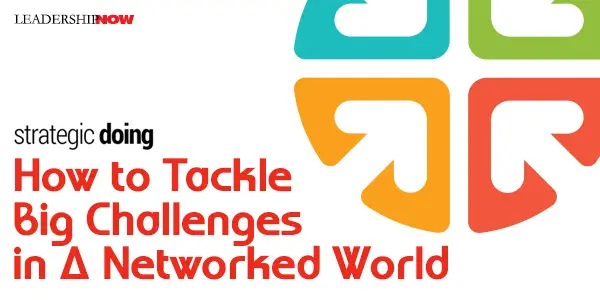
TACKLING THE BIG CHALLENGES when there is no single, simple, rational answer can rarely be done by a single individual or company working alone. Certainly, this is true when facing global, national, or community issues, but it is increasingly true within organizations and small groups. When faced with complex problems, we tend to find a rational answer by analyzing increasing amounts of data and polling for opinions and then announcing the answer to those who must follow. It’s a rigid approach to strategic planning. We need an agile approach that leverages all of the cognitive diversity available to us. In a networked world, the question becomes. “How do you design and guide complex collaborations in open, loosely connected networks when no one can tell anyone else what to do?” Without going into a critique of society, this has become a major concern across a wide range of organizations and institutions. To answer this question, Ed Morrison and his Strategic Doing team* have designed an agile approach to strategic planning that they present in their book, Strategic Doing: Ten Skills for Agile Leadership. Good strategy answers two questions: Where are we going? and How will we get there? The answers to these questions will provide you with an effective strategy, but by themselves, they don’t inspire the engagement that is sorely needed in our time. Strategic Doing divides these two questions into four questions: What Could We Do? and What Should We Do? to provide destination. Then to answer the how we have What Will We Do? and finally, What’s Our 30/30?
These questions encourage networking and real collaboration—“linking, leveraging, and aligning resources in ways that enhance one another’s capacity to create a shared outcome, a mutual benefit.” In telling example, a civic group came together and implemented Strategic Doing concluding, “Strategic Doing broke our grant addiction.” They were able to come together and identify and unlock assets so that the sum was greater than the parts. In a hierarchy, the challenge is to communicate information about what to do down, and to get information about the results up. The Strategic Doing method contains a set of ten skills that work within the framework of the four strategic questions. “Complex collaborations emerge when we follow a small set of simple rules. These rules—really, just the implementation of each of the skills—embed a lot of practices that academics have found valuable in a wide range of academic fields.” The ten skills themselves encourage collaboration as no one person is good at all ten. Transformative results can happen when you enlist a diverse team to bring each of these skills to the network. The Four Questions of Strategic Doing Skills 1 and 2 begin the process by setting the stage for productive, collaborative conversations. Skill 1: Build a safe place for deep and focused conversations. An agile leader will communicate and reinforce equity of voice and the commitment to behave in ways that build trust and mutual respect. Keeping the group size small—5 to 7 people—can also increase our chances of success. Skill 2: Use an appreciative question to frame your conversation. “We live in the world our questions create. We spend time developing framing questions to assure we are all in the same world, as it were—looking a closely as can at the same conversation.” So, we need to define the issue with an asset-based, personally meaningful question that has many answers to encourage people to reflect and think. Question 1: What Could We Do? Skill 3: Identify the assets at your disposal, including the hidden ones. There are assets that team members have control or influence over, but there are also assets that people don’t even know they have. Often these must be coaxed out by others in the group as we all too often, undervalue what we bring to the table. These can include hobbies, skills, and interests that someone has pursued independently over the years. Skill 4: Link and leverage your assets to create new opportunities. Connecting assets allows us to think horizontally. That is, to combine assets from different discipline, fields, or bodies of knowledge. It’s thinking together and extending our minds. Question 2: What Should We Do? Skill 5: Identify a big opportunity where you can generate momentum. Deciding which option has the greatest chance of success is not easy. The authors suggest a 2x2 matrix that considers two criteria to draw out better thinking from the group. Skill 6: Rewrite your opportunity as a strategic outcome with measurable characteristics. At this stage, you are trying to define a shared outcome that everyone can agree on and see in their mind’s eye. It must be emotional, or people will not move on it. It’s not a vague vision statement. The authors suggest asking three qualitative questions to draft an agile strategy: If we are successful, what will we see? What will we feel? and Whose lives will be different and how? Then name ways you might measure the outcome so that you can be sure that everyone understands the outcome in the same way. Question 3: What Will We Do? Skill 7: Define a small starting project to start moving you toward your outcome. You’re not looking for the perfect plan here; you’re looking for action. A small step towards your outcome keeps you from becoming overwhelmed. You don’t need the whole path laid out before you do anything. You just need to begin—and learn as you go. “We really can’t learn how to make progress toward that outcome until we start doing something.” Four qualities of a good start are first, short enough. They engage everyone on the team. The create buzz, garnering attention for the work. They test some key assumptions. And finally, they don’t require permission. Skill 8: Create a short-term action plan in which everyone takes a small step. No spectators. Make sure everyone on the team shares the responsibility for implementation. Question 4: What’s Our 30/30? Skill 9: Meet every 30 days to review progress, adjust, and plan for the next 30 days. Without feedback, we easily get off-track. “Agile leaders need a specific kind of feedback loop: a learning loop.” Change is inevitable, so we need to make adjustments along the way. What are we learning? Does everyone still agree with the outcome we are after? Do we need to make changes? The 30/30 is a guideline 30 days look back and a look forward to the next 30 days. You may need to shorten the timeline to 7/7 or perhaps longer. Skill 10: Nudge, connect, and promote to reinforce your new habits of collaboration. Establishing new habits and making changes are not easy. Agile leaders provide guidance. “If it is vaguely assumed that the network will thrive on its own, it won’t.” Agile leaders nudge everyone to move ideas into action and complete their tasks. They strengthen their network by connecting new people and other networks to it. And they promote it by publishing the successes. These ten skills implemented within the framework of the four questions will create conversations that can lead to transformative change. The four questions are a cycle that you return to again and again to build on what you’re learning by doing and to refine your strategy. *Edward Morrison, Scott Hutcheson, Elizabeth Nilsen, Janyce Fadden, and Nancy Franklin 
Posted by Michael McKinney at 03:56 PM
04.29.19

16 Rules for Effective Decision-Making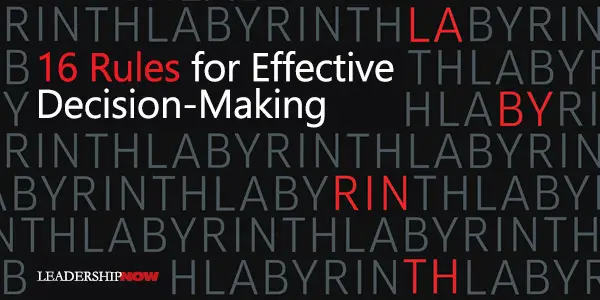
WHERE WE GO in life is determined by the choices we make. How we make those decisions becomes critical. The speed of change, the abundance of choices, the unknown unknowns, and the impact of a connected world, all conspire to make decision-making a labyrinth. We face traps everywhere. In Labyrinth: The Art of Decision-Making, Pawel Motyl examines “The most prevalent weak spots in decision-making processes, not only in business but in life in general; during crisis and calmer times; in both individual and group decisions.” I agree with Motyl that “We really do live in a world where everything is out of whack and everything we thought we knew is being called into question.” It calls for a deeper look at not just what we think, but more importantly how we think and a clear understanding of how we got there. Motyl digs into the series of decisions that led to some of the modern world’s most dramatic events: from the Cuban missile crisis to the 1996 Mount Everest climbing disaster; from the Apollo 13 rescue mission to the ill-fated Daimler–Chrysler merger. Using many and varied examples Motyl reveals 16 rules for effective decision-making. The rules with the accompanying narrative are well-researched and intriguing. Here is the overview: Rule #1
Rule #2
Rule #3
Rule #4
Rule #5
Rule #6
Rule #7
Rule #8
Rule #9
Rule #10
Rule #11
Rule #12
Rule #13
Rule #14
Rule #15
Rule #16

Posted by Michael McKinney at 09:06 AM
04.15.19

5 Insights to Managing Chaordic Tension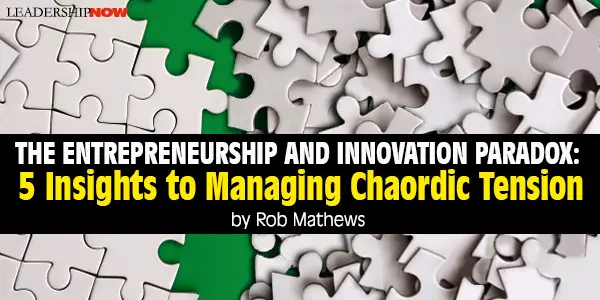
CONDUCTING your own orchestra. Running your own ship. Self-employment. Putting your stamp on the world. Entrepreneurship is a great, noble profession. However, failure rates are well documented. According to the Small Business Administration, about half of all businesses fail within five years (PDF). Some statistics show even higher failure rates. Are entrepreneurial endeavors really that risky? The answer is complicated. Intuitively, yes, entrepreneurship is a risky career path. But on the other side of that equation is the influence of sound business practices, planning, due diligence, and adaptability on business success. I’ve coached literally thousands of entrepreneurs in my twenty years in higher education and the business world, and have owned multiple businesses during that time. Between my research and that experience, I’ve developed some insights into what makes a venture a success or a failure. Visa’s founder, Dee Hock, coined the phrase chaordic tension to describe the tug of war between order and chaos in organizations. Managing this tension is the key to success in growing and stable organizations—regardless of industry, size, years in business, or profit motive. Here are my five insights on how to manage chaordic tension: 1. Idea people are more comfortable with risk. I’m a big believer in the power of assessments. One of the assessment tools we use a great deal is the Basadur Innovation Profile. This instrument measures one’s preferences for engaging the innovation process. The results are presented in a four-quadrant model. People who prefer to use the information to come up with ideas (generators and conceptualizers) are on the right side of the vertical axis. These individuals are comfortable with ideas, ambiguity, and keeping their options open. Not surprisingly, our research indicates generators and conceptualizers are generally not all that scared of entrepreneurial risk and thus reported higher intentions to start an entrepreneurial venture. 2. Evaluative people can execute and sustain ventures. According to the Basadur Innovation Profile, people who prefer to use information to judge or evaluate (optimizers and implementers) in the innovation process are on the left side of the vertical axis. These folks tend to frustrate the idea people, but their logic and sense of urgency to perform help entrepreneurs accomplish their dreams. As you can imagine, according to our research, evaluative people are much more hesitant to take risks, and thus report much lower intentions to start a new venture. This is where it gets interesting. We’ve also found that these evaluative types become much more comfortable with new ventures after creativity training and a better understanding of the ideation process. Not surprisingly, they also report higher intentions to start a business, or at least increased comfort with joining an entrepreneurial venture. They tend to like imaginative ideas. The important lesson here is that building cognitively diverse teams—who develop respect for and appreciation of their evaluative/ ideator opposites—is a key to success. The balance maintains company vibrancy while also advancing the business. More on these concepts in insights 4 and 5. 3. Assumptions and the value propositions must be validated—and developed accordingly. As with most things in life, a little humility goes a long way, particularly when it comes to entrepreneurial ventures. Former Disney Parks and Resorts executive, Lee Cockerell, often says that feedback is a gift. I happen to think feedback is an especially helpful display of generosity when money is involved. Generators and conceptualizers are generally not overly offended by customer and employee feedback, so they can be more nimble in terms of pivoting the offering and value proposition. On the flip side, optimizers and implementers know when to forge ahead with a workable business model and generate all-important revenue and profits. The yin and the yang of these two distinctly different ways of using information is an important component of failing fast (a lean startup) while also moving the venture in a forward direction. 4. Quirkiness makes startups special, but transitioning to professionalism grows and sustains businesses. Entrepreneurial ventures live on the edge. Open office concepts, bikes hanging from the ceiling on makeshift pulleys, and quirky props and toys are pretty much the norm in startups with high-growth potential (especially ones started by generators!). Flywheel in Omaha, Nebraska even has an open beer and wine fridge in its main office. Here’s the thing: Ventures that grow and maintain success will develop some level of professionalism by creating systems and processes that create some order. And it’s optimizers and Implementors who lead the charge when it comes to establishing order and professionalism. 5. Companies with longevity preserve entrepreneurial spirit. Not to be confusing, but having just praised professionalism and order, I’d be remiss if I didn’t close by stressing the importance of preserving the entrepreneurial spirit of growing and stabilized ventures. One of the key ingredients of successful entrepreneurial ventures is the quirky, free-spirited culture they have. They use their personalities as fuel to escape the challenges of the unknown. Losing this is essentially losing one of the company’s most sacred competitive advantages. It’s as if the heart of the organization just stops beating one day. I recently visited the Flywheel headquarters in Omaha. Since its 2012 inception, the company has grown into a gazelle with more than two hundred employees. It has raised several million dollars in venture capital, and its Local by Flywheel platform has reached more than one hundred and fifty thousand downloads. Talking with Dusty Davidson, one of the founders, I discerned that the company is a poster child for mastering that challenging balance between order and chaos, and stifling institutionalization versus free-flowing entrepreneurial spirit. How does Flywheel do it? It honors both the necessity of systems and processes (order) to build an efficient business model, and the sacred importance of quirky personalities and the free flow of ideas. Finally, Flywheel built a balanced team that holds each other accountable for staying true to these two distinctly different but equally important paradigms. Davidson’s message would be that you too can accomplish this—with intentional team-building, humility, adaptability, and a careful dose of professionalism. 
Posted by Michael McKinney at 11:15 AM
04.05.19

Why Leaders Need to Think More Like Professional Gamblers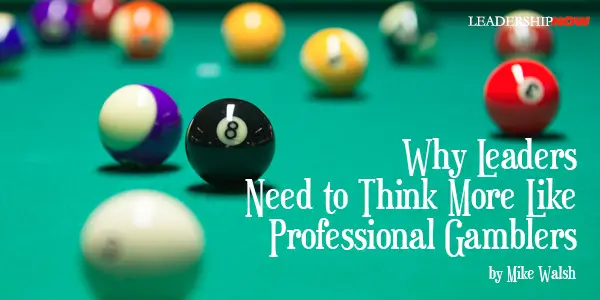
ONE OF the unfortunate side effects of living in an age of accelerating technology is having to deal with increased uncertainty. When faced with uncertainty, how should leaders react? Should they make a big bet, hedge their position, or just wait and see? We tend to see situations in one of two ways: either events are certain and can, therefore, be managed by planning, investment, and reliable budgets; or they are uncertain, and we cannot manage them. You can, however, embrace uncertainty by adjusting your views as new information becomes available. In order to do that, you need to learn something about Thomas Bayes, an English clergyman, and mathematician who proposed a theorem in 1763 that would forever change the way we think about making decisions in ambiguous conditions. Bayes was interested in how our beliefs about the world should evolve as we accumulate new but unproven evidence. Specifically, he wondered how he could predict the probability of a future event if he only knew how many times it had occurred, or not, in the past. To answer that, he constructed a thought experiment. Imagine a billiard table. You put on a blindfold, and your assistant randomly rolls a ball across the table. They take note of where it stops rolling. Your job is to figure out where the ball is. All you can really do at this point is to make a random guess. Now imagine that you ask your assistant to drop some more balls on the table and tell you whether they stop to the left or right of the first ball. If all the balls stop to the right, what can you say about the position of the first ball? If more balls are thrown, how does this improve your knowledge of the position of the first ball? In fact, throw after throw, you should be able to narrow down the area in which the first ball probably lies. Bayes figured out that even when it comes to uncertain outcomes, we can update our knowledge by incorporating new, relevant information as it becomes available. Many years later, French mathematician Pierre-Simon Laplace developed Bayes’s idea into a powerful theory, which we now know as the Bayes Theorem. Here is a simple explanation of it. Beginning with a provisional hypothesis about the world, assign to it an initial probability of that event happening, called the prior probability or simply the prior. After collecting new, relevant evidence, recalculate the probability of the hypothesis in light of the new evidence. This revised probability is called the posterior probability. You can find evidence of Bayesian thinking throughout modern history, from nineteenth-century French and Russian artillery officers adjusting their cannons to Alan Turing trying to crack the German Enigma codes. Bayes has even influenced the design of machine learning techniques, notably the naive Bayes classifier. Bayes is relevant to modern leaders because it can help them develop an approach to uncertainty that is less deterministic and more probabilistic. Even when events are determined by an infinitely complex set of factors, probabilistic thinking can help you identify the likeliest outcomes, and so make the best decisions. Viewing the information probabilistically enables you to describe one of many possible outcomes, some more or less likely than others. One of the key advantages of thinking probabilistically is that it equips you with a more critical perspective to evaluate new data as it becomes available. Data can be imperfect, incomplete, or uncertain. There is often more than one explanation for why things happened the way they did; by examining those alternative explanations using probability, you can gain a better understanding of causality and what is really going on. Deterministic models produce a single solution that describes the outcome of an experiment given appropriate inputs; in other words, for every possible input, there is a single output. A probabilistic model distributes over all possible solutions and provides some indication of how likely it is that each will, might, or can occur. The human mind is naturally deterministic. We generally believe that something is true or false. Either you like someone, or you don’t. There is rarely a situation when you can say that there is a 46 percent probability that someone is your friend. In fact, unless you are a teenager and have a lot of frenemies, you are probably quite deterministic about your social circle. Our instinct for determinism may well have been an evolutionary innovation. To survive, we had to make snap judgments about the world and our response to it. When a tiger is approaching you, there is really not a lot of time to consider whether he’s approaching as a friend or a foe. However, the deterministic approach that kept our ancestors alive while hunting in the savannah won’t help you make good decisions in complex, unpredictable environments when your natural mental shortcuts and heuristics start to fail you. One of the best ways to embrace uncertainty and be more probabilistic in your approach is to learn to think like a professional gambler. Take, for example, Rasmus Ankersen. Ankersen, a Dane living in London, originally came to the UK to look for an English publisher for his book on human performance, the writing of which had taken him from Kenya to Korea in search of why great athletes, whether they are runners or golfers, tend to come from the same small regions. One of the reasons he decided to stay in London was a chance meeting with a professional gambler named Matthew Benham. Benham is a renowned, albeit somewhat inaccessible, figure in the British gambling world. After graduating from the University of Oxford with a physics degree, he went into securities trading, first at Yamaichi International and then at the Bank of America. This was followed by a stint working as a trader for Premier Bet with Tony Bloom, one of the most successful gamblers in the world. That inspired Benham to leave his day job and focus on gambling. He went on to start two successful gaming companies, Matchbook, a sports betting exchange community, and Smartodds, which provides statistical research and sports modeling services. When Ankersen and Benham met, they started talking about how soccer (except, of course, they called it football) was a sport that was yet to be disrupted by data and probabilistic thinking. Benham was impressed enough to invite Ankersen to help run Brentford Football Club, which he had recently acquired. Soon after, Benham also bought Midtjylland, the soccer club in Ankersen’s hometown. Ankersen’s insight was this: soccer is one of the world’s unfairest sports. Although there is a saying that “the league table never lies,” in Ankersen’s opinion that is exactly what it does. Because soccer is a low-scoring sport, the win/loss outcome of a game is not an accurate representation of the actual performance of a team, and therefore the intrinsic value of its players. From a professional gambler’s perspective, the key to placing a good bet is to continually update your position with relevant insights that impact the probability of an event occurring. Rather than trying to be right, gamblers try to be less wrong with time. Benham and Ankersen started to use the scientific application of statistics—the “Moneyball” technique pioneered in baseball— when assessing the performance of a team. Their key performance metric became “expected goals” for and against a team, based on the quality and quantity of chances created during a match. The point of this exercise was to develop an alternative league table, which might serve as a more reliable predictor of results and a better basis on which to value and acquire players. As an algorithmic leader, you will also find having a probabilistic mindset useful, and not just when you want to place a bet in the office fantasy soccer competition. Let’s consider a few examples. A probabilistic HR manager will examine the data about where a company’s best people come from and how they perform throughout their career to identify new sources of talent that may have been overlooked. A probabilistic sales professional will be conscious that it’s not enough to simply close lots of deals; it’s important to also think about where leads come from. How many opportunities were created organically, as opposed to being fed through an existing pipeline? How many new customers churn after just a few months? By understanding the data around which leads go on to become great customers, a sales leader can then work closely with their marketing colleagues to figure out new sources of potential customer prospects. Probabilistic risk managers will think about the future of how they work. While their job may have been setting or applying strict credit policies in the past, they may now start to wonder whether their traditional credit rating models are still effective. Are there low-risk segments in their customer base that they may have missed and that a new competitor may be able to target? Developing a probabilistic mindset allows you to be better prepared for the uncertainties and complexities of the algorithmic age. Even when events are determined by an infinitely complex set of factors, probabilistic thinking can help us identify the most likely outcomes and the best decisions to make. 
Posted by Michael McKinney at 07:16 AM
03.25.19

Are You Living in Conflict Debt?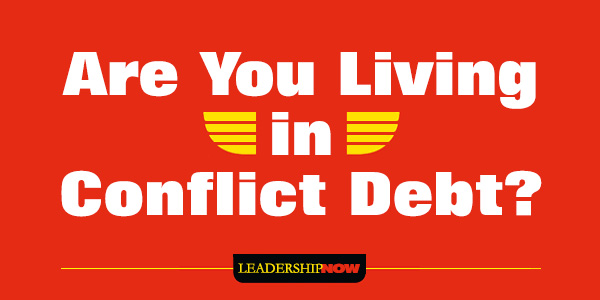
WHEN YOU AVOID the tough discussions and decisions, you hold your business back, make your team dysfunctional, and cause yourself stress. You set up a kind of conflict debt. Conflict debt, writes Liane Davey in The Good Fight, “is the sum of all the contentious issues that need to be addressed to be able to move forward but instead remain undiscussed and unresolved.” The solution is more conflict, not less. “Rather than working through the conflicts that will help our organizations move forward, we avoid, postpone, evade, duck, dodge, and defer them.” We need to work through our contentious issues. Most of us are conflict adverse—as is the author—and she explains why we are that way. We have been conditioned to get along, but we often take that to mean that we should avoid all conflict or simply accommodate others. But she concludes, “conflict is a natural part of healthy relationships and a critical defense against unhealthy ones.” Conflict is normal. And we either can either make it better or worse. And that doesn’t happen by assuming we are right. We need to be curious about the other person or people and where they are coming from. After building the case for conflict, Davey turns here attention to avoiding unnecessary conflict and establishing the ground rules for productive conflict. She calls this the Conflict Code. To begin, you need to establish a line of communication. That is, build the trust before you need it. Next, create a connection so that you can problem-solve as allies rather than fight as adversaries. “When a discussion gets heated, the facts and information presented provide excellent clues about what is important to the players. Pay attention to what is (and isn’t) said to zero in on what’s at stake. Finally, if you have completed the first two steps, you are in a good position to contribute to a solution. She offers six techniques to help you contribute a solution without bulldozing the others at the table. In part 3, Davey focuses on “what you can do to systematize conflict so it’s a part of the standard operating procedure of your team.” This section is worth the price of the book alone. Her examples resonate as they seem to be so much a part of everyday team dynamics. Clarify Expectations Clarifying roles and setting clear expectations from the beginning avoids a lot of unpleasant conflict and drama. “If everyone is clear on their role and the value they are expected to add, they will be less likely to disappoint, or be disappointed by, others in the group.” To this end she has created the U Tool. The U Tool documents “what you need from your superiors, what your team will add, and what you expect from the layers below you” and “when that value should be added.” She covers issues that the U Tool can help to neutralize like the absentee boss and micromanaging. It also helps to raise the bar on expectations. This situation is something I see in my work as an advisor: Adding value at the wrong level can create considerable conflict in your team. First, when you neglect the strategic issues, you fail to provide the direction and context that your team needs from you. In this case, you become the absentee boss and set your team up to fail. The other issue is that as you dip down into issues and choices that should be made in the next level, you disempower the leaders whose job it is to be making those decisions. It’s demoralizing when you do their job as it robs them of their opportunity to add value. I’ve even seen leaders more than two layers above encroaching on the work of the individual contributors. One of my clients admitted sheepishly that he had been “belly-down in the bottom of the U.” He was simultaneously disempowering two layers of his team. Normalize Tension When we think about teams we think about conflict-free members all rowing in the same direction. This ignores he reality and our ability to deal with it—if we do. “You can be a good team player and still create tension with your teammates.” Davey introduces a metaphor called The Tarp. Imagine a group of people stretching out a tarp and each pulling in a different direction. If it’s all in balance it works. But what happens if one team member pulls harder than the others What if the strength of one member overwhelms that of his teammates? What if one of the team members gets fed up, rolls her eyes, and walks away? To get the best possible answer out of a team, you need to pull in different directions, always optimizing the tension on the system—never pulling so hard that you take the team of course, and never so gently that your angle isn’t covered. That’s what productive tensions should feel like. The common issues are when a team member is pulling too hard dominating the discussion. Or the opposite when someone is under contributing by staying silent or gives up presenting their point of view. The Conflict Habit Make productive conflict a habit. A habit you “engage in routinely without requiring significant attention and effort.” To add productive conflict into your organization, you might begin by clarifying expectations, add then adding some low-intensity conflict by offering another perspective, define consequences, and highlight assumptions. Improve your feedback by not loading up on judgments but observations. (Very helpful section.) She also suggests using humor and code words “to draw attention to troublesome behavior in a gentler way.” Finally, encourage productive conflict in your meetings. “Instead of creating a forum for productive conflict to be surfaced and resolved, meetings are often just hour-long displays of the power and politics on your team. The actual work of discussing and coming to a solution is relegated to side conversations and he dreaded meeting-after-the-meeting.” So often we see teams living in conflict debt. They let issues pile up until someone leaves or blows up. Introducing productive conflict will take the pressure off, encourage cooperation and help you get things done. The Good Fightis a well-written book on a critical issue. The examples are helpful and it includes a bonus chapter on how this can help at home. Templates and worksheets for the U Tool and for creating a diagram of your own Tarp are available on her website. 
Posted by Michael McKinney at 08:12 AM
02.04.19

Simple Techniques to Overcome Negative Emotions When Negotiating with Others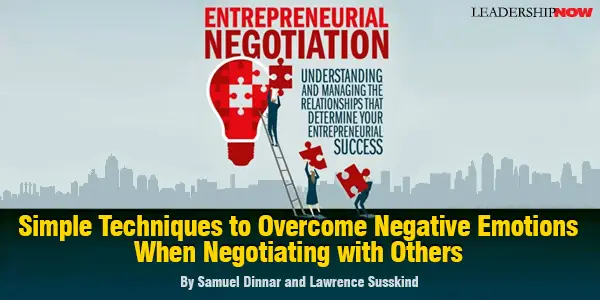
A KEY PREDICTOR of entrepreneurial success is a leader’s ability to manage relationships with investors, employees, and customers. Relationships are negotiations. We all negotiate. How well we learn to negotiate can be the difference between success and failure.
Here we will look at one aspect of successful negotiating: our emotions. The mishandling of emotions – especially tension and mistrust – is a major source of errors when negotiating. It can lead to miscommunication, misjudging the other party’s motives, inability to reach consensus, and more. In our book Entrepreneurial Negotiation, we explain that the best way to diffuse negative emotions is to prevent them from escalating in the first place. Diffuse Tension Before It Escalates At the beginning of every negotiation, there is a natural tension in the air. The higher the stakes, the higher the tension level. To diffuse it, open by conveying your sincerity and warmth with a handshake, eye contact, and a smile, as appropriate. Other ways of reducing tension in the first few minutes are sharing airtime while projecting genuine interest, showing respect and asking for agreement on some small initial ground-rule (e.g., use of first or last names, seating arrangements, etc.). A 2004 experiment using sociometric badges in a mock negotiation (between a corporate vice president and a middle manager) demonstrated that “tone of voice” used by participants in the first five minutes predicted more than a third of the variation in the objective and subjective outcome of a negotiation. They also found that turn-taking dynamics (who speaks when) had a strong correlation with the subjective value levels reported after the negotiation. Still, other studies showed that similarity, also called affiliation, is a primary factor that influences personal human connection – the building of rapport between individuals. Rapport reduces stress and is the best predictor of success in relationships. As a negotiation proceeds to more difficult topics, good negotiators maintain a relaxed tone (with the appropriate level of seriousness) while respecting their counterpart’s autonomy and status. The Power of Humor, Stories, and Metaphors Several additional tools that are often used to reduce stress are storytelling, metaphors, and humor. The appropriate use of humor, especially, can serve as a release valve for negative emotions such as anxiety, suspicion, and anger, and can create room for people to put things in perspective. Humor can also serve as a way of acknowledging the absurdity of the moment, where parties have inadvertently locked themselves into extreme positions. Humor does need to be used carefully. If a party doesn’t understand an attempt at humor, they may be left wondering if the joke is on them. If they feel as if they are the target (or that they are being taken lightly), it will most likely make the situation worse. Finding the right balance between humor and serious intent can make it easier to deal with escalating competitive behavior. Stories have the power to convey an important idea, stimulate a strong emotional response, and allow a release of political or interpersonal tension. They help to shift everyone’s focus from the tension in the room to the tension in the story. At the conclusion, when the story’s tension is finally released – both the listeners and the storyteller experience a stress-reducing feeling. Our brains react to stories the same way they react to true events. Using metaphors is also effective. For example, in negotiating the break-up of a business, framing the situation as a pile of cash to be divided creates a “divide the pie” metaphor. This is likely to induce a win-lose mindset. Using a story about a “cash cow” might shift the focus to a living creature that cannot be divided, but if taken care of will produce dividends over time. This second framing metaphor would more likely induce a collaborative discussion of how to share responsibilities and allocate future profits. Apologize Quickly and Sincerely f you realize you have done something that has hurt the other side, you should issue an apology immediately. It is rarely to your advantage to provoke feelings of fear, anger or resentment. A sincere apology can often restore a better working context. Apology is a social ritual that shows respect and empathy to the offended person. While you cannot undo a mistake, an apology can help the other side move on. This is the opposite of what happens when a person is emotionally triggered. Experiments show that receiving an apology reduces heart rate, breathing rate, sweat levels, facial tension, and blood pressure. Apologizing quickly and sincerely shows that you take responsibility for your actions. On your side, it can also prevent a buildup of remorse or shame caused by the fact that you hurt someone or simply as a result of having made an error. It is not easy, and quite humbling to apologize, but when done correctly it projects the inner strength of someone who is confident and aware of the feelings of others. Even when you apologize immediately, don’t rush things. It takes time for impacted emotions to wash over the other side. The body needs time to recover and to switch from fear, anger, and anxiety to empathy and compassion. Be present and attentive. Accept the silence as OK, and don’t move on prematurely. You may need to repeat your apology, since it may not have been fully heard or absorbed the first time. Focus on your counterpart’s reactions. Wait for them to indicate that it is OK to continue. Some mistakes are minor, and it will be easier for the other side to recover from these, even without an apology. Some will require both sides to cool off before continuing. After you have apologized and demonstrated your sincere intent to remedy the situation, you may want to revisit the item that was on the agenda when you made the mistake initially. Ask for a “do-over.” This is the ultimate “detect and respond” response: an “on-the-spot” apology that is accepted, coupled with permission to return to the negotiation. Negotiations are fraught with tensions. Learning to reduce tension and negative emotions creates a better outcome for everyone.  
Posted by Michael McKinney at 11:43 AM
01.25.19

The Fearless Organization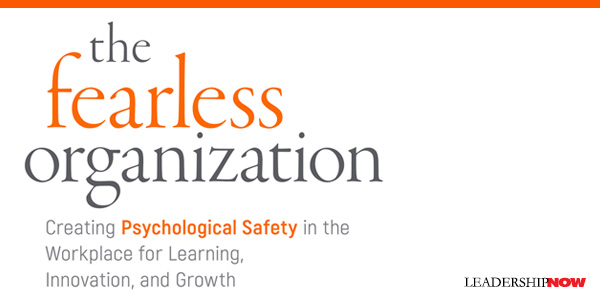
YOU’VE CAREFULLY put your team of people together, spent a lot of time getting the right people on the bus, your best and brightest, and yet you’re underperforming? Your team isn’t giving you everything they’ve got. People hold back when they feel it is not in their best interests to contribute—to say what they think. As a result of this interpersonal fear, we miss the benefit of the very minds we are relying on to move us forward. Creating psychological safety is essential in a world where innovation, integrity, and renewal can make the difference between success and failure. In The Fearless Organization, Amy Edmondson explains what psychological safety is and what it isn’t and how we can create in our organizations. We all—most of us—manage our image. Some better than others. But… No one wakes up in the morning excited to go to work and look ignorant, incompetent, or disruptive. These are called interpersonal risks, and they are what nearly everyone seeks to avoid, bit always consciously. In fact, most of us want to look smart, capable, or helpful in the eyes of others. No matter what our line of work, status, or gender, all of us learn how to manage interpersonal risk early in life. And it is this fear we have of looking bad or retribution that organizations must reduce or eliminate if we are to help people to bring their best to work. Psychological safety is not about taking all of the bumps and ruts out of the road (which sadly is becoming more and more prevalent in leadership thought today). Psychological safety is like the oil in the machine. It makes everything else you’re doing work better. It is an enabler. “Psychological safety makes it possible for other drivers of success (talent, ingenuity, diversity of thought) to be expressed in ways that influence how work gets done.” Without it, people will withhold thoughts, ideas, and contributions that are vital to your growth, renewal, and the overall health of your organization. It’s not about whistle-blowing. “Whistle-blowing is not a reflection of psychological safety but rather an indication of its absence.” Psychological safety is not about introverts or extroverts. It’s not about being nice. It’s not about creating an environment where people are talking all the time. You need discipline. The is to make it easy for everyone to get everything out on the table so that you can proceed in a thoughtful, calculated way. Psychological safety doesn’t mean sharing everything either. That doesn’t create a safe place to work. People will learn where to draw the line with constructive feedback. It’s an emotional intelligence issue. Psychological safety is not about lowering performance standards. It’s not an anything-goes environment. As the chart below shows, “psychological safety and performance standards are two separate, equally important dimensions—both of which affect team and organizational performance in a complex interdependent environment.
Psychological safety enables candor and openness and, as such, thrives in an environment of mutual respect. It means that people believe they can—and must—be forthcoming at work. In fact, psychological safety is conducive to setting ambitious goals and working toward them together. Psychological safety sets the stage for a more honest, more challenging, more collaborative, and thus also more effective work environment. One must build psychological safety to spur learning and avoid preventable failures, and they must set high standards and inspire and enable people to reach them. We owe each other our opinions and ideas, and it is the responsibility of leaders to create and reinforce an environment where people free to do that. Psychological safety is about unleashing talent across your organization. Creating a psychologically safe workplace is an ongoing function of leadership. Edmondson divides the process into three steps which she covers in detail: Setting the Stage, Inviting Participation, and Responding Productively. Setting the Stage This step is about framing the work to be done and how failure is to be dealt with. As GoogleX’s Astro Teller stated, “the only way to get people to work on big, risky things…is if you make that the path of least resistance for them [and] make it safe to fail. I’m not pro failure, I’m pro learning.” Inviting Participation Two mindsets are required here: situational humility and proactive inquiry. Humility is an obvious quality but not as easy to cultivate. Inclusiveness on the part of leaders helps in this regard. London Business School Profesor Dan Cable wrote, “Power…can cause leaders to become overly obsesses with outcomes and control,” inadvertently ramping up, “people’s fear—fear of not hitting targets, fear of losing bonuses, fear of failing—and as a consequence…their drive to experiment and learn is stifled.” No one feels safe presenting ideas to a know-it-all or someone who feels the need to be talking all of the time. Proactive inquiry is actively asking questions designed to learn more about an issue, situation, or person. We benefit from a diversity of views. Implement structures designed to elicit employee input. Responding Productively “It’s imperative that leaders—at all levels—respond productively to the risks people take. Productive responses are characterized by three elements: expressions of appreciation, destigmatizing failure,” and punishing clear boundary violations—reinforcing the rules of mutual respect.
There is a connection between psychological safety and learning. It’s foundational to building a learning organization. In an ever-changing world, learning and adaptability is everything. Edmondson admits that this is not an easy process. It’s not a natural process. Creating psychological safety is a constant process of smaller and larger corrections that add up to forward progress. Like tacking upwind, you must zig right and then zag left and then right again, never able to head exactly where you want to go and never quite knowing when the wind will change. It’s a necessary condition for success. What’s at stake is the future of our organizations. 
Posted by Michael McKinney at 03:28 PM
11.23.18

Farsighted: How We Make the Decisions That Matter the Most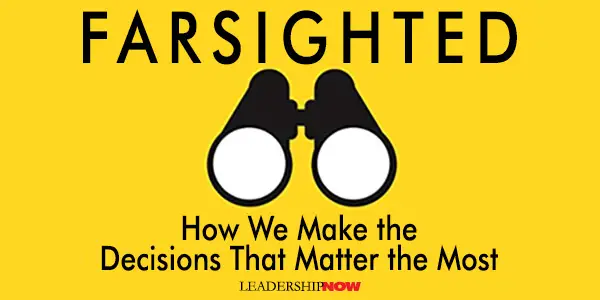
L Some choices are easy like “Should I get vanilla or chocolate ice cream?” Most of our decisions are like this, and the consequences aren’t life-changing. Most books on decision-making describe these kinds of intuitive, gut-reaction decisions. But not all decisions are of this type. Some are farsighted choices as Steven Johnson calls them in Farsighted: How We Make the Decisions That Matter the Most. These are the big decisions—life choices—like should I move to Denver? Should I take that job? Should I move home? Should I buy that car? Should I buy the house? Should I get married? How do we make the right choice in these kinds of decisions? The answers are rarely a clear yes or no. These are complex problems with multiple variables. We are all familiar with Benjamin Franklin’s two-column method. Most of us just tally the number of items on each list and go with the longer list. But Franklin recommended an important final step in this process. He advised that you conduct a kind of “Prudential Algebra” to each entry to give them relative weight because not all reasons are of equal value. It makes good sense, but as we know, sometimes it works, and sometimes it doesn’t. What we need is “a routine or a practice—a specific set of steps for confronting the problem, exploring its unique properties, weighing the options.” A deliberate and measured approach that allows you to think about a problem from multiple perspectives. Johnson puts forth a three-step method “designed specifically to overcome the unique challenges of a hard choice.” All decisions have a context, perspectives, and possible consequences. This method helps to address each of them. The method begins with building a full-spectrum map of all of the variables and the potential paths available to us. Then we make predictions about where all those different paths might lead us, given the variable at play. Finally, we decide on a path by weighing the variable outcomes against our overarching objectives. Given our disposition towards scientific methods, we would like this to be scientific to remove the human weaknesses that challenge our decision-making. But as Tolstoy’s Prince Andrew counseled in War and Peace, “What theory and science is possible about a matter the conditions and circumstances of which are unknown and cannot be defined, especially when the strength of the acting forces cannot be ascertained?” The Prince continued, “What science can there be in a matter in which, as in all practical matters, nothing can be defined and everything depends on innumerable conditions, the significance of which is determined at a particular moment which arrives no one knows when?” Mapping We all use mental maps whether we know it or not. The trick is to be intentional about it. “What the map should ultimately reveal is a set of potential paths, given the variables at play in the overall system. Figuring out which path to take requires other tools.” In the mapping step, you are looking to expand the context of your decision to include all possible decision paths. The art of making farsighted decisions “with as much wisdom as possible lies not in forcing that map to match some existing template, but instead in developing the kind of keen vision required to see the situation as it truly is. And the best way to develop that vision is to get different pairs of eyes on the problem.” It requires a bit of humility as well. You are more likely to be right to the degree that you recognize that you may be wrong. We must embrace the likely possibility that we are wrong to get it right. Often what stands in our way of getting it right is our certainty that we are right. The lesson: explore other alternatives. Predicting When we make a farsighted decision, we are predicting what will happen as a result of our decision. But that’s not easy. One of the problems we run into is assuming that things will continue as they always have—the fallacy of extrapolation. Things changes and we don’t know what we don’t know. As Nobel laureate Thomas Schelling once noted that one thing a person cannot do “is to draw up a list of things that would never occur to him.” To make good decisions, we need to make those kinds of imaginative leaps. Johnson prescribes simulations to do just that. Engaging in scenario planning or gaming is not to make accurate predictions, but “the very act of trying to imagine alternatives to the conventional view helps you perceive your options more clearly.” Pierre Wack wrote in the Harvard Business Review, “No single ‘right’ projection can be deduced from past behavior. The better approach, I believe, is to accept uncertainty, try to understand it, and make it part of our reasoning.” It is a kind of storytelling. We create stories around our decisions all the time—“when we do this, this is what it will be like.” And that’s good. The problem arises when we fail to construct multiple stories around our choices. “That doesn’t always give you a definite path, but it does prepare you for many ways the future might unexpectedly veer from its current trajectory.” With the decision mapped, the options identified, and the scenarios panned, it’s time to decide. Deciding Making a decision is the final step. How do we decide? What’s best for me or what’s best for the greater good or some other cost-benefit analysis. If we’ve done the first two steps well and given ourselves an appropriate amount to process, often the decision becomes clear. “But sometimes the answer is murkier, and you have to make the tough call between a few remaining options, each of which promises a different mix of pain and pleasure to the individuals affected by the choice.” Almost every strategy described in this book ultimately pursues the same objective: helping you see the current situation from new perspectives, to push against the limits of bounded rationality, to make a list of things that would never occur to you. They’re designed to get you outside your default assumptions, not to give you a fixed answer. While Johnson presents many strategies and ideas of real value, the magic of Farsighted is the examples he weaves throughout to make the ideas and principles come alive. Of Related Interest: 
Posted by Michael McKinney at 04:14 PM
03.12.18

Meltdown: Why Our Systems Fail and What We Can Do About It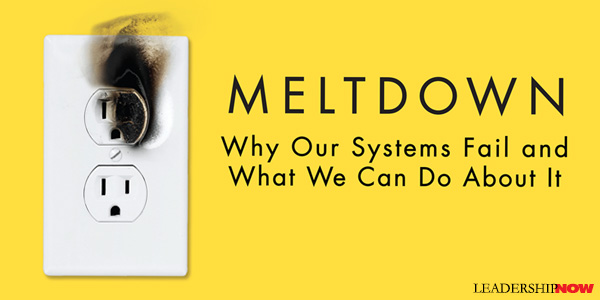
W As systems become more complex, we are more vulnerable to unexpected system failures. In Meltdown, the authors examine a fatal D.C. Metro train accident, the Three Mile Island disaster, the collapse of Enron, the 2012 meltdown of Knight Capital, the Flint water crisis, and the 2017 Oscars mix-up, among other meltdowns, and discover that while these failures stem from very different problems, their underlying causes are surprisingly similar. These stories told here are a compelling look behind the scenes of why failures occur in today’s many complex systems. Using sociologist professor Charles Perrow’s theory that as a system’s complexity and “tight coupling” (a lack of slack between different parts—no margin) increase the chance of a meltdown. In other words, these failures are driven by “the connections between the different parts, rather than the parts themselves.” Some systems are linear and in these systems, the source of the breakdown is obvious. But as systems become complex, as at a nuclear power plant, the parts of the system interact in hidden and unexpected ways. Because these systems are more like a web, when they breakdown, it is difficult to figure out exactly what is wrong. And worse still, it is almost impossible to predict where it will go wrong and all of the possible consequences of even a small failure somewhere in the system. As more and more of our systems become more complex and tightly coupled, what do you do? How do we keep up with our increasingly complex systems? Oddly enough, safety features are not the answer. They become part of the system and thereby add to the complexity. And when something goes wrong, we like to add even more safety features into the system. “It’s like the old fable: cry wolf every eight minutes, and soon people will tune you out. Worse, when something does happen, constant alerts make it hard to sort out the important from the trivial.” There are ways to make complex systems more transparent. For example, using premortems. Imagine in the future your project has failed. Write down all of the reasons why you think it happened. A 1989 study showed that premortems or prospective hindsight boost our ability to identify reasons why an outcome might occur and therefore deal with the potential problems before they occur. We also should encourage feedback and sharing of failures and near-misses. “By openly sharing stories of failures and near failures—without blame or revenge—we can create a culture in which people view errors as an opportunity to learn rather than as the impetus for a witch hunt.” Encourage dissent with a more open-leadership style. People in power tend to dismiss other’s opinions. Leaders should speak last. You have to work on the culture. Ironically, the authors note, introducing anonymous feedback actually highlights the dangers of speaking up. Bring in outsiders and add diversity of thought. Outsiders will see things we don’t and are more willing to ask uncomfortable questions. Also in a more diverse environment, we tend to be more vigilant and question more. When we are around people just like us, we tend to trust their judgment which can lead to too much conformity. “Diversity is like a speed bump. It’s a nuisance, but it snaps us out of our comfort zone and makes it hard to barrel ahead without thinking. It saves us from ourselves.” Transparent design matters. We need to see what is going on under the hood. Being able to see the state of a system by simply looking at it can be an important safeguard. These are just a sampling of the ways we can learn to manage complex systems. This doesn’t mean we should take fewer risks. On the contrary, these solutions—structured decision tools, diverse teams, and norms that encourage healthy skepticism and dissent—“tend to fuel, rather than squelch, innovation and productivity. Adopting these solutions is a win-win.” We can make our systems more forgiving of our mistakes by thinking critically and clearly about our own systems. How many things have to go right at the same time for this to work? Can we simplify it? How can we add margin? 
Posted by Michael McKinney at 06:54 PM
02.13.18

Creating Great Choices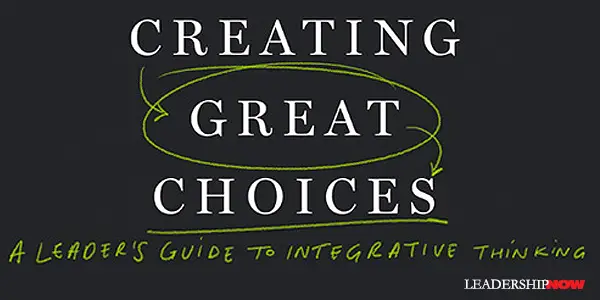
O If we understand that we all have different mental models—our view of how the world works—we use those various models to improve our own. Once we see things in a certain way, it becomes very difficult to see things in a new way. Integrative thinking is a method to do just that. Roger Martin introduced the practice of integrative thinking in his book, The Opposable Mind. “The opposable mind is one that can use the tension between a set of ideas to create new and superior answers to challenging problems. This follow-up book, written by Martin and adjunct professor Jennifer Riel, Creating Great Choices, provides the methodology to do just that. Martin finds that there are three elements missing from most decision-making processes: metacognition, empathy, and creativity. When employed, metacognition allows us to understand better our own thinking and existing mental models that influence our decisions and the choices available to us. Empathy allows us to understand the thinking of others, which in turn illuminates the gaps in our own thinking and areas where we might connect with others. Finally, creativity provides the imaginative spark to create new and better choices rather than just accepting the options held in tension before us.
Articulate the Models Step one is to Articulate the Models, that is “to frame the problem and tease out two opposing models for solving it.” What are the core elements of each model? The idea is to create a two-sided dilemma from a general problem like whether to use a centralized structure versus a decentralized structure or consumer needs versus shareholder expectations. Ultimately you will not choose between the two, but to use the two models or approaches to create a better choice. The outcome we will look for, won’t be a compromise between the two choices, but a choice that takes the best of both that will produce an outcome that is preferable to the existing ones. Examine the Models Step two is to Examine the Models. While holding them in tension, define the points of tension between the two models or approaches, illuminate the assumptions, and determine the cause-and-effect forces. As you look at the models, ask, what are the forces that drive the most important outcomes or the benefits we most value of each? How might we change how we think about the approach? What is similar? What is different? What benefit would you be loath to give up from each model? Now you want to shift from understanding the models to creating new models, “creatively building from both opposing models to design an answer that is ultimately superior to either one.” Examine the Possibilities So in step three, you Examine the Possibilities. Explore other resolutions. Here there are three directions you might go to find a better choice: the hidden gem, the double-down, or the decomposition. In the Hidden Gem, you take “one deeply valued benefit from each of the opposing models and throw away the rest. You imagine a new approach designed around the two gems.” And “you will need to replace all of the elements you’re throwing away with something new.” “I want one small element of A and B.” In the Double-Down, causality is key. If you identify one of the models as the one you would choose if it just weren’t missing one critical element, you Double-Down. “I want all of A and one key element of B.” In Decomposition, you do both—two contradictory things at once. You will need to “reach a different understanding of the problem you’re trying to solve.” In other words, you will need to break the problem apart and apply one solution to each. “I want all of both.” Assess the Prototypes Finally, in step four Assess the Prototypes to test different possible answers to find an answer that can actually be implemented. Proving an idea that is new is possible only in theory. A new model is possible only if we think differently. “At this stage, gaps in logic are necessarily the sign of a bad idea; rather, they are the hallmark of a new one. Gaps represent an opportunity to clarify and refine what a possibility could be. Possibilities become richer as they become more concrete because there is less abstraction within which to hide.” They recommend that when trying to communicate a new idea, try using storytelling, visualizing, or modeling—words, pictures, and/or objects. Look for ways to disprove the idea or under what conditions might it not work. In this way, you can finds ways to strengthen the idea. What Is Your Stance? Going into any decision-making process, you need to understand your stance—where you are coming from—who you are and what you are trying to do. What informs your thinking? Different stances drive different outcomes. As a leader, your job is to be clear about your own thinking, knowing that your own models or views of the world are at least a little bit wrong. Understand others view of the world to inform and improve your own. And patiently search for answers that resolve the tension between opposing ideas to find the opportunities to create better choices. Integrative thinking isn’t for every problem you face. “But when you find that your conventional thinking tools are not helping you to truly solve a problem, integrative thinking can be the tool that shifts the conversation, defuses interpersonal conflicts, and helps you move forward.” Martin and Riel have included in this integrative thinking user’s guide, templates to help you work through each of the four steps. Keep it handy. 
Posted by Michael McKinney at 09:49 PM
02.09.18

To Understand Complexity, Use 7 Dimensions of Ethical Thinking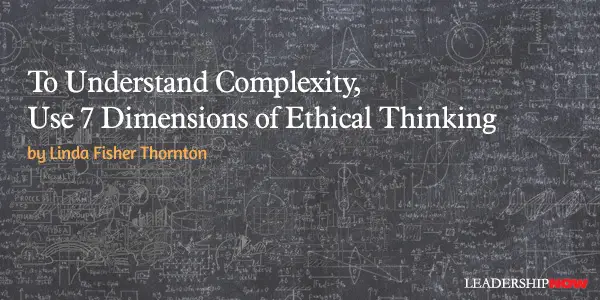
T When my book 7 Lenses was first published, I wrote a guest post about it called “The 7 Lenses of Ethical Leadership” for this blog. Since that time, 7 Lenses has gone into its second printing. This book helps leaders “see” the ethical impact of their choices through 7 Lenses of Ethical Responsibility. The lenses highlight the impact on many constituents, in the short term, and over generations, giving leaders a holistic ethical picture. As work complexity increases, the ethical thinking we use to address it must advance as well.
Every leader must weigh the financial impact of decisions. Even non-profits have to carefully manage finances and raise funds using ethical practices. All companies have to comply with laws and regulations. The higher levels of ethical thinking, though, require a much longer-term perspective and a global worldview. We must be ready to make ethical decisions when dealing with multiple stakeholders with differing interests in the outcome. In the 7 Lenses model in the book, each lens of the 7 focuses leader attention on one area of ethical leadership responsibility, and together all 7 of the lenses show leaders the combined impact of their choices. This way of thinking about ethics, in 7 dimensions, guides us to high level leadership thinking. Using better thinking we get better leadership. Concepts and ethics guidelines that live “on the shelf” aren’t practical enough to help people navigate complexity. Leaders don’t just need to think ABOUT ethics, they need to think WITH ethical values to deal with catastrophic change and respond to increasing consumer expectations for transparency and ethical business. Ethical values drive business success and they should be the basis for every choice we make. Applying them builds trust and sets the foundation for all good business relationships. Many leaders I talk with have a feeling that there is a more meaningful way of thinking and leading than what they’ve been seeing. These leaders want to have a positive impact in the workplace and make a difference in the world. Learning high level ethical thinking will not only help them handle the challenges they are already facing, it will also improve their long term social impact. We know that in the age of transparency, ethical brand value helps drive an organization’s bottom line results. How do we ensure that leaders will use the kind of thinking that leads to ethical action? We start by making ethical thinking “must have” development for leaders.  
Posted by Michael McKinney at 10:30 AM
12.22.17

Moving Your Agenda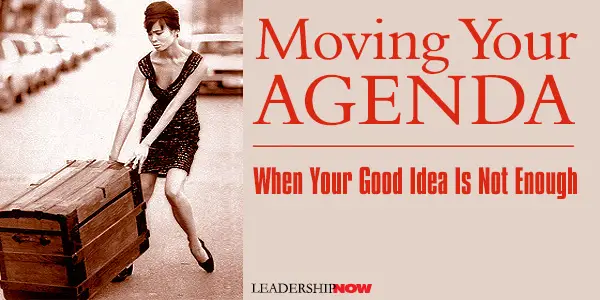
M Samuel Bacharach writes in The Agenda Mover, that leadership is “about your capacity to take your ideas and work them through the maze of resistance, overcome challenges, and put those ideas in place. Leaders are remembered for their accomplishments, not their promises.” To that end, Bacharach has provided a practical guide to do just that. He presents a four-step process that anyone can learn to master with practice. To move an agenda, you need to learn to harness what others have to offer if for no other reason than you have blind spots. You need to build a coalition and develop the managerial skills required to maintain forward movement. It requires a campaign of pragmatic leadership. “Agenda movers are aware that their self-interest, emotions, cognitive capacity, and background can trip them up if they are not careful and that being smart is not a guarantor of success.” 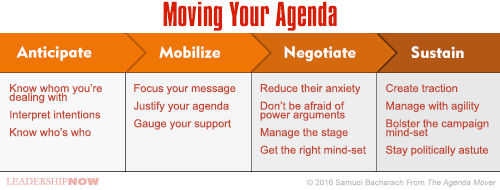 The four major stages in any campaign are first, you must anticipate the agendas of others. Second, you must mobilize your campaign. Third, you need to negotiate buy-in. And fourth, you must sustain momentum. In this post we will focus on the first stage—Anticipate the Agenda of Others—because this is the stage that most of us miss or move too quickly over and set ourselves up for frustration or failure. Anticipate the Agenda of Others This means knowing where others are coming from. Putting yourself in their shoes. Empathy. Our own egos are the enemy here. You need to know who you are dealing with—the stakeholders. Bacharach lists four: Top Dogs (organizational decision-makers), Gatekeepers (the liaisons), Gurus (senior individuals, external consultants, the board of directors), and the Players (people directly impacted by your agenda). The players are your essential ally. Never underestimate them. All of these stakeholders have their own agendas and ways they go about accomplishing them. There are the Tinkerers versus the Overhaulers and the Planners versus Improvisers that make up the Four Agenda Archetypes. There is the Let’s-Be-Careful Traditionalist, the Cross-That-Bridge-When-We-Come-to-It Adjuster, the Push-the-Envelope Developer, and the Tear-the-Envelope Revolutionary. If you know where you are coming from and where others are coming from you can begin to see what might motivate someone to join your change effort. This framework can help you do that. 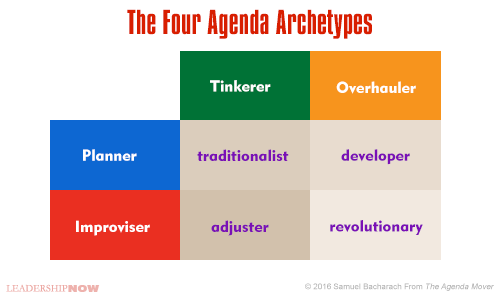 Distinguishing traditionalists from developers, developers from adjusters, and adjusters from revolutionaries allows you to identify where others are coming from quickly and efficiently. In making these distinctions, be careful not to assume that these agendas are immutable or that people are uniformly consistent from one situation to another. Of course, we are a factor in the process. We have our own motivations and our preferred ways of dealing with change. It is critical that we know where we are coming from too. We may need to adjust the approach we are comfortable with in order to move our agenda. The chart below helps you to see how your motivation relates to the motivation of others. “Allies are those who share your agenda, and it is easy for them to see where you’re coming from.” Traditionalists can anticipate that a Revolutionary will resist their approach and agenda. But here is a key insight: Agenda movers are leaders who understand that leading isn’t about meeting jubilantly with allies or reasoning earnestly with resistors. Successful leaders understand that the real challenge is in the gray area—converting potential allies into allies and making sure the potential resistors are not transformed into full-fledged resistors. Potential allies and potential resistors disagree with either your approach or your goals. Skillful negotiation may persuade these individuals to reconsider aspects of your agenda that differ from theirs. If you are not careful, potentials can easily switch to resistors. 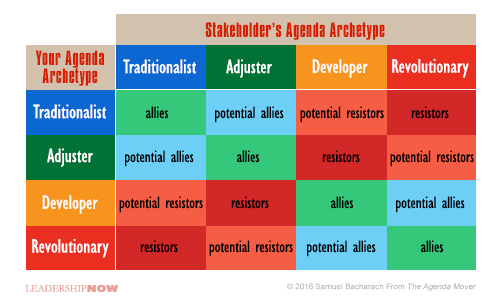 Mobilize Your Campaign Timing and tone make a difference. “To mobilize others you must: focus your message; justify your agenda; establish your credibility; and gauge your support.” You do not want to oversell here. Choose your words carefully to justify why your agenda should be supported. Make sure your idea is well thought through and you demonstrate the ability to see it through. Negotiate Support “Getting the buy-in is about shifting your focus from sharing your passion for your idea to really thinking about where the other party is coming from.” It is a process of reducing their anxiety. How will it benefit them? If they come on board, it is reasonable to assume that it can be done, will they get any of the credit, and are they protected if it fails. They want to know what changes for them. Your approach to the situation will make a big difference. You can approach it with a controlling, hardline mindset if this is a one-time thing. On the other hand, you can try a more cooperative mindset that seeks to pull-them-in. This mindset may allow you to build supporters for any future agenda you may have. Sustain Your Campaign This is where the rubber meets the road. After you’ve won people over, you have to get it done. “You may have sold your idea and created a coalition, but you can only sustain momentum and get results if your team can keep up its energy and focus in spite of challenges, obstacles, and setbacks.” To create traction, you need to celebrate small victories, make sure they own the idea and manage with agility. You have to be smart about how you present yourself and deal with others. You can micromanage your team, but you are better acting as a facilitator coach. To go the distance, your team must act with a collective purpose. You can sustain the campaign mindset by reminding them why they are part of your effort, reinforcing the payoff, keeping an optimistic outlook, and maintaining your credibility. It is crucial to remind people not only about the importance of the mission but also about how important they are to the mission. Anyone successful at moving an agenda knows that it is not a solo effort. “Failed leaders are those who assume that they are the most important player.” The Agenda Mover is a book that leaders at all levels would benefit from reading. It is common to see people trying to push their agenda without first defining what they are up against and without any understanding of the impact they themselves are having on others. Without that knowledge, we often resort to destructive behaviors to get our agenda moving. In that regard, this book is critical for anyone with an idea they want to have taken seriously. 
Posted by Michael McKinney at 12:45 PM
08.03.17

How to Work with People You Don’t Agree with or Like or Trust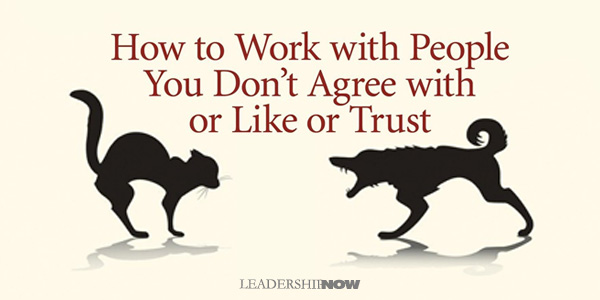
I Faced with our country’s overwhelming problems, we have two options: a practical option and a miraculous option. The practical option is for all of us to get down on our knees and pray for a band of angels to come down from heaven and solve our problems for us. The miraculous option is that we work things through together. If we (and they) choose to collaborate, how do you work with people you don’t trust, who have incompatible agendas, and histories of dislike? What do you do when you need to come together to solve a problem but they can’t see it your way? Part of the issue is we come into the collaboration with the idea that we can control the process; we can get people to make the changes we need them to make. When a situation with others becomes hopeless or dire, we double-down and try to find a way to convince them, even force them to change in order to bring them into alignment with our thinking. Underlying this approach is the belief that I/we know what is best and it is my duty to make them change for their own good. When faced with others different from us we tend to label them as enemies. We demonize and vilify them. Call them names even. Our enemfying, which feels exciting and satisfying, even righteous and heroic, usually obscures rather than clarifies he reality of the challenges we face. It amplifies conflicts; it narrows the space for problem solving and creativity; and it distracts us, with unrealizable dreams of decisive victory, from the real work we need to do. We need a better approach and mindset. Kahane introduces an idea called stretch collaboration. We need to shift our thinking in three ways: The first shift is instead of focusing on a narrow focus over the good and harmony of the team, we should embrace the conflict and connection within and beyond the team. In short, we have to affirm the legitimacy of every perspective of the group. Each participant brings a perspective that they care about and by acknowledging all we can form a more complete picture. The second shift deals with the process. Instead of insisting on one right view of the problem, the solution, and the plan, we need to move toward experimenting systematically with different perspectives and possibilities. We learn together. We think through the issues and solutions together to see what could work. The idea is to cocreate new options as we—together—work through the issues. The final shift requires us to see ourselves as part of the whole and as one orchestrating the collaboration. We are a participant as much as everyone else. We tend to overlook ourselves as part of the problem. Bill Tobert once told Kahane that “if you’re not part of the problem, then you cannot be part of the solution.” Ego is always an issue. “When we are faced with a challenging situation, we focus our attention first and foremost on what other people are doing or not doing or out to be doing.” Kahane adds, “Blaming others is a common and lazy way to avoid doing our own work.” These shifts require us to move outside ourselves. “Self-centeredness means that we arrogantly overestimate the correctness and value of our own perspectives and actions, and we underestimate those of others.” Keep in mind, “Your enemies can be your greatest teachers.” 
Posted by Michael McKinney at 12:57 PM
07.10.17

The Mathematical Corporation
Y A mathematical corporation is one that takes advantage of machine intelligence by collaborating with it to achieve leading-edge results. It will require a shift in your thinking. “As a leader,” say Josh Sullivan and Angela Zutavern in The Mathematical Corporation, “you need to evolve your focus to excelling through imagination, creativity, reasoning, and problem structuring.” Leading in the era of the mathematical corporation means learning to work with the machine to investigate mountains of data not by braking them down, but by keeping them together to mine insights never before imaginable. It means being able to distinguish what machines are good at doing from what people are good at doing. When people and machines are appropriately paired we can explore heretofore impossible strategies and execute incredible solutions. Machines will not replace people but we will need to develop and capitalize on some uniquely human skills. “People will continue to be better than machines at many of the loftiest cognitive tasks, like asking questions to clarify a problem, composing experiments to test hypotheses, and drawing on truths in one discipline to elicit insights in another.” Because of the machine’s ability to synthesize vast amounts of data, it would be wise to question your own judgments when machines offer a different conclusion from your own. Machines, for example, can recognize patterns better than we can. That said, “computers don’t know the cause of a pattern. They don’t have the human appetite to get to the bottom of the matter, and they don’t ask, ‘Just how does cause A lead to effect B?’ They learn, infer, and have high recall accuracy, but they don’t know the story of cause and effect. So, the task of taking a cause-and-effect understanding of a business system and crafting a strategy from it remains a people job.” Getting the Questions Right While Big Data adds complexity, it is only a problem if you don’t know how to mine it for value. The key skill for leaders is to be able to ask better questions than to offer solutions. Asking the right questions is critical. Poor questions lead to questionable insights. “That’s why as a leader, you need to remain at the tip of the process, seeing the world in a much broader and more differentiated way than others.” Not only asking the right questions but removing our own biases from them, will bring us breakthrough insights and more nuanced answers. Another issue we will have to work through is not projecting our limitations and constraints on the machine. Although we have a mental model that we filter the world though, we must be careful not to constrain the machine—our questions—in the same way. What About Intuition? In the mathematical corporation, the role intuition will shift from judging reality to judging models. “No matter your feeling on intuition, its role is destined to shift to a smaller, if still critical position. As machine intelligence converts implicit understanding to exploit facts, replaces implicit assumptions with data-givens, counters biases with hard evidence, we have to admit the superiority of the cold facts encoded in 1s and 0s.” Often it will require a leap of faith on our part. We will need to learn to ask bigger questions and questions that will lead us to better questions. The best machine collaborators will see this as a learning journey. “Conventional strategic planning practice calls for a relentless search for answers during a detailed analysis of context and a relentless analysis of the opportunity to find the right answer in one go. But when the answer is over the horizon, no amount of analysis of the landscape up front will reveal it. You need to go on a learning journey—sailing to the far shores to find the best answer.” It requires a commitment to a cycle of questioning and learning, questioning and learning. As digital technologies continue to develop and improve, leaders will need to become wise and discerning leaders of machines. Leaders will not only be expected to use this technology to their advantage to solve their own organizational issue but to help answers the questions that exist beyond their own walls.  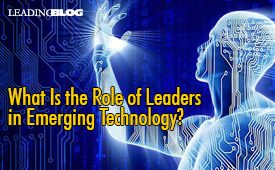 
Posted by Michael McKinney at 05:24 PM
04.26.17

Stretch: Unlock the Power of Less
I We are under more pressure than ever to do more. The idea that we can stretch and do more with what we already have begins to remove us from the dehumanizing rat race for resources that is impossible to win. Chasing limits us. Stretch liberates. Especially in uncertain times, “stretching equips us with the abilities to adapt and change when facing a less predictable set of circumstances.” One of the reasons we chase instead of stretch is because fail to see how we might see a resource beyond its traditional use. It’s also easy to assume that if we just had more money we could spend our way out of our problems. It’s often easier to acquire things than to think about how to use those same resources in more productive ways. “The problem is that chasers become so fixated on acquiring resources that they lose sight of what those resources will do for them” so we end up squandering them. We need to place more focus on what we already have. “Stretchers find beauty and richness in places where others struggle to see anything of value. Too often, we understand, interact with, and use things at face value, locking ourselves into conventions that limit possibilities.” Our creativity is sparked by constraints. Filmmaker Robert Rodrigues comments: The creative person with limitless imagination and no money can make a better film than the talentless mogul with the limitless checkbook every time. Take advantage of your disadvantages, feature the few assets you may have, and work harder than anyone else around you. Outsiders can often stretch by seeing possibilities that we can’t because we are the expert or just too close to the issue. “Breadth of experiences helps people stretch.” The well rounded often outperform those who are deeply focused on a single thing especially when trying to solve complex problems. It makes a case for a liberal arts education. We need to repeatedly go outside ourselves. “Temporary departures from our small worlds can come from short bursts of new activities such as reading about another field, finding a hobby, or having conversations with people from different backgrounds.” Stretching is not about being a cheapskate. There is a difference between frugal and cheap. A Stretching Roadmap In summary, here are a dozen ways Sonenshein suggests to help get us into the stretching habit. Just Say No Find a Sleeping Beauty
Go Explore
Take a Break (and Pay Less Attention)
Pick New Neighbors
Appreciate
Shop Your Closet
Scramble the Back Row
Make Midyear Resolutions
Break it Down
Turn Treasure into Trash
Stretch is a very well done book. Good and relevant examples give power to the points he is making. By chasing resources we really limit our potential. Stretching brings out our best. 

Posted by Michael McKinney at 05:55 PM
04.07.17

The 9 Behaviors of Great Problem Solvers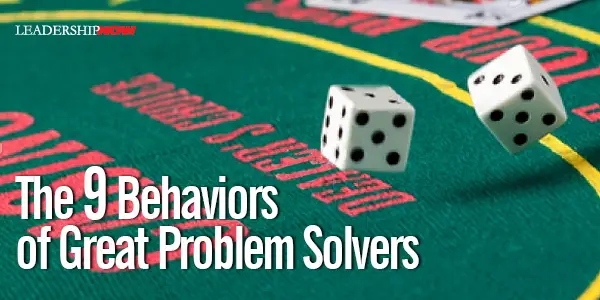
E Naturally we like simple solutions. But a simple guess is not the same thing as a simple solution. A simple solution is easy to implement. But a simple guess that doesn’t get to the real issues is difficult, expensive, and wasteful to implement. We need to stop guessing. “Every unsolved problem is bottlenecked by not understanding the root cause at a fundamental level.” In Stop Guessing, Nat Greene explains 9 behaviors that great problem-solvers use to solve hard problems. Here are his behavior summaries: 1. Stop Guessing It’s natural for us to guess. The first thing you must do to start solving problems or keep from making them worse is to stop guessing. 2. Smell the Problem Get out and walk around using your natural senses and tools available to you to develop a strong pattern of failure. Ask relevant, thought-provoking questions about the specific problem to guide you to collect information and look for very specific patterns, rather than shotgunning and looking at everything in the system. 3. Embrace You Ignorance It’s what you don’t know that lies between you and the solution. Great problem-solvers not only admit their ignorance but also embrace it and ask questions others might find “stupid,” to shatter old assumptions about the problem. 4. Know What Problem you’re Solving Often, people work on the wrong problem entirely by making some implicit assumption about what’s causing it. Great problem-solvers invest time upfront to make sure the problem they’re working on is well defined, measureable as a variable, and represents precisely what is wrong with the system or process. 5. Dig into the Fundamentals This means learning how the process works, both by understanding the process itself and by understanding some of the fundamental science behind it. By focusing on what controls a problem, you’ll be able to limit your digging to the parts of the process and the science that are relevant, rather than trying to wrap your arms around the entire thing at once. 6. Don’t Rely on Experts Utilizing subject-matter experts is crucial to understanding a complex system and its underlying functionality and science. Unfortunately, most people delegate responsibility for solving the problem to those subject-matter experts, rather than driving the problem-solving process themselves. Great problem-solvers always view experts as collaborators rather than saviors. 7. Believe in a Simple Solution When confronting complex problems, it can be comforting to believe that the solution will be complex as well. But by not believing in a simple solution, people often give up long before they’ve gone through the rigor required to find the simple solution that lies at the root cause, to great cost and detriment. Great problem-solvers will have the belief and tenacity to keep solving until they’ve found the root cause. 8. Make Fact-Based Decisions Avoid making opinion-based decisions: anything that relies on a vote, on authority, or on some subjective ranking system of what decision to make is one of these opinion-based decisions, and it leads problem-solvers astray. 9. Stay on Target When problem-solvers dive deep into a problem, they too frequently seek to expand the number of possible root causes, so they can test them. Great problem-solvers measure the drivers that most immediately control the problem in order to determine whether those subvariables are in control, and in doing so are able to quickly eliminate most possible root causes and avenues of inquiry without having to dive deeper into them. Greene digs deeper in to each of these in separate chapters. Strong problem-solving methods will discourage guessing, provide lots of structure to develop a pattern of failure, and guide you to understand how the process works. Begin problem solving and not solution-guessing. 
Posted by Michael McKinney at 10:59 AM
03.24.17

The Caterpillar's Edge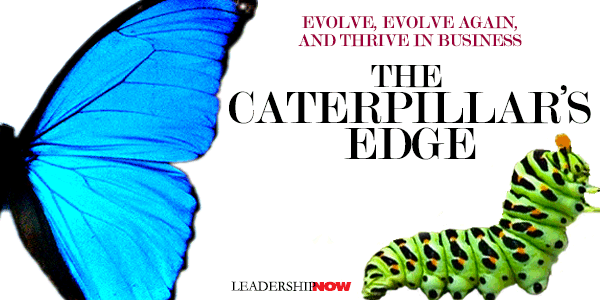
T Sid Mohasseb writes in The Caterpillars Edge that “to realize an improved future you must purposefully leave the past behind, and embrace the uncertainty ahead—constantly and without fear. You must evolve, then evolve again and thrive.” The problem as Mohasseb sees it is that many leaders are stuck in their approach to planning and execution. “They are guided by old habits formed in an era when competition was more static.” The data you are using can’t be captured in a fixed plan or you’ll have an excellent strategy for the year before. Your planning and execution needs to be more dynamic than that. We need a new and more agile approach. “The world will not wait while you contemplate, take time to gather enough data to be exhaustive in your analysis, and then build consensus around actions.” You can improve your “likelihood of winning by constantly reading and applying the incoming data points.” “You must learn and live and compete in an uncertain and always changing reality.” Prefer change to the comfort of stability. There are three crucial rules to be applied here: 1. Align with Uncertainty—Adjust to the dynamic world around you. Be prepared to shift your focus at all times. The market is shifting. By the time you transform, the advantage you wanted may be long gone. 2. Appreciate Reality—Understand what is practical and achievable by you and your company. You can evolve over and over. 3. Aspire for More—Seek more data, more analysis, and more “Aha” moments or move faster to reach the moments of insight, where the solutions to problems become clear. McKinsey reports that eight out of ten times strategists focus on known hypothesis—opportunities that have been examined in the past or are already evident. “Most people use analytics in the context of consumer-level transactions. But there is no lasting strategic advantage. When people claim that they are competitive because they are using analytics, that’s just the flavor of the day. Now unless you tell me that you have used data analytics in order to find a new product ground, a new design, and a new market, you are not strategic . . . as opposed to let’s sell more shoes to the guys who are buying shoes . . . what is being done for the most part today is a kind of a tit for tat, and that’s what I see most people calling gaining competitive advantage.” Optimizing today’s processes for greater efficiency does not necessarily offer an advantage for tomorrow. Use the force and create the future. Don’t use the data to justify your actions, use it to discover advantages. It’s not the analytics, but the execution. Analytics is just and tool and soon will be found and used by everyone everywhere. As that occurs, the “business basics of good strategy and execution will, once again, drive the lasting victories.” A winning strategy must be adaptable from the start. Be prepared to improvise. Selected Caterpillar Edge advice:

Posted by Michael McKinney at 12:34 PM
10.05.16

5 Questions to Ask When Managing in the Gray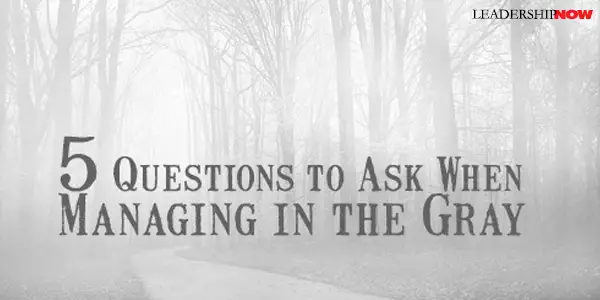
JOSEPH BADARACCO PROVIDES A WAY to resolve the inevitable gray areas we will all face from time to time in Managing in the Gray. It is the core of a leaders work. Gray areas demand our best judgment. The five questions provide a way to get there. They are “a distinctive way of sizing up gray area issues, analyzing them carefully, grappling with their full, human complexity, and then—and only then—making final decisions.” Avoid the temptation to skip a question or pick a favorite. “This approach improves deliberation and judgment because the questions complement, correct, and strengthen each other.” 5 Questions to work through the gray of difficult decisions: What are the net, net consequences? The critical first step requires thinking deeply putting aside your own self-interest. Don’t oversimplify. That means don’t just think about those things you can put a number to. “Life is a rich canvas, not a cartoon.” Understanding the net, net consequences means thinking in terms of “everything that matters to us as human beings: hope, joy, security, freedom from hazards, health, friendship, and love, risk, suffering, and dreams.” What are we trying to do for people, not to them? Keep in mind we have a strong self-enhancement bias. We tend to see too quickly. The process is important when working on gray area problems. “How you work on a problem can be as important as what you ultimately decide to do.” Get the right people in the room. Assign a couple of people to play devil’s advocate. Begin by developing a list of things you could do as opposed to what you should do. Then work out the possible outcomes of each possibility. What are my core obligations? “When trying to resolve a gray area problem, you have to develop an answer—for yourself—to the question of what your core human obligations require you to do and not do in the situation you face.” In a business situation, it is important to take a hard look at the economics but at the same time, you need to look past the economics and try resolving the issue like a human being. When looking at a gray area problem you must awaken your moral imagination. Edmund Burke described it as a “reaction to a situation that the heart owns and the understanding ratifies.” Again, make it part of the process. What will work in the world as it is? More than what will work. What will work in the world as it is? Don’t let idealistic notions distort your thinking. “If you have serious responsibilities, you must avoid the trap of seeing the world as you want it to be.” “The question asks managers if they are prepared to do what is necessary in this world—to serve the interests of people who depend on them and also protect themselves and advance their own objectives.” The question becomes, “How resilient is my plan and how resilient am I?” Badaracco offers five steps to help you answer with eyes-wide-open realism. Who are we? This questions guides leaders to see their identities as woven into the fabric of their surrounding communities. “It then encourages them to seek options that will reflect, express, and give reality to the norms and values of the communities to which they belong.” We are social creatures. “It is relationships, values, and norms that make us who we are.” See the problem in context. “When you face a hard gray area issue, you should spend a few minutes stepping back and trying to understand the situation in terms of some of the defining experiences in your organization’s history that matter to you and help you understand what your organization stands for.” What can I live with? Not what is best or right, but what you can live with. After all is said and done It is quite possible—even probable—that you will not find a solution. If that’s the case you have to create an answer you can live with. It means “you did all you could, but you’ve only met a minimum standard of acceptability.” And of course, you have to take responsibility for it. “Gray area decisions inevitably reflect and reveal the personal priorities of the person who makes them.” And so these kinds of tough questions push you to reflect on what you can live with. They test competence and character. What are your convictions? Alfred P. Sloan wrote in his autobiography, “The final act of business judgment is, of course, intuitive.” Badaracco concludes: “Men and women should approach gray area issues as managers and resolve them as human beings.” 
Posted by Michael McKinney at 04:09 PM
01.22.16

Why Most People Never Learn from Their Mistakes
THE purpose of Black Box Thinking is to describe how success happens. Progress hinges on how we react to failure. In two of the most safety-critical industries – aviation and health care – the approach to failure is very different. And the results highlight the problem. For commercial aviation on Western-built jets, they have only one accident per 2.4 million flights. In health care, the equivalent of two jumbo jets are falling out of the sky every twenty-four hours making preventable medical error in hospitals the third biggest killer in the United States behind only heart disease and cancer. The problem lies in how they approach failure. “A failure to learn from mistakes has been one of the single greatest obstacles to human progress.” For all of the talk about not being afraid of failure, we are not learning what we should. Our organizational and personal cultures tend to evade and cover-up the issues. How do we react when something has gone wrong?  The author, Matthew Syed, describes black box thinking as “the willingness and tenacity to investigate the lessons that often exist when we fail, but which we rarely exploit. It is about creating systems and cultures that enable organizations to learn from errors, rather than being threatened by them.” Why? “Failure is rich in learning opportunities for a simple reason: in many of its guises, it represents a violation of expectation. It is showing us that the world is in some sense different from the way we imagined.” Nicely put. Learning from failure is easier said than done. The more we have at stake (especially our egos) the more likely we are to manipulate the evidence. Consider this: When we’re confronted with evidence that challenges our deeply held beliefs we are more likely to reframe the evidence than we are to alter our beliefs. We simply invent new reasons, new justifications, new explanations. Sometimes we ignore the evidence altogether. One of the difficulties we have when analyzing failures (and analyzing success for that matter) is that we rely on information based on hunches. Our intuitions are often wrong. We need to get down to the details so we can isolate the effect of any action so we are solving the right problem. David Brailsford, the general manager of the British cycling Team Sky put it this way: “People think it is exhausting to think about success at such a high level of detail. But it would be far more exhausting, for me anyway, to neglect doing the analysis. I would much rather have clear answers than to delude myself that I have the ‘right’ answers.” An organization (and even individuals) can go on for decades thinking that their success is linked to a particular factor when in reality it is the cause of their failures. And they never make the connection because their assumptions have never been tested or analyzed. We must change our relationship with failure. We are not born with a fear of failure. It’s how we learn. It’s only over time that we are taught a fear of failure and lose our growth mindset. We can only improve in environments where we have the right kind of meaningful feedback. Fear of failure is not the real enemy; it is recrimination and defeatism that often accompanies failure. We need to eradicate blame and encourage growth responsibility. Syed writes: “If we drop out when we encounter problems, progress is prevented, no matter how talented we are. If we interpret difficulties as indictments of who we are, rather than pathway to progress, we will run a mile from failure. Grit, then, is strongly related to the Growth Mindset; it is about the way we conceptualize success and failure.” Through the use of a wide variety of examples, Syed pushes you to think differently about failure and success. More importantly, he teaches us how to look beyond our easy answers and effectively get to the real issues and causations. 
Posted by Michael McKinney at 09:13 AM
11.11.15

A Framework of Organizational Tensions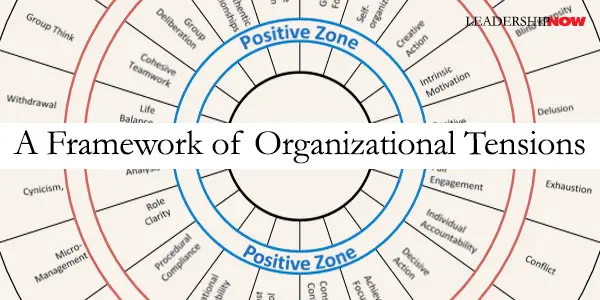
TENSIONS are objectives that seem to be in conflict. They are values that seem to be in opposition. We often treat them as either/or choices when they should be treated as both/and dynamics. Each value or characteristic supports and even makes possible the competing value. Robert Quinn has produced a valuable tool for understanding this concept in his book The Positive Organization. What makes it especially valuable is that it illustrates the options we have to the single values we hold so dear—there are possibilities and equally effective “right” solutions we can use to move us forward. We tend to focus on the value that resonates most with us or the ones we are most familiar with. This often causes us to get stuck or to jump from one ditch to the other never realizing the true potential of our organization. (This dynamic plays out in our personal lives as well.) 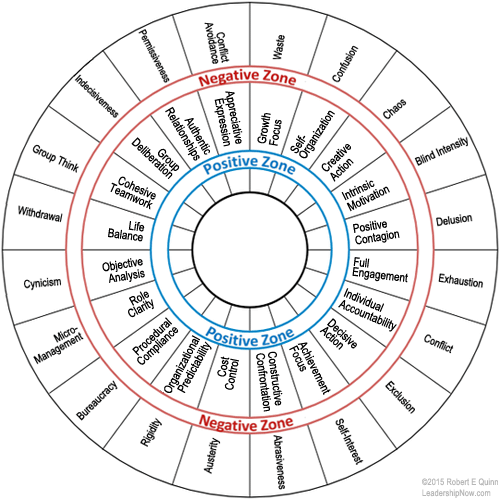 You will notice that each of the positive values in the inner circle is associated with a negative value on the outer circle. If we champion one value over another we put our organizations at risk for the negative outcomes associated with each of the 20 values on the diagram. Every positive value without its contrasting value can become a negative in much the same way the overuse of a strength becomes a weakness. For example, we need some predictability and control in any organization, but too much leads to rigidity. We also need some spontaneity and self-organization for people to flourish, but again too much can lead to organizational and personal chaos. We also miss the larger picture and usually misinterpret issues.  A person who seeks a predictable, smooth running organization often focuses on disruptions and disruptive influences; the natural inclination is to fix those disruptive problems. When we focus on a problem, we are not seeing the whole system. We are paying attention to something within the system. Likewise, when we focus on a single person, we are not focusing on the culture of which that person is a part.When we have an agenda we tend not to see the whole picture. As leaders we need to see the broader context of every situation. It’s not about finding balance. It’s about emphasis—where to place the emphasis and when. Of Related Interest: 
Posted by Michael McKinney at 04:45 PM
02.19.15

6 Skills You Need to Win the Long Game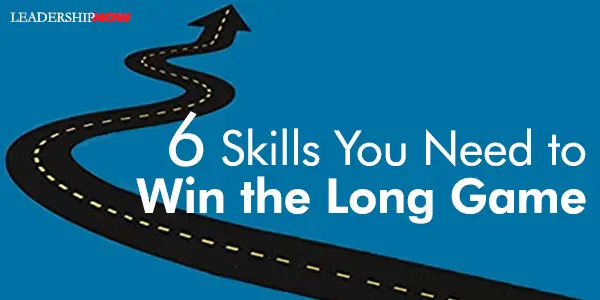
BRIAN DODD says he doesn’t like meetings but he loves strategy sessions because they are about movement and focus on accomplishment, not activity. They “make you glad you are a leader.” I presume he would agree with authors Steven Krupp and Paul Schoemaker. They say the number one business challenge for winning the long game is for leaders to become more strategic. In Winning the Long Game they write that “In times of crisis and change, when people are confused about what to do, ordinary leadership must rise to the level of strategic leadership.” The trick is to deliver short-term results while securing long-term viability. Especially in uncertain times, “companies must tilt more toward strategic leadership than toward operational excellence.” Strategic leaders need two perspectives: outside in and future back. Outside in means that a “strategic leader starts with the external marketplace when addressing problems, without getting wrapped up by internal organizational issues.” Future back means that when playing the long game strategic leaders use their long-term vision to guide their short-term decisions in a flexible way.
Anticipate: Strategic leaders are constantly vigilant, honing their ability to anticipate by scanning the environment for signals of change. They develop and maintain an external mindset. How quickly do you spot ambiguous threats and opportunities on the periphery of your business? (Chapter 1: Elon Musk) “Once a company becomes the master of its own universe, seeing new developments in adjacent markets becomes harder. Challenge: Strategic leaders question the status quo. Pope Francis is listening to new voices and deliberately bypassing old channels of communication. Open a window to let in fresh air and look in the mirror. Are you comfortable with conflicting views and differences in opinion? How often do you question your own and other people’s assumptions? (Chapter 2: Sir Richard Branson, Pope Francis) “Opening the window is the practice of promulgating outside perspectives to see complex issues in context. Looking in the mirror is the practice of deep self-reflection, whereby leaders confront outmoded beliefs, faulty assumptions, and stubbornness in themselves and others.” Interpret: Strategic leaders amplify signals and connect multiple data points in new and insightful ways to make sense of complex, ambiguous situations. Can you pick up on signals to distinguish anomalies from leading indicators of change? What are you not seeing or hearing? We begin by recognizing the facts and then “re-cognizing,” or rethinking, them to expose their hidden implications. (Chapter 3: Charles O. Holliday Jr.) “Leaders get blindsided not so much because they aren’t receiving signals but because they aren’t exploring alternative interpretations, or they get locked into one piece of the puzzle.” Decide: Strategic leaders seek multiple options to ensure flexible decision-making. They don’t get prematurely locked into simplistic yes/no choices. How often and how quickly must you make tough calls with incomplete information? (Chapter 4: Angela Merkel, Laurence Golborne) “Exploring options means having the wisdom, cool-headedness, and perspective to consider all of the alternatives available. Showing courage means demonstrating the fortitude to commit to the right solution and, if that solution proves ineffective, critically stepping back to reconsider.” Align: Strategic leaders engage stakeholders to understand change readiness, manage differences and create buy-in. They are adept at finding common ground. This requires active outreach. Good communication is key. Do you regularly engage your managers’ direct reports in decisions that affect their work? Where do you stand with the people you need to influence? (Chapter 5: Alex Ferguson) “There is an interconnectedness now in problems—and this changes the issues. You need to have more people involved with the decision making, leaving the leader less in control of the situation.” Learn: Strategic leaders continuously reflect on successes and failures to improve performance and decision-making. I like this chapter title: My Gift Was Not Knowing. It sums it up well. A quarter of a century after the publication of Peter Senge’s The Fifth Discipline, “the learning organization still does not have much of a foothold in the business world, despite skyrocketing uncertainty.” When was the last time you admitted you were wrong—in public? (Chapter 6: Reed Hastings, Sara Blakely) “Leaders must make their moves when the future is still ambiguous. If an organization is continually learning, then everyone is primed for change and ready to move in a different direction each day.” 
Posted by Michael McKinney at 11:27 PM
10.28.14

The Power of NoticingHarvard professor Max Bazerman believes in the power of noticing. Sometimes we get so focused on what is right in front of us that we miss the critical information that would help us to make better decisions.The Power of Noticing guides us through what happens when our focus can prevent us from seeing the critical information we need to make better decisions. Focusing too narrowly on the information in front of us is common too us all. Where we would never do it in certain situations we can easily do it in others. Loyalty creates “blinders to full awareness and action.” Personality cults end badly for this very reason. “When we have a vested self-interest in a situation, we have difficulty approaching that situation without bias, no matter how well-calibrated we believe our moral compass to be. We want to think the best of our kids and spouses, and we’re disinclined to speak against those with influence in our offices and our occupations.” And so we don’t speak up when we should or we miss the kind of information we need to make the best decision. “Through our silence and complacency we accept and promote corruption.” When we don’t take the time to notice growing issues or simply chose to ignore them, corrupt systems develop around us. Sometimes we don’t get the information we need or fail to see the obvious because of misdirection. Thinking logically helps us to avoid this kind of decision-making trap. “When you start to stray from logic, and another person is involved, whether she is a negotiator, marketer, or politician, it is time to put yourself in the shoes of the other party, understand her motives, and adapt accordingly.” We are also unlikely to notice gradual changes. It is easy to miss or more likely to accept changes in ethical behavior until it’s too late because of this slippery slope effect. “Too often executives have engaged in unacceptable behavior not because they intend to defraud but simply to justify the mess that they got into.” There are more obvious things we don’t notice or rather do notice but our human nature gets the best of us. Things that are “too good to be true” require investigation. Bazerman explains why penny auctions are nothing but gambling. The house always wins. “Thinking one step ahead allows you to identify when to be trusting and when to be cynical.” It is wise to think through the indirect effects of your organizational policies and goals. What is the possible downside? What might it cause people to do unintentionally? “Focusing is important, but sometimes noticing is better—at least when you are making critical decisions.” Of Related Interest: 
Posted by Michael McKinney at 06:53 PM
08.21.14

Get Advice from People Who Have…Giving decisions to people closest to the action can transform any organization says Dennis Bakke in The Decision Maker. In a decision-maker organization, the leader leads by choosing a decision-maker based on their proximity, perspective, experience and wisdom.But since we are all human, the decision-maker must ask for advice. The advice process brings multiple perspectives together to guide a successful outcome. But the decision-maker makes the final call—and takes responsibility for it. Deciding who to get advice from can influence a successful outcome. So get advice from people who have: Experience: Has this person had experience with this problem? There’s no teacher like experience. Position: People in different positions see different things. The decision-maker asks a leader, a peer, someone below them in the hierarchy—and even, if circumstances warrant, experts from outside the company. Responsibility: Decisions have consequences—and decision-makers should be held accountable for theirs. At the same time, nobody is right all the time. The most important part of any decision is that the decision-maker fully engages with the advice process, not just that he or she gets it “right.” Ownership: When people are asked for advice, they start to feel ownership. Ideally, everyone who offers advice works for the success of the project as if it were their own. The advice process isn’t just about getting the right answer. It’s about building a strong team and creating a process of communication that will improve all decisions in a company. 
Posted by Michael McKinney at 08:44 PM
05.05.14

Identifying and Dealing with Paradoxes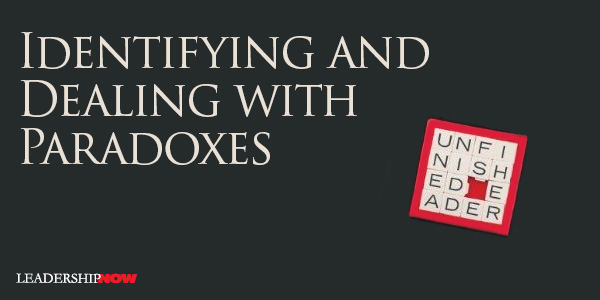
THERE ARE PROBLEMS and there are paradoxes. The trouble is when we treat paradoxes as problems because then our decision-making process becomes paralyzed, inflexible, incomplete, isolated and closed. Paradoxes are recurring issues that are familiar and present throughout organizations today: the conflicting needs of purpose and profit, short- and long-term goals, local versus global demands, and the need for a flatter, more nimble organization that still executes with discipline. Paradoxes deal with uncertainty and ambiguity. They take us away from the familiar, the control, consistency, and closure we seek. If you crave control you won’t handle paradoxes well. Authors David Dotlich, Peter Cairo and Cade Cowan make an important statement in The Unfinished Leader: “The only way to become a finished leader is to remain an unfinished one.” That is to say, a leader open to possibility. “Leading through complexity requires giving up the illusion of control, consistency, and closure, while embracing the reality of being permanently unfinished.” Their research has shown that only about a third of leaders recognize paradoxes and handle them differently than they do problems, another third know they need to, and another third fail to see paradoxes at all. The Unfinished Leader offers ways in which you can learn to think differently about paradoxes and then provide tools for resolving paradoxical problems. Key to resolving a paradox is collaboration and that means letting go of control—sharing control for solving the paradox. It means letting a purpose and not a plan guide your way. “Embracing best practices from others, admitting to not having the solution, and absorbing the variety of the world prepare you to identify paradoxes and select right actions.” I’ll leave you with three thoughts from The Unfinished Leader: Too often, people do not adequately develop the interpersonal skills for collaboration, do not get beyond the thirst for control, consistency, and closure, do not work to mitigate their personal derailers, and do not overcome the human reluctance to act in the face of ambiguous, paradoxical problems.If we had leaders that would declare they have to collaborate more intensively to find actions that ameliorate things now and demand a fresh look later, we would have leaders we all could call role models: Leaders who demanded problem-solving control, yes, but yielded to paradox-solving delegation. Who demanded consistency of values and purpose, but embraced flexibility in thought and action. Who demanded closure for tame problems, called for ongoing management of society’s most wicked ills. These kinds of leaders would indeed include disciples of analysis, decision making, and execution. But they would also include masters of inquiry, collaboration, and action in the face of ambiguity.   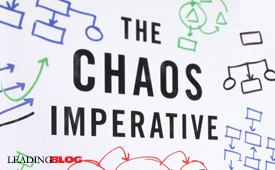
Posted by Michael McKinney at 08:04 PM
03.13.14

The Moment of ClarityIn a time of turbulence and uncertainty finding clarity and direction is the job of the leader. To make this happen, authors Christian Madsbjerg and Mikkel Rasmussen argue in The Moment of Clarity, we more often than not rely upon traditional, hypothesis driven, quantitative, and linear, decision making. This works well when there is a well-established relationship between cause and effect. But creating and seeing ahead into unchartered territory require a different kind of leadership skill: sensemaking.While still clear on goals and priorities, sensemaking requires “the ability to lead open-ended discovery, to sense both soft and hard data, to use your judgment skills, to connect the dots, and to see the big picture in a vast ocean of sometimes conflicting data.” When it comes to cultural shifts, the use of hypothesis based on past examples will give us false sense of confidence, sending us astray into unknown waters with the wrong map.Sensemaking leaders have three fundamental characteristics:
Sensemaking provides a way to makes decisions based on understanding people as they are. 
Posted by Michael McKinney at 11:46 PM
10.30.13

The 8 Elements that Bring People Together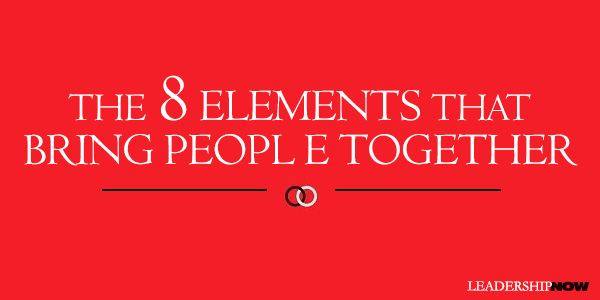
WORKING together to solve a common problem provides us with a more complete picture of the problem, and can offer us more options, synergies, and solutions than we could achieve by working alone. Many of the issues we face will require collaboration at some level to solve or even manage them. In Finding Allies, Building Alliances, authors Mike Leavitt and Rich McKeown, state, “The ability to get things done with collaborative networks is the next generation in human productivity.” We need to be able to form and work with and through value alliances. Value alliances are “a group of participants with aligned interests in pursuing an outcome with value for each of them.” These alliances can last long enough to solve the issue they came together to solve or they can be ongoing as an alliance enterprise to oversee the solution to the problem. But value alliances are not always easy. “Value alliances require that participants subordinate their egos, their agendas, their preferred styles, and their biases—not to mention their organizational agendas—in favor of a shared benefit.” Some people just don’t have the aptitude—the collaborative intelligence, if you will—to work well with others. “People with high collaborative intelligence make an effort to understand the views and needs of others; they listen honestly, thoughtfully, and objectively. They don’t lock into positions prematurely. While they may possess strong points of view, they make an effort to hear other perspectives and will adjust their points of view once convinced they need adjusting.” The authors have had a lot of experience creating, working with, and successfully resolving problems through effective value alliances. They share the good and the bad and the lessons learned along the way. They answer why you form value alliances, the eight key elements required for a collaborative effort to succeed, how you select productive participants, and how you deal with the inevitable issues that come up dealing with other people. Their case is well thought out and clearly presented. From their experience, they have discovered why some collaborative efforts have failed and why others have succeeded. From that background, they detail the 8 elements required for a collaborative network to succeed: 1. A Common Pain is a shared problem that motivates different people/groups to work together in ways that could otherwise seem counterintuitive. Value alliances “exist at the intersection of self-interest and common interest.” We often become collaborators when we discover that we can solve a problem on our own. “Few people are willing to place themselves in a collaborative position of they have an alternative.” (As a side note, leaders, because of their position and the authority it brings them, usually have an alternative—my way or the highway. The best leaders collaborate anyway.) Collaborations require time, money, and people. The collaborative process is more complex, slower, and messier than independent decision-making. To be willing to give up a degree of independence and control, a given leader must believe the problem poses a serious threat to the enterprise. 2. A Convener of Stature is a respected and influential presence who can bring people to the table and, when necessary, keep them there. “The inability to turn down an offer is one sign that you’re dealing with a convener of stature.” The book lays out the roles and responsibilities of the convener. 3. Representatives of Substance. The collaborative participants must bring the right mix of experience and expertise for legitimacy and have the authority to make decisions. Look for participants who possess at least one and ideally all three varieties of substance: authoritative, cognitive, and reputational. Sometimes it is wise to create additional layers of participants beyond the primary or core group. “Omitting people from the collaboration often guarantees that they’ll become external critics or even saboteurs.” 4. Committed Leaders are individuals who possess the skill, creativity, dedication, and tenacity to move an alliance forward even when it hits the inevitable rough patches. Value alliances require committed leaders who fulfill many of these ten roles: organizer, diplomat, technician, teacher, counselor, matchmaker, salesperson, referee, judge, and disciplinarian. “If committed leaders can consistently achieve consensus, they will move the alliance forward. Finding consensus is an art form that alliance leaders must master.” 5. A Clearly Defined Purpose is a driving idea that keeps people on task rather than being sidetracked by complexity, ambiguity, and other distractions. It is important to identify and deal with purpose creep—“an inexorable broadening of scope that eventually makes it impossible to relieve the common pain that drew the group together in the first place.” The authors provide a step-by-step guide to creating a purpose in a collaborative setting. They advise, “Find a golden mean: big enough to matter and small enough to do.” And add, “As a committed leader, you need to develop a sixth sense for when people are setting goals that are too difficult to achieve or too wide-ranging; you also need to grasp when you’ve shrunk the purpose to the point that its achievement won’t have any real impact.” 6. A Formal Charter establishes rules that help resolve differences and avoid stalemates. The three crucial parts of a charter are: the Purpose section, the Principles section, and the Operating Procedures. 7. The Northbound Train is an intuitive confidence that an alliance will get to its destination, achieve something of unique value, and that those who aren’t on board will be disadvantaged. The idea is, “decisions that matter to me are going to be made, and I need to be there. The train is headed north, and I want a seat on it.” They explain why a northbound train slows and what to do about it. “The feeling generated by a northbound train is what carries the collaboration to its destination.” 8. Defining Common Ground. “Participants and leaders need to discuss the beliefs and ideas that they take for granted in their collaborative efforts.” A Common Information Base keeps everyone in the loop and avoids divisive secrets and opaqueness. “Defining common standards boils down to the capacity of collaborators to reach foundational agreements.” People are coming from all different places with different values and beliefs, but to get to the point where there is a recommendation or decision that everyone can buy into and to hold the collaboration together until that point is reached, “Agreement about operating modes and information protocols is necessary.”

Posted by Michael McKinney at 12:43 AM
08.29.13

4 Design Thinking Tools for Engaging Your Team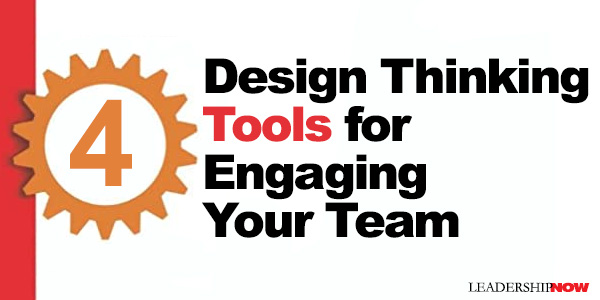
APPLYING the tools of design thinking to help your team conquer its goals doesn't mean hunkering down on your own with an org chart in a dimly lit office to devise the perfect execution strategy. Design thinking is about engaging with your team at its most fundamental levels. It's amazing how many little problems germinate at the earliest stage – the problem definition stage – and expand into bigger problems whose solutions also grow in complexity. Finding clever solutions to big, tough, problems requires harnessing your managerial creativity to really understand the problem you and your team are solving. Creativity—contrary to popular myth—does not emerge spontaneously from nothing. One way to think about creativity is as the novel synthesis of data. Those creative shower moments rely on lots of data. If there is no data to mull over, then it's just a boring showing. Below are four design thinking tools that you, as the manager of a talented team, can use to build a creativity-enhancing dataset. All of that data, cleverly applied, will extend your team's ability to boost its operational and innovative performance. Design thinking is a method for understanding complex problems – to really get at their genesis – and developing ways to eliminate or, better yet, leverage those problems into novel solutions. While this still sounds cryptic and too-good-to-be-true, these tools can sharpen your creativity to help you uncover obscured facts and use your knowledge in new ways. Where problems lurk unnoticed How well do you really understand how your team executes a typical project from day one to the very end? There are different stages in a project. Team members' daily roles can be different depending on the project life-cycle. They have a lot of data some of which may even be hidden from themselves. Journey mapping is the art of observing what is really going on. Where are your team members using improvisations to overcome a process deficiency? Heck, you and your team may be so used to making some shortcuts that you don't even see them. Journey mapping requires careful investigation of the process. Yes, it's time-consuming, but you've probably already solved the easy problems, and finding the really deeply embedded problems requires objective observation. Collectively mulling the data Mind mapping is a method for finding useful patterns hiding in lots of noisy data. All of those observations can get you and your team thinking about what's happening throughout the project lifecycle. You have to help your team articulate those ideas and capture them. Sticky notes are the stock-in-trade of design thinkers. Everyone on the team armed with a block of sticky notes is a source of deep process knowledge and ideas. Getting the team around a table and sharing ideas and recording them on sticky notes is a method of capturing institutional knowledge, some of which may not have been explicitly articulated before. After many rounds of sharing ideas and letting everyone build on ideas, you'll be able to see a rich set of patterns. Use the patterns to isolate problems. Looking for a path Hypothesis generation is about figuring out what creates the problems and how to solve them. Solutions aren't solutions until you know that they work as you expect. Until then, your proposed solutions are just hypotheses. That's a pretty powerful notion really. Hypotheses can be wrong or need tweaking and that's fine. Your team can offer hypotheses without the turmoil of suggesting solutions that may fail. Figuring out if a hypothesis holds water is easier and more productive than starting at this point to create The Solution based only on the data that you have so far. Hold back on jumping to The Solution. There are still steps that will help produce even better outcomes. Using your hands to activate your brains Prototyping helps you prove or disprove the hypotheses. You can prototype anything including processes. Allow time and space to try things out physically. PowerPoint presentations full of fancy renderings are good for generating excitement. Prototypes generate hard data, not ephemeral comments about ‘good ideas.' Prototypes are ideas that you and your team touch and are often underestimated beyond the world of product design. How do these design thinking tools boost your managerial creativity and your team's achievements? Our research with high performing teams at large multinational companies like Toyota and IBM all the way to non-profit organizations that have used design thinking has uncovered many team enhancements. These activities listed above engage the whole team. These steps work best when as many of the team members participate as possible. There's a boost in cross-team communication enriching collaboration. A better communicating and collaborating team ultimately generates comprehensive ideas leading to higher-quality activities. Your management skills will help them spend time really understanding the problem. Too often we want to start working on The Solution. Disruptive and highly valuable innovations come from really understanding the problem and finding a solution that really nails the problem rather than put a bandage over the symptoms. It takes a creative manager to engage their teams deeply, and that deep engagement engenders trust and sense of purpose.  
Posted by Michael McKinney at 09:42 PM
08.15.13

9 Tips to Avoid Getting Sidetracked
TOO OFTEN WE think we know exactly what is going on in our minds and what is affecting our behavior. Even though we are committed to our plans we find that the end result bears little resemblance to our best intentions. Somehow we get sidetracked. We face internal pressures, relational pressures, and external pressures to take us off course. These pressures keep us from being consistent with our self-image as capable, competent, and honest individuals. In Sidetracked, Francesca Gino has highlighted nine reasons we get sidetracked—why our decisions get derailed—and provides solutions to avoid them. Here are nine tips to avoid getting sidetracked:Raise your awareness of the subtle influences on your decisions. For instance, our biased views of how competent and capable we are can make us unwilling to listen to the opinions of others. We tend to value expensive advice over inexpensive advice. Take your emotional temperature before you make a decision to see if an unrelated event is affecting the decision at hand. Our moods affect our decisions. Ask, "Is this emotion clouding my judgment?" The emotions we experience while implementing our plans can sidetrack us. Zoom out to include more information when making our decisions. Ask: "Why did I choose the information that I did?" "What information am I missing?" "What was my initial plan?" and "Why did I embark on this course of action?" Take the other party's point of view. We tend to overestimate the extent to which others share our attitudes and feelings, to believe that others have more access to our internal states than they actually do, to use ourselves as a standard when evaluating others, and to draw on our own experiences when anticipating how others will evaluate us. What seems obvious to us is not always obvious to others. Question your bonds—your links and similarities—to those around you and consider whether these bonds may be influencing your decisions for the worse. The behavior and decisions of others not only affect the decisions we make but the conclusions we reach about other people. “We don’t have a stable moral compass.… What I’ve found in my research is that it’s easier to pick up the unhealthy habits of others than to be swayed by their good behaviors.” Check your reference points to consider the motives—social comparisons and emotions—behind your decisions. "The way we define and understand ourselves is an inherently social process….Our decisions are biased by the comparisons we strategically choose in order to alter how we see ourselves." By becoming more attentive to frames, we can become less influenced by them. Consider the source to determine if your judgment is warranted based on all the information available to you. Are you evaluating the right information? "We tend to "rely on irrelevant, but seemingly important, information when making judgments." Investigate and question the frame to see its impact on our behavior or decision. A change in framing can cause us to accept or abandon our carefully thought out goals and plans. How we frame things dramatically affects our acceptance and commitment. In an interesting study the author and others conducted, they found that framing the orientation and training process in a way that encourages self-expression of personal identities and signature strengths produces beneficial effects for the employees and the organization—namely motivation and retention. Make your standards shine by putting them first and discussing them more often. Too often we just need the right opportunity to come up with a reason to reinterpret our behavior. 
Posted by Michael McKinney at 02:48 PM
03.12.13

Leadership and the Art of Struggle: 5 Things You Can Do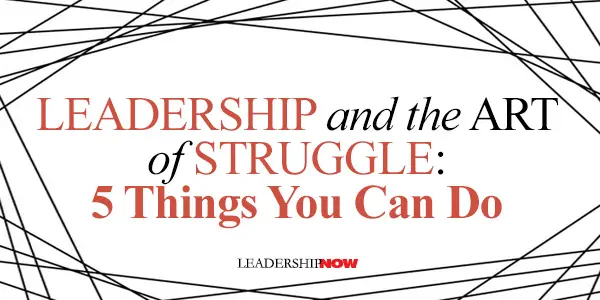
STRUGGLE is a part of any human endeavor and leadership is no different. The problem is we view struggle as a negative. But struggle is how we grow. Without them we can’t reach our full potential as leaders. We like to think of our leaders as flawless. We like to be perceived as flawless—or at least we like people to think we have everything under control. But as Joe Badaracco has pointed out, “leadership is a struggle by flawed human beings to make some important human values real and effective in the world as it is.”It may sound counterintuitive, but considering the benefits illuminated by Stephen Snyder in Leadership and the Art of Struggle, we should welcome it as an important element of the leadership process and our own personal development. Snyder writes that we should face struggle “head on—not hiding from it or feeling shame—because struggle is the gateway to learning and growth.” It can also help us to discover our purpose and meaning and develop the adaptive energy necessary to sustain our leadership for a lifetime. Struggles have three defining characteristics:
In the world we live in today, this is a common occurrence often leading to burnout unless we learn to see struggle through a different lens. Snyder recommends: Adopt a growth mindset. The first step in accomplishing this is through reflection—being aware of what is going on around you. Snyder’s former colleague at Microsoft, Frank Gaudette, used to say: “I reserve the right to wake up smarter every day.” A good mantra to make our own. Center your mind, body and spirit. We all need some way to anchor ourselves and gain perspective that we practice daily like exercise and diet, prayer, connecting with nature, meditation, and/or journaling. Build your support community. “Create a community of people whom you can connect and bond with and from whom you can seek advice and feedback.” Overcome your blind spots. Blind spots by their very nature are hard to recognize. And they are frustrating because they blind us from seeing why people may be responding to us in counterproductive ways—leading us to finger pointing rather than personal responsibility. “Blind spots,” writes Snyder, “are the product of an overactive automatic mind and an underactive reflective mind.” A fairly common blind spot Snyder calls the Conflict Blind Spot. This blind spot can cause someone to interpret every interaction through a distorted lens. It reinforces the perception that the other person is wrong and we are right. Recommit, pivot, or leap. When we struggle we have essentially three options. The first is to recommit and stay the course. The second is to pivot and make a course correction. And third is to leap into uncharted territory far beyond our comfort zone. Choosing the right option requires that we examine ourselves and determine which choice is most consistent with our personal values or mission statement. Every struggle is a chance to learn and to confront who we are and what we are becoming. Seen in that light, they are a gift. And our ability to deal with our own struggles effectively has an impact on those around us. Not only does it create a more positive environment to function in, but it provides a constructive example for others to follow. Snyder has written an outstanding and practical book to help us to rethink the challenges and problems we face along the way. One of the best you’ll ever read on the topic. (The Adaptive Leader Profile is available from Snyder Leadership Group.)

Posted by Michael McKinney at 10:27 PM
01.24.13

Remember, It Was Once Someone’s Good Idea
MANY, if not most good ideas are not good forever. Over time they lose the luster they once had. They become irrelevant and ineffective. The universal danger we all face, is that we get so comfortable with what we do that never recognize that moment when it no longer serves the why. So it is good to periodically take a look at why we do what we do. But it is important to remember that they were once good ideas. Someone once fought to get the idea implemented that you are now trying to change. When we want to change the status quo, we need to approach it from the knowledge that someone had a good reason to make the decision they made. We should honor that. If we approach it in a way that is adversarial, judgmental or dismissive, we diminish and dishonor ourselves and others. When advocating a change, we need to be sure we are informed with the thinking behind the decisions of those that have come before us. When we do, we demonstrate that we are: Reasonable. We see the value in taking advantage of the experience of others.
People are more likely to look at your vision if they know that you have first taken the time to understand theirs. It promotes trust and creates a connection from which to lead.
Posted by Michael McKinney at 04:56 PM
01.21.13

5 Things Smart Risk Takers Do Well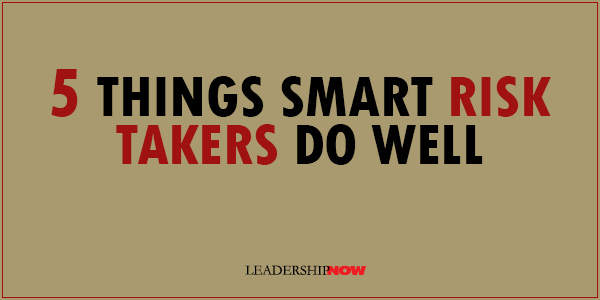 Doug Sundheim’s book, Taking Smart Risks, isn’t really about making your next risky decision smarter or safer; it’s about pushing all of your choices to be riskier, but smarter on a daily basis.
Doug Sundheim’s book, Taking Smart Risks, isn’t really about making your next risky decision smarter or safer; it’s about pushing all of your choices to be riskier, but smarter on a daily basis.
We tend to view our choices as risky or safe. Safe is good while risky is well, risky. You’re taking a chance with a risky choice; it could lead to ruin. Sundheim says that view doesn’t capture the essence of what taking a risk is all about. Taking a risk is “exposing oneself to the possibility of loss or injury in the hopes of achieving a gain or reward.” It’s really the reason we would consider taking a risk rather than just playing it safe. It’s not an either/or proposition—safe or risky. But because we perceive it that way, we tend to do all we can to avoid risk and stay in our comfort zone.  • You don’t win.
Are you caught in the comfort zone? Here’s a thought we can all relate to: Being caught in the comfort zone doesn’t mean that you’re sitting around doing nothing. It’s more nuanced than that. You could be making progress, but not quickly enough. You could be taking chances, but not boldly enough. You could be going out on a limb, but not far enough, and the extra push is what will make a difference. What Sundheim is advocating is a change in our mindset regarding risk. Rather than perceiving risk as negative (“Things may not be perfect now, but they’re not all that bad. If I make a move, things could end up worse. I’d better not risk it.”), we should view it as a balanced focus on both the downside of taking risks and not taking risks (“I’ll regret it if I don’t pursue this thing. I’ve got to find some smart ways to take risks to move it forward.”). A limiting mindset versus a liberating mindset.
Smart risk takers consistently do five things well to disrisk whatever they’re up to:
Communication is a critical element of each of these stages. “At every stage of any risk, improving the way in which you discuss thoughts, plans, and actions is the single most effective way to derisk the risk, that is, to make it smart.”

Posted by Michael McKinney at 10:34 PM
12.21.12

The Success Equation: Separating Luck and Skill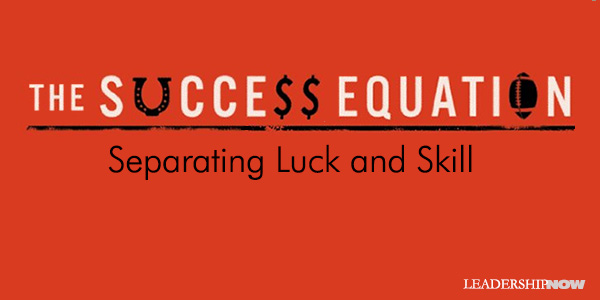
IN the mid-1970s, a man hunted for a lottery ticket with the last two digits ending in 48 for a chance to win the Spanish National Lottery. He found a ticket, bought it, and won the lottery. When asked why he was so intent on finding that number, he replied, “I dreamed of the number 7 for seven straight nights. And 7 times 7 is 48.” You can be wrong and still win—in the short term. Some things are a matter of luck. Some things are a matter of skill. The problem is we have a hard time untangling the two. In The Success Equation, Michael Mauboussin aims to helps us to understand the relative contributions of luck and skill and then how we can use that understanding to make better decisions.Untangling luck and skill is made more difficult because “our minds have an amazing ability to create a narrative that explains the world around us, an ability that works particularly well when we already know the answer.” When we see the effect we want to find (or create) the cause. Baloney-Generator In the left hemisphere of our brain is what Steven Pinker calls the “baloney-generator.” “One of the left hemisphere’s main jobs,” writes Mauboussin, “is to make sense of the world by finding a cause for every effect, even if the cause is nonsensical.” Consequently, we attribute too much to skill, especially in hindsight. “Once something has occurred and we can put together a story to explain it, it starts to seem like the outcome was predestined.”
To understand the relative impact of luck and skill, it is helpful to place activities on a “luck-skill continuum.” Mauboussin shows you how. He also shows why in competitive situations, when you’re the favorite, “you want to simplify the game so that you can overwhelm your opponent. If you are the underdog, you want to inject luck by making the game more complex”—creating new points of competition. In business, “challengers almost never succeed by taking on the established companies in their core markets. The larger companies are simply too strong and too motivated. But they are often too smug to admit that a small, upstart firm could pose a threat. And therein lies the advantage for the little guy.” Building Skill and Improving Your Luck Whether or not you can improve your skill depends a great deal on where your activity lies on the luck-skill continuum, says Mauboussin. “In cases where there is a clear relationship between cause and effect, and in activities that are stable and linear, deliberate practice is the only path to improvement. … For activities near the luck side of the continuum, a good process is the surest path to success in the long run. Feedback is critical in any case. “Improving your skill means constantly looking for ways to change your behavior, either because what you’re doing is wrong or because there’s a slightly better way of doing it. … No matter what your profession or level of expertise, the chances are very good that accurate feedback can improve your performance.” One final thought: Mauboussin presents what he calls the Paradox of Skill. “As skill improves, performance becomes more consistent, and therefore luck becomes more important.” If everyone is getting better, then luck plays a more important role in determining who wins. 
Posted by Michael McKinney at 11:05 AM
11.15.12

Resilience: How We Can Learn to Bounce Forward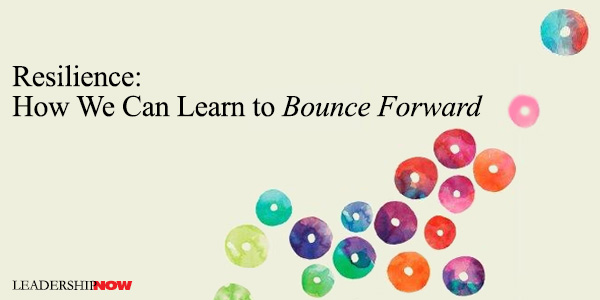
ALL OF US will be tested from time to time on our ability to adapt—on our resilience. The goal of resiliency is not necessarily to bounce back, but to bounce forward. It is the ability to maintain your purpose even while adapting your methods. “If we cannot control the volatile tides of change, we can at least learn to build better boats,” write Andrew Zolli and Ann Marie Healy in Resilience. “We can design—and redesign—organizations, institutions, and systems to better absorb disruption, operate under a wider variety of conditions, and shift more fluidly from one circumstance to the next.” Resilience-thinking is not the same thing as being in a defensive mode. It’s engaging the world in a different way. They discuss tight feedback loops, dynamic reorganization, built-in countermechanisms, decoupling, diversity, modularity, simplicity, swarming, and clustering, as proactive ways to encourage resilience. They don’t give check-lists or quick fixes (indeed, there are none) so you’ll have to think about the ideas they offer. Most of the ideas are quite useful in principle on a personal level. TRANSLATIONAL LEADERS Interestingly—but not surprising—they found that resilient communities had a special type of leader: a translational leader. “These leaders demonstrated an uncanny ability to knit together different constituencies and institutions—brokering relationships and transactions across different levels of political, economic, and social organization.” They were leading from the middle out. Translational leaders do not dispense with hierarchies; they recognize and respect their power. Instead, standing at the intersection of many constituencies, translational leaders knit together social networks that complement hierarchical power structures. Rooted in a spirit of respect and inclusion, these complementary connections ensure that when disruption strikes, all parts of the social system are invested, linked, and can talk to one another. It sounds like they have a high degree of emotional intelligence or ego-control. That necessitates a leader that is reflective and operates from strength rather than weakness; a grounded mindful leader. ADHOCRACY Many of the lessons learned from the disruptions discussed in the book boil down to adhocracy, say the authors. Adhocracy is adaptive, creative, flexible, and non-permanent organizational style. “In the digital age, an adhocracy can be put together in a plug-and-play, Lego-like way, well suited in fast-moving, fluid circumstances where you don’t know what you’ll need next. If it were a musical genre, adhocracy would be jazz.” (Robert Waterman on Adhocracy.) They caution: “When systems are structurally overconnected … or when interventions are bureaucratically imposed on communities rather than developed with them, there is no space for adhocracy to germinate.” Of course formal organizations have a role to play. “But when we focus too strongly on them as the sole actors in response to a disruption, we don’t just ignore, but can actually smother the opportunities for these kinds of successful, improvisational approaches to emerge.” 
Posted by Michael McKinney at 12:22 PM
06.28.12

Innovation at Bell Labs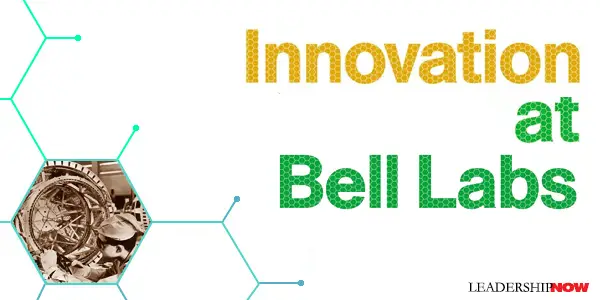
BILL GATES once remarked, “My first stop on any time-travel expedition would be Bell Labs in December 1947,” That was the year Bell Labs invented the transistor—a tiny invention that makes possible the technology we have today. Finding an aspect of modern life that doesn’t incorporate some strand of Bell Labs’ DNA would be difficult. Cellular communications, the laser, digitized and synthesized music, the solar battery cell, the first orbiting communications satellite, and the UNIX operating system, are all products of Bell Labs. AT&T officially created Bell Telephone Laboratories on January 1, 1925. At its peak in the late 1960s’, Bell Labs employed about twelve-hundred PhDs and produced 13 Nobel Prize winners.
 John Pierce is one of the brilliant and interesting people we are introduced to in Gertner’s story. It was Pierce that suggested calling the new device of 1947 a transistor. Peirce was what Gertner calls an instigator. “An instigator is different from a genius, but just as uncommon. An instigator is different, too, from the most skillful manager, some able to wrest excellence out of people who might otherwise fall short.” Pierces real talent was “in getting people interested in something that hadn’t really occurred to them before.” Humans all suffer from a terrible habit of shoving new ideas into old paradigms. “Everyone faces the future with their eyes firmly on the past and they don’t see what’s going to happen next,” observed John Pierce. For creativity to flourish, it needs both freedom and structure. When pierce first came to Bell Labs “he was given free rein to pursue any ideas he might have. He considered the experience equivalent to being cast adrift without a compass. ‘Too much freedom is horrible,’ he would say in describing his first few months at the Labs. Indeed he eventually came to believe that freedom in research was similar to food; it was necessary, but moderation was usually preferable to excess.” Gertner writes, “We usually imagine that invention occurs in a flash, with a eureka moment that leads a lone inventor toward a startling epiphany. In truth, large leaps forward in technology rarely have a precise point of origin. At the start, forces that precede an invention merely begin to align, often imperceptibly, as a group of people and ideas converge, until over the course of months or years (or decades) they gain clarity and momentum and the help of additional ideas and actors. Luck seems to matter, and so does timing, for it tends to be the case that the right answers, the right people, the right place—perhaps all three—require a serendipitous encounter with the right problem. And then—sometimes—a lead. Only in retrospect do such leaps look obvious. When Niels Bohr—along with Einstein, the world’s greatest physicist—heard in 1938 that splitting a uranium atom could yield a tremendous burst of energy, he slapped his head and said, ‘Oh, what idiots we have all been.’” Today there is nothing quite like the Bell Labs of AT&T and Western Electric to produce the creative technology that they did. Bell Labs laser scientist Herwig Kogelnik describes the magic of Bell Labs well: “It’s the interaction between fundamental science and applied science, and the interface between many disciplines, that creates new ideas.” 

Posted by Michael McKinney at 04:54 PM
06.19.12

Are You a Culturematic Maker?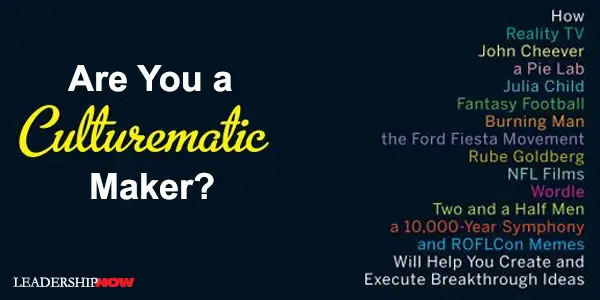
A Culturematic, says author and anthropologist, Grant McCracken, is a little machine for making culture. It is an exercise in edge finding. But at the same time, a Culturematic must speak to us. It must make us go, “Hmm, that’s interesting.” A Culturematic is also an attitude of mind that goes beyond the box of ordinary thinking “not because it is mischievous to do so, but because there might be a world out there and it might be interesting to find out what this world is.” McCracken says that because we live in a world of constant change and because we must adapt to it with an experimental stream of new ideas, we need Culturematics. It is when the problem is too complex or difficult and the solution is not forthcoming that Culturematics shine. Culturematics aren’t sure where they are going. When we aren’t sure what we’re looking at but think, “I’ll know it when I see it,” then we need ideas we can’t possibly guess we will need. “The trick,” says McCracken, “is to invent our own serendipity, to establish a cloud of possibilities in which we can spot the telling pattern.” Start a Culturematic by asking “what if?” Then, try it. The result should discover and distribute meaning. It helps us to see ourselves or something in the world, differently. It should also unleash value—even repurposing value; discovering “value in the artifact the maker does not know is there.” “Culturematics manage a tension between the order of the starting point and the unpredictability and disorder of the ending point.” This is not to say that we point a Culturematic in any direction and pull the trigger. A Culturematic is working with the culture that is already in place, so we point it in the direction where we think we might be able to create meaning and value. Culturematics... • start playing in our heads immediately. They capture our attention.
Fantasy Football, Twitter, and Reality TV are just a few of the examples of Culturematics discussed in the book. More can be found at the Culturematic Pinterest site. Culturematic is not based on entirely new ideas. However, it will not only make you look at the world (and what you are doing) differently, but you will develop a new appreciation for what you see, feel, and think. McCracken explains how to Culturematic yourself or your organization. Worth the read if you’re trying to create meaning and value in the world. 
Posted by Michael McKinney at 05:21 PM
04.18.12

Master the PRIMES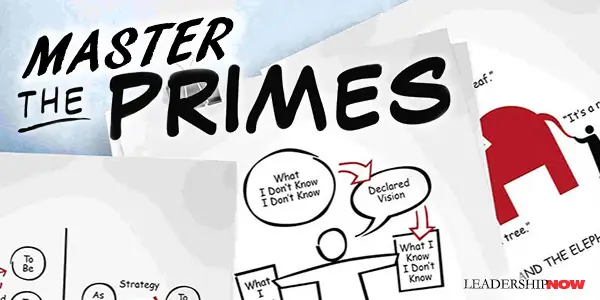
“Master the Primes and you can master leading groups,” says Chris McGoff. The Primes are 46 universal patterns of group behavior that show up every time people join up in groups to solve problems, drive change, and transform systems. Faced with the need for transformative change, a leader’s ability to form and sustain effective groups is critical. The Primes will help you to understand the reasons behind what is blocking the progress of your group. Each of the Primes that McGoff identifies challenges you to take a look at fundamental components of group dynamics by asking key questions. For example, the Change versus Transformation Prime asks, “Are you fixing or creating?” The distinction between fixing or creating is important and requires a different approach. What kind of problem are you trying to solve? Fixing is about making a better, faster, cheaper past. Fixing involves corporate improvement programs like Activity Based Costing, Six Sigma, and others.”These tools are effective when a better past is the desired outcome, but they’re dead weight in the business of transformation.” Creating is about transformation—imagination, declaration, invention, and innovation. The Trust the Universe Prime asks, “Is your vision limited to what you have already seen?” This Prime is a mindset that understands that we don’t know what we don’t know and whatever we need to realize is out there in the future somewhere. But…“Trust in the Universe is a myth. It’s a required myth, an essential myth for any true leader, but a myth just the same. Embracing this Prime is the only real way to create transformative possibilities.” Importantly, McGoff adds, “Leaders understand that although Trust in the Universe promises no guarantees, it gives us the ability to imagine without limit and watch what shows up.”
The Facts, Stories, and Beliefs Prime is the need to distinguish facts from stories from beliefs. There is one of each in the following sentences: “Our revenue was $50 million last year (FACT), and that is simply not enough (STORY). Marketing is inept (BELIEF).” One of the last Primes discussed is an increasingly difficult one: A Clearing. How skilled are you at creating nothing? A clearing in your schedule, your office or meeting place, or your mind: a space where possibilities can exist. The Primes leaves you with plenty to think about. Each concept is illustrated with “back-of-the-napkin” style illustrations and explained with tangible examples. The Primes will show you where you can grow as a leader. 
Posted by Michael McKinney at 11:03 PM
03.12.12

The 11 Essential Elements Needed to Achieve True Collaboration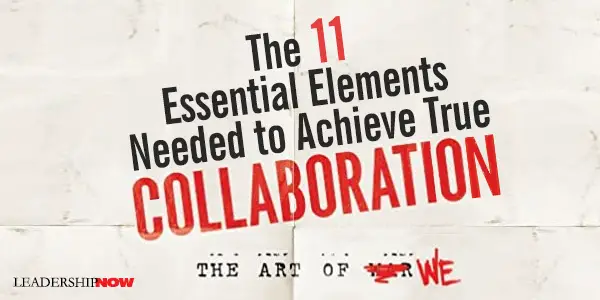
DAN SANKER states that ironically, in order to remain “competitive” companies will have to become more collaborative. Collaborate: The Art of We is a practical guide to going beyond democratic or cooperative work to creating truly collaborative work environments as a growth strategy. Collaboration is not a new concept, but globalization and new technologies have turned it into one of the best methods of competitive advantage available. Rather than engaging in an endless tug-of-war over the dwindling crumbs in a finite market, collaborative companies find ways to make the pie bigger, or create whole new pies, expanding everyone’s market and revenue. “It’s not about how many people you can defeat, but rather about how many people you can help win.” Although networking, coordination, and cooperation may look like collaboration, they are not. True collaboration is the “synergistic relationship formed when two or more entities working together produce something much greater than the sum of their individual abilities and contributions.” It results in something that did not exist before. The focus is on results and not process. Collaboration is distinct from cooperation in that “although both cooperating parties may achieve a common goal, they do not necessarily enhance each other’s capacity. In addition, cooperating parties do not fully share risks, responsibilities, and rewards. In the case of collaboration, all available resources, as well as risks, responsibilities, and rewards, are fully shared.” For a collaboration to be successful, Sanker says that eleven elements must come together: Ongoing Communication. People need to be able to talk to one another freely and regularly. Groups that do not have this kind of interaction are nothing more than loose collections of individuals working on their own tasks, toward their own ends. Willing Participation. Everyone believes that they are working toward the same, mutually beneficial goal and that each one of them will have gained something valuable when that goal has been achieved. Brainstorming. It’s the creative part of the collaboration process, in which members of the group move beyond the “same kind of thinking” to come up with new ideas that bring true value to the collaborative effort. Teamwork. It’s teamwork that keeps people with a diverse set of skills, knowledge, information, and perspectives working together effectively and efficiently to achieve their common goal. A Common Purpose. If the group moves forward too quickly without taking the time to clarify their goal and make sure that everyone is in agreement about what it is, they will undoubtedly run into huge disagreements that are likely to tear the effort apart. Trust. You need to feel confident that other people in the group are putting the group’s shared goal—not their own interests—first, and that they will keep confidential or sensitive information within the group, take you seriously, respect your point of view, and not take credit for your ideas. A Plan for Achieving the Goal. Everyone needs to be working from the same script, clearly understanding roles and responsibilities, and they need to have the same understanding of what success looks like. A Diverse Group. Diversity is the power behind collaboration. Without diversity groupthink sets in. It is diversity that gives a team the unique perspectives needed to create truly innovative solutions. Mutual Respect. For collaboration to be successful, team members must encourage, listen to, and seriously consider all of the ideas suggested by others in the group, no matter how unworkable they might seem. A Written Agreement. A written agreement helps the group avoid misunderstandings and lack of clarity that could derail the process after everyone has invested a great deal of time, effort, and resources. Effective Leadership. Whether one person has been formally designated as the leader of the group is self-led, leadership of some sort is essential to keep the group focused on its destination and facilitating the process of getting there. 
Posted by Michael McKinney at 11:33 PM
11.09.11

Uncertainty Will Freeze You in Place if You Let It
AMBIGUITY is not only certain; it is a necessary state for advancing. Jonathan Fields writes, in Uncertainty: “The more you’re able to tolerate ambiguity and lean into the unknown, the more likely you’ll be to dance with it long enough to come up with better solutions, ideas, and creations.” The problem is that most of us, to one degree or another, react so strongly to ambiguity or uncertainty, that it becomes a limiting factor in our lives and stops us from acting in the face of it. The issue is not so much failure as it is not wanting to “be judged for taking the less-mainstream path and coming up empty.” But taking the risk in the face of uncertainty is “not about tempting fate, it’s about going to that place where magic happens.” Living in the question. So how do we push forward when everything seems to be spinning out of control? Fields suggests we first find our certainty anchors. Certainty anchors are rituals and routines that we build into our lives that help to counter the resistance. On those occasions when you find that it is “Twitter-Time,” rituals and routines will help move the process along. “Ritual helps train you to sit down when you most want to stand when you’re forced to work on the part of the process that leaves you anywhere from bored to riddled with anxiety.” Get feedback along the way. Build a hive of heroes, mentors, and champions. Consider ways to bring into the process the very people you are creating for. Train your brain in the art of focused awareness through meditation, mindfulness, visualization, and exercise to stay focused and grounded. Randy Komisar, author of The Monk and the Riddle, told Fields: It’s a process of stripping myself bare of all the pressures, all of the barnacles that accumulate around you every day as you interact in the world—the pressures, the expectations, the ego, the things that ultimately make your vision unclear. Exercise in the list above wasn’t an afterthought. Most of us feel we don’t have time to work out. But we really can't afford not to. Fields writes: Studies now prove that aerobic exercise both increases the size of the prefrontal cortex and facilitates interaction between it and the amygdala. This is vitally important to creators because the prefrontal cortex, as we discussed earlier, is the part of the brain that helps tamp down the amygdala’s fear and anxiety signals. I emphasize this a lot on the Leading Blog, but I think it’s something we really have to work at. Randy Nelson, Pixar’s former head of education said, “The core skill of innovators is not failure avoidance, it’s error recovery.” Fields adds, “When that’s baked into your creative culture on all levels, people become more empowered to lean into the creative abyss—and magic tends to happen.”

Posted by Michael McKinney at 06:39 PM
09.09.11

Managing the UnmanageableIf we truly want to deal with a difficult or unmanageable person, we have to get at the thinking behind the behavior. Why do they do that? Why are they that way?Instead of going deeper, it’s easier to just label them and avoid the issue. He’s rude. She’s unreliable. He’s an egomaniac. She’s self-absorbed. Anne Loehr and Jezra Kaye, authors of Managing the Unmanageable, say that these “unmanageable” people are costing companies a fortune. Loehr estimates that her clients lose, on average, 30% of their productivity because of issues related to unmanageable employees. The fact is, “there’s a world of difference between someone who’s acting unmanageable, and someone who can’t [won’t] act any other way. There’s a world of difference between someone who’s become unmanageable in response to a particular set of circumstances (that can, at least theoretically, be changed) and someone who’s just like that.” Perceiving the difference is the task of leaders, managers, and coaches. Most of the time we deal with people at the symptom level. Managing the Unmanageable is written to help you do just that. They begin with an appropriate caution: If you find yourself being convinced that someone could never have the slightest redeeming good quality, find a way to deal with your own feelings before you try to manage theirs. Good advice. There are some early warning signs that it is time to look deeper than the behaviors you see: Diminished Motivation: “Frustration with a job can grow out of unmet or unrealistic expectations, company-wide uncertainty or relationship problems on a team or with a manager.” You’ll hear comments like: “I’m just not into it anymore.”Unclear Expectations: Misunderstandings are common. We don’t always communicate as clearly as we think. Too much often goes unsaid. Sadly, too, “managers and executives sometimes purposely lead employees astray, confuse them, or keep them in the dark to avoid unpleasant issues or consolidate power in their own hands.” It sounds like this: “I have no idea what she wants.”Lack of Confidence or Self-Esteem: “It’s natural to wonder if you have what it takes when the stakes go up or your job becomes more complex. But if that lack of self-confidence persists, an employee can become resistant, defensive, and ultimately unmanageable. They will say things such as: “I don’t know why they thought I could do this.”Personal Issues: “When your employee is distracted, self-absorbed, or unable to focus, her problem may stem from conditions outside of work. It might be expressed as: “I haven’t slept through the night in weeks.”“A radical shift in behavior,” say Loehr and Kaye, “may be your first indication that a good employee is morphing into an unmanageable employee.” In short, other people have many of the same problems we have, it’s just that they haven’t learned how to deal with it or are not in a position to do anything about it in the same way that we would as leaders. The book specifically deals with the excuse-maker, the grumbler, the egomaniac, the loose cannon, the joker, the do-gooder, the wallflower, the gossip, the slacker, the rude-nik, and the AWOL. Each “salvage” operation follows the 5-C Model: Commit or Quit, Communicate, Clarify Goals and Roles, Coach, and Create Accountability. The focus of each chapter is to get behind the behavior of each type and understand it. You will find helpful composite cases, practical tips and dialogues for dealing with each type.
Posted by Michael McKinney at 08:41 AM
08.16.11

Hacking the Creative ProcessWhile creativity is associated with artists, creativity is really part of life. It is how we shape our work into something meaningful. Benjamin Franklin put it this way: “To cease to think creatively is but little different from ceasing to live.”You might not think of yourself as being creative, but if you are expected to solve problems, strategize and come up with new ideas, then you are required to be creative. "While a designer will solve a problem visually, a manager may solve it by developing a new process. But they're both using the same creative tools and wrestling with many of the same obstacles." What’s more you are expected to do it consistently and on demand. This isn’t easy. “If you want to deliver the right idea at the right moment, you must begin the process far upstream from when you need that idea,” says Todd Henry, author of The Accidental Creative. Henry believes that you can create faster and more effectively over the long term if you build powerful practices into your life to help you to do so. Ironically, if you are going to thrive in a create-on-demand world, you need structure. “Creativity craves structure. When you establish effective boundaries, you are focusing your creative energy rather than allowing it to run rampant.” Working harder isn’t the answer. An “always on” approach works against you says Henry. “You need to incorporate practices that instill a sense of structure, rhythm, and purpose in your life.” Consistent creativity demands it. In creative work there is the tension between possibilities and pragmatics. Creativity is about exploring, innovation, and the next big breakthrough. But it’s also about budgets and deadlines. It’s easy to get off-track doing creative work. "Because we tend to gravitate toward possibilities, many creative people wrestle with focus." We can become fascinated by the process and never really accomplish anything. Yet we are paid for the value we create. It’s important to be able to articulate exactly what we are trying to accomplish. Henry discusses the assassins of creativity and offer many ways to counter them. One very simple yet profound suggestion is “The Big 3.” The Big 3 is not a to do list, a wish list, or a project list. It is “best described as the three most important ‘open-loops’ in my life and work. They are the three most important items that I’m still looking for critical insight on.” The key thought here is that by identifying them and writing them down, it helps you to filter the stimuli you take in each day through the lens of your most important creative priorities. This technique is a very helpful way of keeping your mind focused and looking for connections to create unexpected insights. Henry also emphasizes the importance of relationships. “We sometimes begin to see the act of maintaining a relationship as an obligation that pulls us away from our important work, rather than as an opportunity to stretch ourselves, explore new possibilities, and take advantage of collaborative opportunities within our team.” You must engage with other people. This is a big point for leaders. When we get busy this always seems like the first thing to go. Big mistake. Relationships give us perspective on our unique strengths, on which of our ideas are most likely to gain traction, and on how we can most benefit the world around us. Our relationships play a vital role in helping us understand how we can get moving on, and devote our best efforts to, the work that really matters.This is an essential read for all knowledge workers. You will find ideas here to help you to reduce non-work, focus on real work, and filter information, to produce better and more consistent results.
Posted by Michael McKinney at 12:35 AM
07.26.11

Have a Nice Conflict!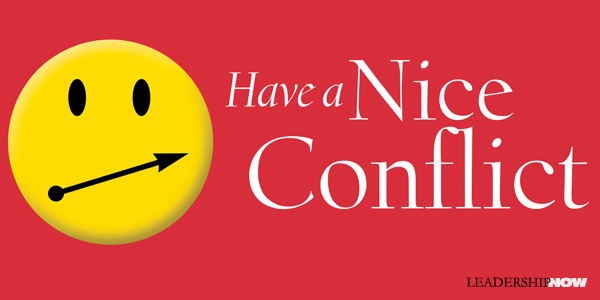
READING Have a Nice Conflict was like listening to my Dad again. He first met “Doc” Porter in the early seventies and they clicked almost immediately. Elias Porter’s Relationship Awareness Theory, on which the book is based, resonated with my Dad. Behaviors are the tools we choose and use to support our self-worth.Have a Nice Conflict is the story of sales manager John Doyle who has been passed over for what he believes is a well-deserved promotion. He has lost some of his top performers because he rubbed them the wrong way. When he turns up at an old friend and client’s office to explain yet another change in sales reps, he puts him on to Dr. Mac to help him improve his people skills at both work and home. Dr. Mac explains to John that there are many ways of interacting with others. We have default ways of behaving and when in conflict we often shift into other behaviors to maintain our self-worth. While we are trying to do the “right thing” to maintain our self-worth, conflict can happen when our “right thing” appears to be the “wrong thing” to another person. Conflict can be prevented by seeing contentious behavior as merely a different style instead of a direct challenge or threat aimed at annoying you or derailing you. He introduces him to the Strengths Deployment Inventory (SDI) which is a tool to help you understand the motivations behind your own behaviors and to better discern the motivations of others. By giving you a framework it helps you to understand what you and others are feeling and then helps you be better able to respond. Having a nice conflict is about taking personal responsibility for the interaction. To create movement toward resolution, we need to show the other person the path back to self-worth—where they feel good about themselves. That path may be different than yours. The concept should be taught in schools, however, the thought process is essential for leaders. The book alone offers valuable insights into the process and methodology, but coupled with the SDI you’ll have greater success. The authors offer a discount on the SDI to readers of the book. 
Posted by Michael McKinney at 05:08 PM
06.03.11

4 Lessons from the Toyota Crisis
“Crisis response must start by building a strong culture long before the crisis hits,” say Jeffrey Liker and Tim Ogden, authors of Toyota Under Fire. Turning crisis into opportunity is all about culture. It’s not about PR strategies, or charismatic leadership, or vision, or any specific action by any individual. It’s not about policies or procedures or risk mitigation processes. It’s about the actions that have been programmed into the individuals and teams that make up a company before the crisis starts. The accident in August 2009 that took the lives of four people in a runaway Lexus brought national attention to Toyota. Fueled by innuendo and speculation by Congress and some media, it escalated into something it was not. Toyota Under Fire deals with not only the massive recall of 2009-2010, but also Toyota’s response to the oil crisis and recession. Toyota’s response has not been typical, but it does follow the Toyota Way. It is a reflection of their culture. That way includes what is probably Toyota’s “greatest contribution to the world as a model of real continuous improvement” at and by all levels in the organization. Liker and Ogden describe the Toyota Way as: Face challenges with a clear head and positive energy. Hold fast to your core values and your vision for the company. Always start with the customer. Understand the problems that you face by analyzing the facts, including your own failings, and understanding the root causes. Thoroughly consider alternative solutions, then pick a path, develop a detailed plan, and execute with discipline and energy. “You do not turn a culture off and on again like a light switch.” Culture—like character—is built over decades of living your values in the real world. And then in a crisis, when you really need it, it is there to carry you through. The authors isolated four lessons for dealing with a crisis: Lesson 1: Your Crisis Response Started Yesterday. What a company does isn’t likely to change much when a crisis strikes or for any length of time. “They are driven by culture, and culture simply can’t be changed quickly, even in a crisis…. Therefore, the chief questions to ask yourself about how your company will respond in a crisis are not contingency plans and policies, but about your culture and your people. Have you created a culture that rewards transparency and accepts responsibility for mistakes? Have you created a culture that encourages people to take on challenges and strive for improvement? Have you created a culture that values people and invests in their capabilities? Have you created a culture that prioritizes the long term?”Lesson 2: A Culture of Responsibility Will Always Beat a Culture of Finger-Pointing. Common sense? Yes, but the question is how far do you go in accepting responsibility? What if the factors were beyond your control? The answer illuminates an important nuance in understanding Toyota’s culture of responsibility and problem-solving. “There is no value to the Five Whys [the belief that you have to ask why at least five times] if you stop when you find a problem that is outside of your control. There will always be factors outside of your control. When you reach a cause that is outside of your control, the next why is to ask why you didn’t take into account forces outside of your control—either by finding an alternative approach or by building in flexibility to adjust to those forces.” Lesson 3: Even the Best Culture Develops Weaknesses. The greatest threat to a culture of continuous improvement is success. “To survive the weaknesses that inevitably develop, a corporate culture has to have clear and objective standards, codified in such a way that self-correction is possible. Having a culture that recognizes a loss of direction is absolutely critical to long-term survival.” Lesson 4: Globalizing Culture Means a Constant Balancing Act. The clarity of Toyota’s culture and values is essential to growing the culture in every employee. And there is a balance to strike—the balance between centralized and decentralized, local and global—that is not easy. “There is an inherent demand here that especially the people who are at the margins, at the periphery of the organization, be deeply steeped in the culture, and that they are to be trusted to make decisions because they are at the gemba.” One of the root causes of the crisis they identified was centralized decision making. They will now pursue a regionalization strategy which will require trusting the leaders they have trained to maintain the culture. Toyota Under Fire is an in-depth look at the value of having a strong culture that can serve you when things go south. The discussions explaining the reasoning behind why Toyota does what it does were very helpful. They demonstrate that the most important decisions are the ones made before the crisis. And then when the crisis hits, return to basics. Go deeper and wider. 
Posted by Michael McKinney at 05:21 PM
12.29.10

Leadership: Artistry Unleashed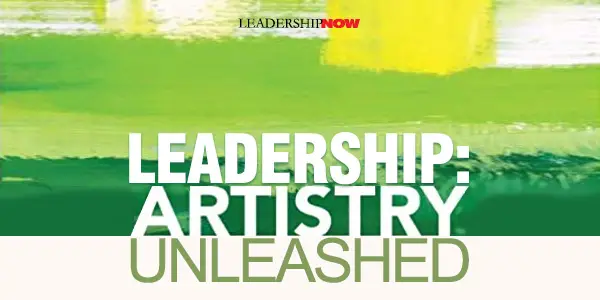
The executive functions … are feeling, judgment, sense, proportion, balance, [and] appropriateness. It is a matter of art rather than science, and is aesthetic rather than logical.Leadership is an art. But what does that really mean? Leadership can be taught in the way that art can be taught. There are techniques and principles that need to be understood. Seeds that can be planted. But ultimately it has to be practiced and experienced. There is the part that really matters, as Georges Braque observed, that can’t be explained. That is the art; the ever-changing context of leadership and the dance between leaders and followers that molds and shapes both the leader and follower. There is an art to bringing leadership teaching into the nuance of life. Leadership practiced, is artistry unleashed. Hilary Austen does a masterful job of explaining, even if indirectly, the art of leadership in Artistry Unleashed. She takes design thinking beyond the surface concerns of practical design and to the processes behind it. These are important issues for leaders as we face what Austen terms enigmatic problems: those that push us to the edge of what we know. “Our best solutions to such problems lie not just in better analytical tools but in a fundamentally different approach to our work—an approach that follows from cultivating qualitative intelligence in our given profession or medium.” Any more quantitative approaches alone won’t work. She explains the difference: “Quantitative thinking allows us to be precise and to share understanding; we use it to define fairness and rationality and effectiveness. It’s this utility that has led so many people to equate quantitative thinking with intelligence.” “A qualitative approach embraces the unexpected, the subtle, the open-ended, the unique, the poetic; it escapes rules, single answers, or single perspectives. These features are by their very nature hard to pin down and can be quite unnerving to people who want precise information and specific answers. The quantitative approach gives us the means to predict and control what we can measure, to record and codify what can be clearly defined, to collect sharable facts, and to identify universal rules and laws. To be sure, Austen is not advocating one or the other. “Each has its own set of purposes, and developing one does not mean abandoning the other. Achieving artistry means being able to use qualities to help you work when that’s what the situation demands; it doesn’t mean rejecting quantitative methods.” We gravitate to quantitative thinking. We like things nailed down. Numbered. Labeled. Defined. It gives us some certainty. It makes us comfortable. We can check it off and move on confident that we’ve done the “right thing.” Unfortunately, life is messier than that. Austen cites Ted Sorenson’s observation from his book Decision-Making in the White House: “White House decision-making is not a science but an art. It requires not calculation but judgment….Every decision a president makes involves uncertainty.” Qualitative thinking is less about imposing an answer and more about shaping an answer from awareness of the present and feedback from the application of knowledge to it, when predetermined steps and measurable goals are absent. The present and the possible are considered at the same time so that ends and means influence each other as they occur. Austen writes, the “interdependent relationship between ends and means is a hallmark of artistic work. As your effort to solve an enigmatic problem proceeds, the ends evolve as means are generated. Likewise, as means unfold, new ends become possible; these may, in turn, demand new means.” It means managing the tension between mastery and originality in search of the possible. “The forces that drive mastery are conservative. Mastery brings predictability and control to action. By contrast, originality is driven by often unpredictable responses to immediate experience. Finding originality means leaving behind some of what you know. Artistry is driven forward by the interplay of these two competing forces.” New York University professor David Ecker’s six phases of qualitative problem solving developed from the work of John Dewey, described in Artistry Unleashed by Austen is helpful: In the first phase, artists engage what Ecker calls the presented or initial relationship between existing qualities….Some of these relationships may be problematic, others intriguing, and so they attract the artist’s attention. Different practitioners may see different qualities and make sense of what they see differently, depending on the ideals, concepts, and sensibilities they bring to bear on the situation.A leader’s function is to create the disequilibrium needed to go from the known to the unknown possibilities. Qualitative thinking is important to the leader because without it we can easily impose answers rather than exploring possibilities. We can too, get in our own way by overvaluing the importance of our own experience and thought and thereby limit possible outcomes. Austen develops a Knowledge System model comprised of the interdependency of Experiential Knowledge, Conceptual Knowledge, and Directional Knowledge, that can be used to help anyone develop and apply qualitative thinking. The cursory view I present here of the connection between business and art, she more fully develops in her book. The examples she gives dramatically demonstrate this important connection and essential understanding needed by leaders of every type. Related Interest:  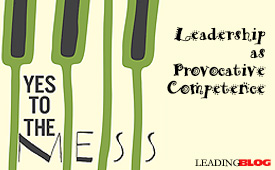 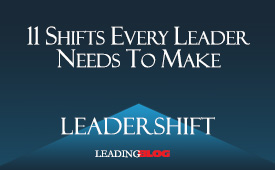
Posted by Michael McKinney at 01:21 AM
07.27.10

7 Signs You Might Be In Denial
Nothing is easier than self-deception. For what each man wishes, that he also believes to be true.BUSINESS historian Richard S. Tedlow, shares in Denial examples of CEOs who have made mistakes that could and should have been avoided and those that did it right and why. The lessons Tedlow uncovers in these examples provide us with insight into our own flirtation with denial and how we might battle it. You might be in denial if you think you have all of the information you need. “Power deranges. Powerful people are routinely surrounded by yes-men, but that is not the real problem because they are relatively easy to spot. The real problem is the courtier who is sufficiently clever not to be detected.” Powerful people, Tedlow continues, “don’t really know as much as they may think about their own organization because people stop telling them the truth.” You might be in denial if you don’t make a point to listen. If people think they won’t be heard they will not speak up. You need to create an open environment where it is safe to say what’s on your mind. Tedlow offers a quick test of your environment: “are the private conversations that follow meetings usually more frank and honest then the public discussions in the meetings themselves?” If so, it’s because everybody is talking about what didn’t (couldn’t) get said. You might be in denial if you think short-term. You are sticking your head in the sand. Trying to put a Band-Aid on a much larger problem only delays your response to the inevitable. Deal with it now and completely. “Denial is all about you—and how you view the world. Your view does not change the world, the realities of which you will inevitably have to face sooner or later.” You might be in denial if you talk trash about competitors and individuals. Anna Freud called it “defense by means of ridicule and scorn.” Tedlow writes, “If you find yourself trash-talking your competition take a moment to think about what you’re doing. What am I using this derision to hide—perhaps from myself?” You might be in denial if you relabel actions rather than changing them. When you don’t like reality, you just change its name. The result as George Orwell said is to “perform the important service of partially concealing your meaning even from yourself.” “Troubled assets aren’t ‘troubled assets.’ They are worthless pieces of junk.” You might be in denial if you don’t tell the truth. “Denial occurs when we push aside hard truths in favor of more palatable or convenient narratives.” This works two ways: the lies we tell and the lies others tell us. Don’t participate in either. You might be in denial if you don’t think denial is a problem you face. That of itself is denial. Tedlow cautions, “It can never be completely defeated because we can’t fully know or face the truth about ourselves. It is impossible to be both subject and object.” You need to develop a self-awareness about it. “Denial-avoidance is a life’s work, not an agenda item….If one could simply resolve to wake up tomorrow and unflinchingly confront reality, denial would hardly be the problem that it is….You can’t avoid blind spots when you drive. However, good drivers know those blind spots exist and take them into account when they get behind the wheel. So it should be with denial.” Some people deny less than others. How can you be one of them? 
Posted by Michael McKinney at 11:16 PM
06.23.10

Developing a Small-Wins Strategy for GrowthWhen moving through difficult times, it is helpful to develop a small-wins strategy. In difficult times, deficit-thinking is so easy to fall into and often becomes the norm. It is hard to defeat but by highlighting small-wins you help to create the kind of abundance-thinking needed for growth and forward momentum. A strategy of small-wins helps to develop the kind of outlook associated with abundance-thinking—self-efficacy, hope, optimism and resilience.A small-wins strategy also helps to eliminate the tendency to be consumed by past disappointments, obstacles and failures. The need to look for “what is working now” is key to moving forward. It opens your thinking to possibilities and paves the way for improving processes. Small-wins focus on the here and now. What can we do now and what can we safely ignore or eliminate. It is an antidote to the fixation error trap. It’s easy to caught up in “everything”—the full impact of what is happening and the habits and perspectives that have become so much of who we are—that we become overwhelmed and unable to act at all. Fixation errors keep us from noticing what is really happening, separating us from reality. Reassess after each win and keep moving to build momentum. Begin by breaking tasks and issues down in to manageable pieces; pieces that you can take responsibility for and act on now. If you are not in a position to implement this strategy on an organizational level, adopt it for your team or even individually. Lead from where you are. It’s contagious. Of Related Interest:
Posted by Michael McKinney at 11:35 AM
06.09.10

Why Design Thinking Is the Next Competitive Advantage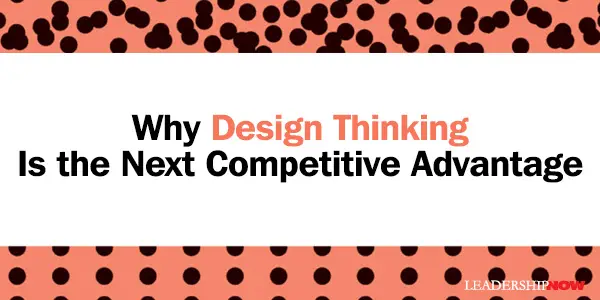
WE live in a reliability-oriented world. And understandably so. We want predictable outcomes. We want things to keep working as they have always been—perfectly. Success. Repeat. Success. Repeat. But that thinking ultimately limits our growth and quite possibly harbors the seeds of our own destruction. It can be (very) valuable to a point, but it isn’t adaptable because by its very nature it has to leave something out of the equation. While reliable outcomes “reduce the risk of small variations in your business, they increase the risk of cataclysmic events that occur when the future no longer resembles the past” and the reliable is no longer relevant or useful. To remain relevant—to foster innovation—you need to incorporate into your thinking outcomes that are valid. That is outcomes that produce a desired result even if the solution employed can’t produce a consistent, predictable outcome. A perfectly valid solution is one that produces a result that is shown, through the passage of time, to have been correct. It is best to have a system that incorporates both—validity and reliability—into their approach. Balancing and managing the two approaches—analytical and intuitive—is what design thinking is all about. In The Design of Business, Roger Martin presents the knowledge funnel to show how knowledge moves. Each stage represents a simplification and ordering of knowledge. At the beginning is a mystery; a question. It is the observation of phenomena. Things we see but don’t yet understand.
The next stage is a heuristic, “a rule of thumb that helps to narrow the field of inquiry and work the mystery down to a manageable size.” Heuristics don’t guarantee success but do increase the probability of success. The last stage is the development of an algorithm. “An algorithm is an explicit, step-by-step procedure for solving a problem. Algorithms take the loose, unregimented heuristics—which take considerable thought and nuance to employ—and simplify, structuralize, and codify them to the degree that anyone with access to the algorithm can deploy it with more or less equal efficiency.” Martin uses the example of the development of McDonalds to illustrate how they proceeded down the knowledge funnel. In 1940 the McDonald brothers opened their first drive-in restaurant in San Bernardino, California. It did well, but by 1950 they began to lose business. Food was getting cold before it was delivered and families were put off by the hoards of teenagers they attracted. They had to develop a winning heuristic. They reduced and standardized the menu, and implemented their Speedee Service System. Ray Kroc saw an opportunity in it and bought them out. While the Speedee Service System was good, Kroc thought it left too much to chance. So he refined it and simplified it down to an exact science. The new system left nothing to chance and it was repeatable. “Kroc relentlessly stripped away uncertainty, ambiguity, and judgment from the processes that emerged from the McDonald brothers’ original insight. And by fine-tuning the formula, he powered McDonald’s from a modestly prosperous chain of burger restaurants to a scale previously undreamed-of.” The problem is getting stuck in any one stage. We tend to operate within a knowledge stage as opposed to moving across the knowledge stages. We need to explore and question, we need to exploit our solutions, even reducing them to a repeatable, efficient, formula where possible, but we need to be doing these things simultaneously. The vast majority of businesses follow a common path. The company is birthed through a creative act that converts a mystery to a heuristic through intuitive thinking. It then hones and refines that heuristic through increasingly pervasive analytical thinking and enters a long phase in which the administration of business dominates. And in due course, a competitor stares at the mystery that provided the spark for this company, comes up with a more powerful heuristic, and supplants the original business. McDonalds did well for decades, but eventually the heuristic (Americans want a quick, convenient, tasty meal) changed (Americans want a healthier menu). The solution for McDonalds is to go back and rethink the mystery and develop new rules of thumb to guide them. A trip back through the knowledge funnel. Avoiding this cycle is the job of the leader—a leader at any level. Martin writes, “CEOs must learn to think of themselves as the organization’s balancing force—the promoter of both exploitation and exploration; of both administration and invention.” This is design thinking. We need to develop our design thinking skills, analyze what’s working and why, and at the same time revisit the original mystery while considering entirely new mysteries. “The design thinker develops the capacity for observation, for seeing features that others may miss. The design thinker, in the words of novelist Saul Bellow, is ‘a first-class noticer.’” Always cycling through the knowledge funnel.
Posted by Michael McKinney at 12:28 PM
02.18.10

How Fascinating is Your Message?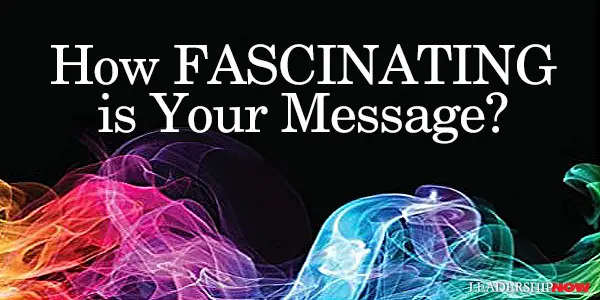
ROBERT LOUIS STEVENSON said, “Everyone lives by selling something.” Leaders are always selling something—an idea, change, themselves or even their example. It’s influence. While we know a clear consistent message is necessary it is often hampered or even marginalized by competing messages and issues. Sally Hogshead is an expert at delivering messages and changing people’s minds. In her book Fascinate: Your 7 Triggers to Persuasion and Captivation, she writes, “A competitive environment demands a more captivating message.” A more captivating message is a more fascinating one. Fascination is the connection we make with others that causes them to change their mind and behave differently. “People won’t change a preference, start a thought process, form a bond, or make a behavioral shift unless they’re provoked to change their opinions or actions.” Fascination provides the provocation. A fascinating message steps outside the norms in one or more of the following ways: provokes strong and immediate emotional reactions (love it or hate it), creates advocates, becomes “cultural shorthand” for a specific set of actions or values (people identify with it), incites conversation, forces competitors to realign around it, and/or triggers social revolutions (forces us to think differently). The key to mastering fascination is learning to effectively activate the seven triggers:
The point of all this is that you can make your message (or yourself for that matter) more fascinating. “All seven triggers affect decision making whether or not we intend them to.” She offers tools for evaluating your message, developing the appropriate triggers and then executing those triggers. She says there’s no “right” way to fascinate and that’s a good thing because we all operate a bit differently and tend to utilize different combinations of the fascination triggers. On her web site you can find out your fascination score (F Score) by taking a short test. In an interesting example concerning teenage drinking and driving she notes that a graphic photo of a car wreck doesn’t seem to effectively dissuade teenage drivers. For teens, fear isn’t necessarily a reason to avoid something. How do you provide a fascinating message for this group? Luke Sullivan, a legendary advertising writer, solved the problem. Luke knew that teems don’t fear death in the same way as adults. He also figured out what does create alarm among these drivers: Losing their license. Armed with that fact, he threatened teens with the ultimate dire consequence. How could you change your message to make it more fascinating and thus more effective for your audience? Throughout the book she blends art and science to demonstrate what fascinates people and why. You might be surprised to find out which fascinations are driving your own behavior. Her writing style and examples are very entertaining. “Whether we realize it or not—whether you intend to or not—you’re already using the seven triggers,” she writes. “The question is, are you using the right triggers, in the right way, to get your desired result? By mastering the triggers, your ideas become more memorable, your conversations more persuasive, and your relationships more lasting.” How do you try to change people’s minds? Could you make your message more fascinating? 
Posted by Michael McKinney at 05:47 PM
02.03.10

The Right Fight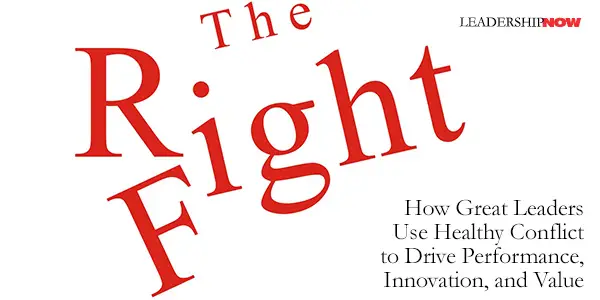
IF YOU believe that the single most important thing leaders have to get right is alignment, if you think that the leader’s time is best spent promoting teamwork and making sure everyone is on the same page and playing nice, then you might want to take a look at Saj-Nicole Joni and Damon Beyer’s book, The Right Fight. The book is based on a counterintuitive premise: In an environment where alignment is the only goal, alignment robs us of necessary dissent, of the checks and balances that mitigate risk, and of the tensions that create innovation and sustainable value. In short, you need to systematically orchestrate the right fights but … you need to fight them right. The Right Fight principle is based on the idea that you learn and grow by the right amount of friction and stress. “A certain amount of healthy struggle is good for organizations and for individuals. Indeed, people and organizations perform optimally when they are under the right kinds and amounts of stress.” They add, “With alignment and properly managed tension, organizations hit a sweet spot and start realizing their potential.” Citing a study by Theresa Wellbourne of eePulse, the single greatest predictor of poor performance is when employees are happy or complacent and thus unmotivated to change. The second greatest predictor is when employees are overwhelmed. Both groups exhibit a low level of energy. They conclude that “Tension in the right measure creates the emotional energy people need to change.” The trick for leaders is to avoid these extremes. “Knowing where and when to use tension is critical. Knowing how to work through the tension is equally important.” They lay out three principles that identify right fights and three more principles that clarify the rules of engagement. The first three Right Fight Principles will help you in identifying and eliminating destructive tensions: Right Fight Principle #1: Make it Worth Fighting About. Make it Material. “A right fight has to create significant value, require integration of multiple perspectives, and change the way work gets done in an organization. In short, a material fight is worth the trouble.” Right Fight Principle #2: Focus in the Future, Not the Past. “Obsession with past performance, or intense interest in decisions made months or even years before, is a dead giveaway that your organization is stuck in a wrong fight.” Right Fight Principle #3: Pursue a Noble Purpose. “Right fights connect people with a sense of purpose that goes beyond their own self-interest, unleashing profound collective abilities to create in ways they didn’t think possible.” The final Right Fight Principles guide you in fighting right fights right: Right Fight Principle #4: Make it Sport, Not War. “Right fights, like sports, have to have rules. One of the key tasks for leadership in a right fight is to define the parameters so everyone involved understands how to participate and what it takes to win.” Right Fight Principle #5: Structure Formally but Work Informally. “You need to structure right fights through the ‘formal organization,’ but work out the tensions created by those fights through the ‘informal organization.’” Right Fight Principle #6: Turn Pain into Gain. “There is a fine line between productive tension and destructive distress, and no two people draw that line in exactly the same place. For right fights to be fought right, leaders need to make sure no one is put under unbearable pressure. Turning pain into gain requires leaders to relate to their team members as individuals and to figure out what creates synergy, stretches skills, and honors outcomes for each of them.” There are case studies to illustrate each of these principles in action. It’s easy to see the negative side of tension: focusing on the past, stigmatizing the losers, fighting over turf. “But without tension, nothing moves.” Tension creates an opportunity for leaders to help their organizations fight the right fight. 
Posted by Michael McKinney at 08:57 AM
12.23.09

The Nature of Small Wins
IN the face of overwhelming problems, we can feel helpless to do anything. Organizational theorist Karl Weick argues that calling a situation a serious problem requiring a sweeping change may be when the real problem starts. (e.g., "I can't solve that problem, so I'll just focus on something else.") And so nothing gets done. In the article Small Wins: Redefining the Scale of Social Problems, Weick explains that small wins help to create an environment where change is not overwhelming and therefore more likely to happen. He writes, "The massive scale on which social problems are conceived often precludes innovative action because the limits of bounded rationality are exceeded...People often define social problems in ways that overwhelm their ability to do anything about them." In order to solve social problems, he suggests that we define them as a series of smaller problems that can then be affected by small wins. He defines small wins as a "series of concrete, complete outcomes of moderate importance [that] build a pattern that attracts allies and deters opponents." This strategy of focusing on “a series of controllable opportunities of modest size that produce visible results”, works directly on the construction of a problem and indirectly on its resolution. A small win is a concrete, complete, implemented outcome of moderate importance. By itself, one small win may seem unimportant. A series of wins at small but significant tasks, however, reveals a pattern that may attract allies, deter opponents, and lower resistance to subsequent proposals. While small wins provide less effort to produce and provide stable building blocks to build on, they are not orderly because each small win changes the context for the next small win. Weick explains: “Small wins have a fragmentary character driven by opportunism and dynamically changing situations. Small wins stir up settings, which means that each subsequent attempt at another win occurs in a different context. Careful plotting of a series of wins to achieve a major change is impossible because conditions do not remain constant. Much of the artfulness in working with small wins lies in identifying, gathering, and labeling several small changes that are present but unnoticed, changes that in actuality, could be gathered under a variety of labels.
Posted by Michael McKinney at 07:57 AM
12.16.09

What Prevents Me from Learning Here and Now?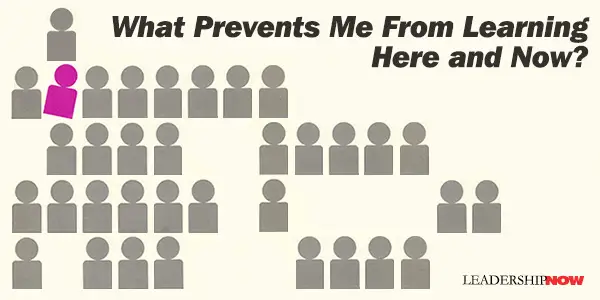
COULD WE be looking at success and failure in the wrong way? Fritz Roethlisberger, former professor at Harvard Business School and author of Man-In-Organization (1968), found that students that were preoccupied with success or failure couldn’t concentrate on their studies. The common thread he found in the cases is that they all viewed success and failure as an either-or proposition; either their project was a success, or it was a failure. Roethlisberger called it a false dichotomy.  A preoccupation with success in the future, says Roethlisberger, makes it difficult to relate to the present. You end up asking the wrong question: “What is the secret of success?” Instead, they should be asking, “what prevents me from learning here and now?” When we are overly preoccupied with the future, we miss the present, where learning and growth take place. We need to stop viewing the present as the means and the future as the end. The future is really just another present when it comes and a new opportunity to learn. If we treat the present as nothing until we achieve success, we miss the significance of the present. To ask “am I a success or a failure” is a silly question, argues Roethlisberger. We are all both a success and a failure. The question is, “What are we learning in our present situation?” 
Posted by Michael McKinney at 11:52 AM
08.07.09

Learning to Apply Right View and Right Conduct to Your Decision Making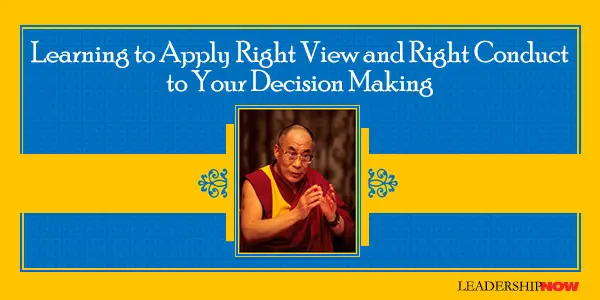
THE Dalai Lama and consultant Laurens Van Den Muyzenberg have collaborated in The Leader’s Way to fuse Buddhist and Western philosophies to address responsible leadership. In order for a leader—“one who makes the right decisions”—to make the kinds of decisions that “generate a better quality of life for themselves, their organizations, and everyone else affected by those decisions,” they must learn to “understand more clearly what happens in their minds and the minds of others.” This involves two concepts they introduce as Right View and Right Conduct. The Right View has to do with action based on the right intention and the right motivation. It means taking into account that nothing that exists is permanent, nothing exists without a cause, and every cause has many effects. The Right Conduct is the endgame; to take action that serves the needs of individuals and organizations. The right conduct should always align with your stated values and principles. When the mind is disturbed by anger, jealousy, hate, impatience, fear, lack of self-confidence, or negative emotions about things that happened in the past, it is wasting valuable time that instead should be used for constructive thinking. The purpose of training the mind is to maximize its power by focusing it on the decisions that matter. Meditation or reflective thinking plays a big part in training the mind. A Harvard study cited in the book compared brain scans of meditating and nonmeditating people and found that meditation had seemingly enlarged the part of the brain that regulates emotion, attention, and working memory. They discuss ways of developing your thinking to improve your performance, the performance of your organization, and for acting responsibly in our interdependent world. One important pattern emerged: “one should celebrate joyful events while not becoming too attached to their meaning, either in the present or as a predictor of the future.” The danger is in seeing success as permanent. Right View and Right Conduct is a process that always needs to be renewed.

Posted by Michael McKinney at 12:54 AM
08.03.09

Rules for Conquering RiskIn How the Wise Decide, authors Bryn Zeckhauser and Aaron Sandoski cite a study by Princeton psychologist Daniel Kahneman. The study finds that “our brains are programmed to worry substantially about the possibility of loss, and not enough about the size of the loss relative to the gain. We don’t like to lose period.” It’s called risk aversion. It means that we put a far greater weight on losing than on winning.The authors say the problem arises when our penchant for risk aversion begins to cloud our thinking. They write that we “can get so caught up in the possibility of losing that we ignore the realities of the situation.” We “wind up shying away from taking a risk even when the probability of winning big is high.” They ask, “What if you could routinely overcome loss aversion? Think of the possibilities if your competitors, shrinking before the prospect of possible loss, shun a move that you know has a very good possibility of succeeding. What a competitive advantage! Wise leaders are constantly searching for ways to use that advantage.” Rather than fight over the same fabric as everyone else – low risk/high reward – it’s better to investigate those situations that appear to be high risk/high reward. They give five rules for dealing with or fear of risk: Identify What Really Drives the Risk. Conventional wisdom can keep us from seeing reality. Ask what drives the risk and what information do I need to evaluate that risk. Reward People for Taking Smart Risks. Reward your team for “simply making the smart decision, not the outcome of their decisions….You have to engineer the risk-taking environment that best suits your own situation.” Test the Waters Before Taking a Plunge. “Sometimes it pays to let a concept simmer for a while, experimenting with an idea before fully committing to it. Experiments limit your downside risk, but not your upside reward.” Create a Risk-Tolerant Environment. Dean Kamen of DEKA Research & Development says that he wants “outrageous new ideas about the project that go well beyond the normal constraints of time and budget. The trouble is, if you carry the basic human aversion to risk and the need to be predictable and meet schedules into the world of R&D, you’re snuffing out the future.” Ask “What Would It Take?” The question helps you make the right decision, not the safe one. Conquering the fear of risk is just one of the six core decision-making principles presented in the book. The other five are go to the source, fill a room with barbarians, make vision your daily guide, listen with purpose, and be transparent. All are worth examining for finding application in your particular situation.
Posted by Michael McKinney at 09:38 PM
06.17.09

Iconoclast: Learning to Think DifferentlyCREATIVITY and imagination is in the space between revolutions and everyday life. They fuel change and, most of the time, progress. Bringing new thinking to old patterns is the job of the leader. In a sense, leaders are to varying degrees, called to be iconoclasts. Neuroscientist Gregory Berns says that not only is an iconoclast a person who does something that others say can’t be done but their mind functions differently than the average mind. Those functions are perception, fear response and social intelligence. Because the mind is designed to function as efficiently as possible, it serves as its own barrier to being an iconoclast. (The brain runs on about 40 watts of power. There is partial truth to the myth that you only use 10-15% of your brain. We use all of our brain, but only a fraction of the brain is active at any given time to conserve energy.) In Iconoclast, Berns explains that “when confronted with information streaming from the eyes, the brain will interpret this information in the quickest and most efficient way possible.” This “efficiency trap” blocks us from seeing alternatives to what we perceive as real; it imposes limitations to what we believe is the only way of seeing something. Iconoclasts don’t allow themselves to fall into the efficiency trap as often as the average person does. “Automatic thinking destroys the creative process.” Berns adds—and the implication is very important—“iconoclasts, either because they were born that way or because they learned how to do it, have found ways to work around the perceptual shortcuts that plague most people.” Thus, we can learn to do this too. Fundamentally, we need to create novel experiences. Iconoclasm begins with perception….Sometimes a simple change of environment is enough to jog the perceptual system out of familiar categories….Unfamiliarity forces the brain to discard its usual categories of perception and create new ones….When confronted with places never seen before, the brain must create new categories. It is in this process that the brain jumbles around old ideas with new images to create new syntheses. The iconoclast’s fear response—specifically the fear of uncertainty and the fear of public ridicule—are different than that of the average person. Fear is damaging to creativity in the workplace. “In many people, the brain would rather avoid activating the fear system and just change perception to conform with the social norm.” You can not eradicate the fear response but you can learn to tame it. “Neuroscience is showing how the rational part of the brain can regain control over such toxic emotions like fear.” The individual who feels overwhelmed by uncertainty or social stresses in the workplace may benefit from taking on projects that have defined endings. Although these may increase in the short term, their completion may actually decrease overall stress. All of this is well and good, but to be a successful iconoclast, you must be able to sell your ideas to other people. That boils down to social intelligence. “As well-respected, upstanding citizens, connectors form the glue of local society. Iconoclasts, by their very nature, upset this delicate web of connectedness. But iconoclasts need connectors. Without them, the iconoclast stands no chance of achieving success. Sometimes iconoclasts have to create the connectors themselves.” Additionally, it is a challenge to leaders to be able to find ways to connect iconoclasts to others so that their talents and insights can be capitalized on organizationally. It is extremely rare for one person to have all three qualities of a successful iconoclast. But you can compensate by building a team around you in areas where you aren’t strong. Iconoclast: A Neuroscientist Reveals How to Think Differently is supported by research and persuasive stories. The immediacy of the topic will be helpful not only to individual development but to organizations seeking to bring new thinking to old patterns of thought. 
Posted by Michael McKinney at 12:42 PM
06.12.09

Think Again: Why Good Leaders Make Bad Decisions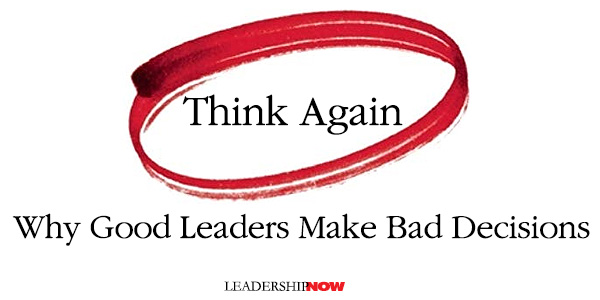
WHY DO GOOD LEADERS make bad decisions? This question is at the heart of Sydney Finkelstein, Jo Whitehead and Andrew Campbell’s book, Think Again. The authors begin their analysis with the notorious 2005 hurricane Katrina disaster. As the retelling of the events are explained, you might even find yourself compelled to stop waving your placard, change your t-shirt, pull up a chair and listen for understanding. A series of understandable mistakes—errors of judgment—were made by very competent people. The same kinds of errors of judgment that we all make. A bad decision starts with at least one influential person making an error of judgment. But normally, the decision process will save the day: facts will be brought to the table that challenge the flawed thinking, or other people with different views will influence the outcome. So the second factor that contributes to a bad decision is the way the decision is managed: for whatever reason, as the decision is being discussed, the erroneous views are not exposed and corrected.Drawing on the findings of brain research, they conclude that “our brains use two processes that enable us to cope with the complexities we face: pattern recognition and emotional tagging.” Neither of these is inherently bad, in fact, they are quite helpful and necessary much of the time. The problem is when we are faced with new types of input that do not match up with our previous experiences. This most often leads to flawed thinking. They describe four conditions under which flawed thinking is most likely to happen. The first two are pattern recognition problems and the latter are emotional tagging issues.
  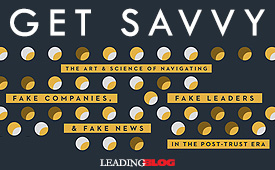
Posted by Michael McKinney at 09:34 AM
04.03.09

Newswire: What the French Revolution Can Teach America
Posted by Michael McKinney at 11:29 AM
04.02.09

10 Survival Tips from Donald Trump
WHAT'S happened to the economy has been likened to a tsunami as well as an implosion. When the undersea earthquake and subsequent tsunami hit in Indonesia in 2004, the world was stunned by the devastation that took place. It triggered earthquakes around the globe, as far away as Alaska. It happened in a very short amount of time. This kind of event takes shape over a period of time and then erupts with incredible force. What happened this past year is similar in that respect—it'd been brewing for some time. When it hit, it was like a tsunami which caused other economies to start crumbling as well. We are all familiar with that scenario. What we need to do now is deal with it. The aftermath of a tsunami requires surveying the damage, picking up the pieces, and moving on. Some people have bigger losses than others, but everyone has to keep going. When it comes to implosion, it's more of a cave-in than a wipe-out, but equally potent. We saw the effects of an implosion watching the towers fall on 9/11. It's a domino effect. We won't sink because we can swim, but let's not go the way of dominos. Let's be smart and learn to think for ourselves in positioning ourselves for what comes next. Here are a few survival tips:
Posted by Michael McKinney at 01:12 AM
03.17.09

What To Do When Growth Stalls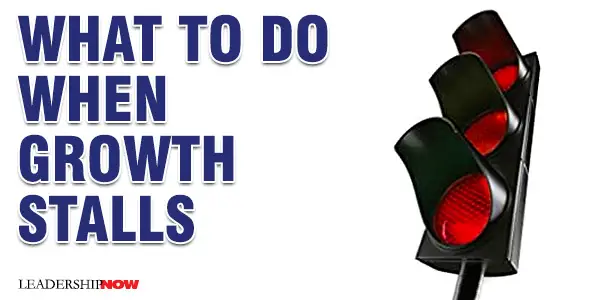
Steve McKee has written an insightful analysis of the problem. When Growth Stalls “is about generating growth for your company at a time when growth may be nothing but a glimmer of hope in your mind.” There are external forces that we all fall victim to: economic upheavals, aggressive competition, and changing industry dynamics. But McKee’s research has identified four internal factors that work against recovery and often paralyze you: Lack of Consensus. Consensus doesn’t mean management by committee. It means “agreement among an organization’s senior leadership about the nature and purpose of the company and where it’s intended to go.” McKee writes, “Consensus issues are hard to identify and unpleasant to face. But if you have a consensus problem, things can’t get better until you recognize it.” Only then can you work together to uncover the genuine issues you are facing. Everyone needs to be on the same page working from the same playbook. Loss of Focus. “No matter how big the company, its management team has only a finite amount of resources—money, time, talent, energy—at its disposal. The less focused those resources become, the less muscle management can muster to move the company forward or, if necessary, pull it out of a ditch.” Loss of Nerve. Probably the most insidious factor. When growth stalls, as McKee points out, it’s confusing. “Great leaders are supposed to be firm, decisive, and sure-footed. When things go wrong, you just fix them. That is until the problems spin beyond your control.” It’s discouraging. “When the road drops out from under the company, the CEO’s own discouragement can be difficult to hide.” It’s contagious. “It’s one thing to struggle privately…it’s quite another when the discouragement and disillusionment hit you so hard you can’t hide them. When the CEO is worried, everybody’s worried.” It's paralyzing. “You don’t have the luxury to think strategically when things are so desperate.” It’s wearying. As one CEO told him, “I wasn’t so much scared as ticked off and drained. I was tired of pushing the rock up the mountain like Sisyphus.”
Marketing Inconsistency. “The companies with the strongest track records do everything they can to maintain a consistent identity in the marketplace, even as the economy moves up and down, competitors come and go, and consumer tastes shift.” These four factors can create a vicious cycle that can be crippling. The first step is to step back and understand that while it is common as a leader to feel guilt, “that attitude is not only unhealthy and unproductive, in most cases, it’s just plain incorrect….As long as denial, doubt, and fear—and in some cases, sniping, finger-pointing, and other destructive behaviors—are wreaking havoc with your internal dynamics, you’ll remain stuck in the vicious cycle.” McKee shows you how to identify and deal productively with these factors. Writing from personal experience, he uses good examples and appropriate metaphors to explain what is happening when growth stalls. This adds to the book’s credibility and the friendly, thoughtful tone of his writing. If your growth has stalled, you need this book to help you get your company back on track. 
Posted by Michael McKinney at 12:00 AM
03.11.09

Six Ways Companies Mismanage Risk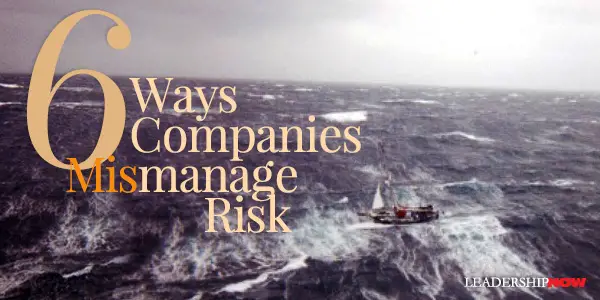
OHIO STATE University professor René Stulz writes in the Harvard Business Review, “Of course, financial institutions can suffer spectacular losses even when their risk management is first-rate. They are, after all, in the business of taking risks. When risk management does fail, however, it is in one of six basic ways, nearly all of them exemplified in the current crisis. Sometimes the problem lies with the data or measures that risk managers rely on. Sometimes it relates to how they identify and communicate the risks a company is exposed to. Financial risk management is hard to get right in the best of times.” Obviously, risk assessment needs to be tempered with time-tested experience and calculated risks need to cast a wider net when calculated. In summary, here are his six paths to failure:
Posted by Michael McKinney at 12:07 AM
03.06.09

7 Vital Behaviors of Effective Problem-Finders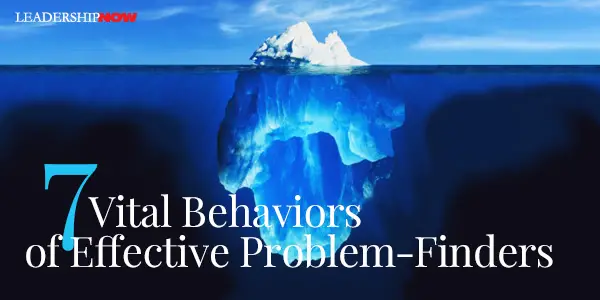
IN Know What You Don’t Know, Michael Roberto has identified the key skills and capabilities required to ensure that problems do not remain hidden in your organization. Keep in mind that problem-finding does not precede the processes of continuous improvement. Learning does not follow a linear path. Take the athlete who practices her sport on a regular basis. She does not always discover a problem first and then practice a new technique for overcoming that flaw. Sometimes, an athlete sets out on a normal practice routine, and through that process, she discovers problems that diminish her effectiveness. In sum, the processes of problem-finding and continuous improvement are inextricably linked. A person should not focus on one at the expense of the other, nor should he expect to proceed in a linear fashion from problem discovery to performance improvement. We often will discover new problems while working to solve old ones.
Adapted from Know What You Don't Know: How Great Leaders Prevent Problems Before They Happen by Michael A. Roberto 
Posted by Michael McKinney at 03:25 PM
02.27.09

How To Know What You Don’t Know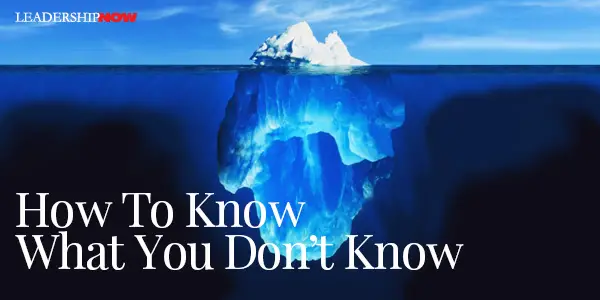
HAVING studied some of the biggest decisions of our time, Michael Roberto is an expert on decision making. But his new book is not about decision-making. Not exactly anyway. Something Robert McNamara said to him made him take a step back. McNamara said that while business schools dutifully teach decision making, in the real world, identifying the true problem often proves to be the bigger issue. Have you ever found that you were working on a solution to the wrong problem? Of course, knowing that a problem exists at all is first the critical step. Too frequently, we uncover the problem too late and the small issue has become a major problem. By now, we are all well acquainted with this scenario. Roberto writes, “Small problems often precede catastrophes. In fact, most large-scale failures result from a series of small errors and failures, rather than a single root cause.”Peggy Noonan recently wrote in her weekend column, “Every new president starts out fresh, in part because he doesn’t know what he doesn’t know. Ignorance keeps you perky.” It also makes you vulnerable. So a leader must become a good problem-finder. We need to get good at knowing what we don’t know. The purpose of Michael Roberto’s book, Know What You Don’t Know, is to help us do just that – become an expert at finding problems. It’s an important book on a timely – if not ever-present – issue. Problem-finding is an ongoing process and a bit of a trick. Simply asking won’t give you the answer. People are prone to tell you what you want to hear. People tend to do – and think nothing of – what makes sense to them, but it might not make sense in the context of what you are trying to accomplish. So you have to learn to read between the lines and connect the dots. It requires intuition. Improving that capability is essential to your success so that when you do put two and two together, you get four and not something else. You have to create a learning environment where people are allowed to make mistakes and learn from them. And they need to be trained how to communicate their thoughts and allow others to communicate theirs without shutting them down. Through numerous examples he shows how people have improved their problem-finding skills. Many of these examples can be applied in a wide variety of contexts. A successful leader must develop the mindset of a problem-finder. This, Roberto says, is not just another set of behaviors and competencies. It begins with “a certain level of intellectual curiosity. You must be willing to ask questions, seeking always to learn more about both the familiar and the unfamiliar…. Perhaps most importantly, you must be willing to question your own prior judgments and conclusions.” (And have enough humility to even think that that is necessary.) You also must “embrace systemic thinking.” A good problem-finder recognizes “that small problems often do not occur due to the negligence or misconduct of an individual. Instead, small errors frequently serve as indicators of broader systemic issues in the organization.” It might be prudent, in the aftermath of a major problem, to use it as an opportunity to look at the “whole” organization for contributing factors. Finally, Roberto says you need to have a healthy paranoia. “Effective problem-finders acknowledge that every organization, no matter how successful, has plenty of problems.” And that’s OK. “Effective problem-finders acknowledge their personal fallibility, rather than cultivating an aura of invincibility.” Roberto concludes, “Successful leaders do not see problems as threats. They see every problem as an opportunity to learn and improve.” Leave no stone unturned. 
Posted by Michael McKinney at 12:11 AM
02.26.09

Why Problems Hide
Problems remain hidden in organizations for a number of reasons. First, people fear being marginalized or punished for speaking up in many firms, particularly for admitting that they might have made a mistake or contributed to a failure. Second, structural complexity in organizations may serve like dense "tree cover" in a forest, which makes it difficult for sunlight to reach the ground. Multiple layers, confusing reporting relationships, convoluted matrix structures, and the like all make it hard for messages to make their way to key leaders. Even if the messages do make their way through the dense forest, they may become watered down, misinterpreted, or mutated along the way. Third, the existence and power of key gatekeepers may insulate leaders from hearing bad news, even if the filtering of information takes place with the best of intentions. Fourth, an overemphasis on formal analysis and an underappreciation of intuitive reasoning may cause problems to remain hidden for far too long. Finally, many organizations do not train employees in how to spot problems. Issues surface more quickly if people have been taught how to hunt for potential problems, what cues they should attend to as they do their jobs, and how to communicate their concerns to others. Adapted from Know What You Don't Know: How Great Leaders Prevent Problems Before They Happen by Michael A. Roberto
Posted by Michael McKinney at 12:51 AM
01.19.09

Hitting Your Goals by Knowing What Matters“The trouble with an overload of information isn’t just that it’s confusing. It’s that the data have conflicting implications,” writes David Apgar in Relevance: Hitting Your Goals By Knowing What Matters. Today, data is cheap so we make more of it. But in generating more of it, we unwittingly complicate our decisions. The problem is in determining what is relevant.Two tests help to determine the usefulness of any piece of information. First, is its specificity “because you can draw more conclusions from precise outcomes rather than vague ones.” And secondly is its relevance. “Relevance has to do with how well a piece of information tests your expectations.” Apgar suggests that while we have become used to less relevant data we have developed two bad habits. “Instead of devising a specific strategy to meet a financial goal like a sales or profit target, we’re increasingly tempted to enumerate requirements for meeting the goal…. Requirements are not strategies. An unlike strategies, there’s little to learn when they fail to work.” And then there’s our growing reliance on red herrings. “Red herrings are results that appear to confirm your plans but in reality are merely consistent with them.” We end up chasing after the wrong thing. It leads to an unintended use of the balanced scorecard. “It’s too easy for organizations to fill out balanced scorecards with lists of obvious requirements for success that resemble ingredients in a cookbook. The trouble isn’t that the ingredients may be wrong; it’s that they run so little risk of being wrong. As a result, they end up saying very little.” The strategy should look more like a recipe than a list of ingredients. There is little chance of the ingredients being wrong. You can execute the ingredients, but the recipe is what needs to be tested. Apgar offers a quick and efficient way to get the indicators that test strategic assumptions and devising better performance strategies. He writes, “A leader must both promulgate polices clear enough to test and be ready to change them. Clarity and a critical attitude are great virtues when combined. Instead of avoiding leaders with simplistic or nuanced approached to the world, organizations and countries alike need leaders who alternate between them.”
Posted by Michael McKinney at 09:21 AM
10.13.08

Thinking Gray and Free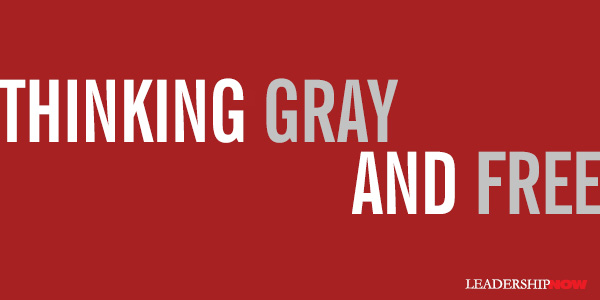
IN The Contrarian's Guide to Leadership, author Steven Sample, shares the idea that leaders think differently. “Leaders are able to maintain their intellectual independence by thinking gray and enhance their intellectual creativity by thinking free.” Leaders have to deal with ambiguities and unknowns. The idea is to learn to think gray while holding firmly to your core ideals. It’s not being binary and instant in your judgments and seeing the nuances to be found in many situations. Free thinking is more than just brainstorming. It’s brainstorming beyond your current reality. What would we do if we had no budgetary constraints, no time restrictions, no personnel problems, no legal restrictions, and no fear of failure? It’s to “contemplate absolutely outrageous and impossible” ideas and solutions. The leader whose thinking is constrained within well-worn ruts, who is completely governed by his established passions and prejudices, who is incapable of thinking either gray or free, and who can’t even appropriate the creative imagination and fresh ideas of those around him, is as anachronistic and ineffective as the dinosaur. He may, by dint of circumstances, remain in power, but his followers would almost certainly be better off without him. 
Posted by Michael McKinney at 08:04 AM
09.22.08

Why Do Seemingly Smart People and Companies Make Such Blunders?In business, don’t we have structures in place that are designed to bring in a variety of expertise when making major decisions and ensure that no one person can send the business in the wrong direction? Don’t we do our due diligence?As a species we are not as rational as we would like to think. We tend to be overconfident, too quick to come to a conclusion and not inclined to learn from our mistakes. In the well-executed Billion-Dollar Lessons, Paul Carroll and Chunka Mui write that “humans are hardwired to come up with bad strategies.” Doing due diligence is extremely difficult because of these natural tendencies:
Inertia too, is a big contributor to poor strategy. The hoops that one has to jump through and layers of bureaucracy that have to be appeased “make it hard to derail a strategy once it has reached a certain point. It’s just too painful to go back and start over.” The authors say it is not enough to be aware of these issues. If we are to learn from our mistakes, there has to be some incentive to do so. 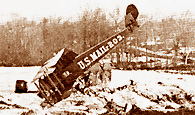
Posted by Michael McKinney at 12:39 PM
08.12.08

Are You Having a No-Good, Very-Bad Day?
IF YOU are like most of us, anything going on but what you want, warrants a complaint. Not an action-oriented, let’s get this solved kind of complaint, but your everyday run-of-the-mill mindless kind of complaining that leads nowhere (except to more negative thinking). Jon Gordon, author of The No Complaining Rule, says there are two main reasons why we complain: (1) because we are fearful and feel helpless and two, because it has become a habit. He urges us to outgrow the complaining habit. He cites a Gallup poll that finds that negativity costs companies nearly $300 billion each year. “In life,” Gordon writes, “you have a choice between two roads. The positive road and the negative road. The positive road will lead to enhanced health, happiness, and success and the negative road will lead to misery, anger, and failure. Since your bus can’t be on two roads at the same time, you must decide which road you want to be on. And when you complain you travel down the negative road.” “In life,” Gordon writes, “you have a choice between two roads. The positive road and the negative road. The positive road will lead to enhanced health, happiness, and success and the negative road will lead to misery, anger, and failure. Since your bus can’t be on two roads at the same time, you must decide which road you want to be on. And when you complain you travel down the negative road.” As former chronic complainer, Gordon effectively delivers his message through a story. The No Complaining Rule doesn’t rule out complaining – it requires that it be constructive. Employees are not allowed to mindlessly complain to their coworkers. If they have a problem or complaint about their job, their company, their customer, or anything else, they are encouraged to bring the issue to their manager or someone who is in a position to address the complaint. However, the employees must share one or two possible solutions to their complaint as well.Gordon explains how do develop a positive culture by creating a culture where negativity can’t breed, grow, and survive. A crucial key is to all this is to focus on gratitude. “Research shows that when we count three blessings a day, we get a measurable boost in happiness that uplifts and energizes us. It’s also physiologically impossible to be stressed and thankful at the same time. Two thoughts cannot occupy our minds at the same time. If you are focusing on gratitude, you can’t be negative. You can also energize and engage your coworkers by letting them know you are grateful for them and their work.” Start a revolution in your own life, at work, and at home. Download free No Complaining Rule posters and other tools from Jon Gordon’s web site. Have no complaining day! 
Posted by Michael McKinney at 09:22 PM
06.26.08

What’s the Hidden Danger of Being the Brightest Person In the Room?Leaders in organizations who are dealing with a specific issue or problem should ensure that they collaborate with team members toward its resolution, even if they are the best-informed, most experienced, or most-skilled person in the group. Not to do so would be fool-hardy.In fact, behavioral scientist Patrick Laughlin and his colleagues have shown that the approaches and outcomes of groups who cooperate in seeking a solution are not just better than the average member working alone, but are even better than the group’s best problem solver working alone. Far too often, leaders-who, by virtue of greater experience, skill, and wisdom, deem themselves the ablest problem solver in the group—fail to ask for input from team members. The research conducted by Laughlin and his colleagues tells us why the best leader operating individually will be beaten to a correct solution by an all-inclusive cooperating unit. First, lone decision-makers can’t match the diversity of knowledge and perspectives of a multi-person unit that includes them. Second, the solution seeker who goes it alone loses another significant advantage—the power of parallel processing. Whereas a cooperating unit can distribute many subtasks of a problem to its members, a lone operator must perform each task sequentially. But isn’t full collaboration risky? After all, decisions made completely by committee are notorious for suboptimal performance, Mindful of that problem, our recommendation is not to employ a vote-counting strategy in order to come to a resolution; in fact the recommendation is not for making joint decisions at all. The final choice is always for the leader to make. But it’s the process of seeking input that leaders should engage in more collectively. In Yes! 50 Scientifically Proven Ways to Be Persuasive authors Noah Goldstein, Steve Martin and Robert Cialdini, tackle a lot of interesting questions regarding the art and science of persuasion. For example, they ask what common mistake causes messages to self-destruct? The answer is found in the answer to why a sign pointing out the problem of vandalism in the Petrified National Park actually increased the theft of pieces of petrified wood. What we learn is to focus our communications on the fact that there are a lot of people doing the right thing and build on that. You will find a lot of good practical insights here. Adapted from Yes! 50 Scientifically Proven Ways to Be Persuasive by Noah Goldstein, Steve Martin and Robert Cialdini.
Posted by Michael McKinney at 03:15 PM
06.23.08

Define the Correct QuestionBusiness environmentalist Jack Giampalmi, remarked in a recent speech the importance of asking the right question if we are to get the solution that will bring change.Solutions are easy. Where leadership is essential is in defining and understanding the real question. For example, global warming, or climate change, finds its way onto many agendas, and many agendas may even be hidden. But is the right question being asked? Be sure to know what the real question is when faced with a problematic issue. We are constantly being bombarded and facing hidden agendas while solving problems which address the wrong question. This hinders sustainability.
Posted by Michael McKinney at 03:37 PM
05.13.08

Learning Requires Personal Responsibility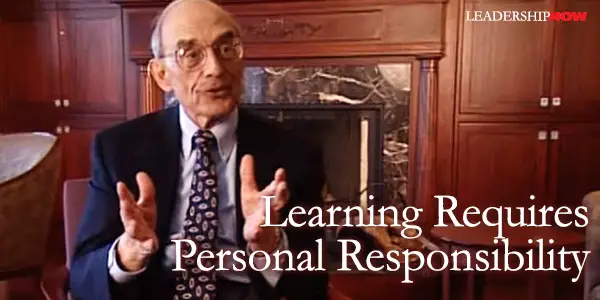 THE Harvard Business Press is publishing some of the classic articles from past issues of the Harvard Business Review in handy pocket-size book form. This month they are releasing Teaching Smart People How to Learn by Chris Argyris. It first appeared in the May-June 1991 issue. In it he tells us that “success in the marketplace increasingly depends on learning, yet most people don’t know how to learn.” Worse still is the fact that those we assume to be the best at learning – knowledge workers – are not very good at it.
THE Harvard Business Press is publishing some of the classic articles from past issues of the Harvard Business Review in handy pocket-size book form. This month they are releasing Teaching Smart People How to Learn by Chris Argyris. It first appeared in the May-June 1991 issue. In it he tells us that “success in the marketplace increasingly depends on learning, yet most people don’t know how to learn.” Worse still is the fact that those we assume to be the best at learning – knowledge workers – are not very good at it.
True learning, what Argyris calls double-loop learning, requires that we be open to criticism. Most of what passes for learning is, according to Argyris, single-loop learning. Single-loop learning is, problem solving. That is to say, working on problems in the external environment – behaviors and tactics. This is really nothing more than fixing symptoms. Instead, workers need to “reflect critically on their own behavior, identify the ways they often inadvertently contribute to the organization’s problems, and then change how they act.” It is looking at “why we do what we do.” It is rethinking the assumptions behind why we do what we do. 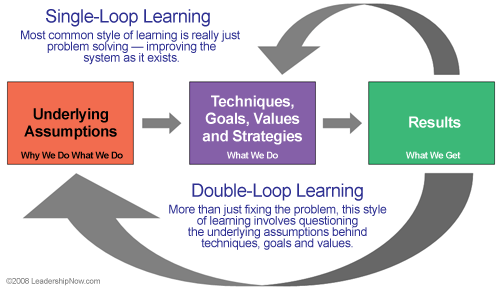 Argyris describes single and double-loop learning using this analogy: a thermostat that automatically turns on the heat whenever the temperature in a room drops below 68 degrees is a good example of single-loop learning. A thermostat that could ask, ‘‘Why am I set at 68 degrees?’’ and then explore whether or not some other temperature might more economically achieve the goal of heating the room would be engaging in double-loop learning. The ideas Argyris lays out in this article are truer today than when he wrote it. Knowledge workers must by the nature of their work, put themselves – their identity - out there in the workplace. This makes them more vulnerable and more likely to become defensive when they are shown to be responsible, to some degree, with a problem. Double-loop learning requires taking personal responsibility and a willingness to challenge what one is doing. Know Thyself begins to take on a new dimension. 
Posted by Michael McKinney at 09:23 PM
04.14.08

Getting the Information You NeedIn the Spring issue of the Leader to Leader Journal, authors Mark Ronald and Robert Shaw tackle the issue of getting the good information needed to make informed decisions in Developing Peripheral Vision. The problem we are often faced with is that people are reluctant to talk about their concerns. They write, “For a variety of reasons, individuals often communicate in subtle or even misleading ways in regard to how they feel about a key decision.” There is a lot that we as leaders, can do contribute to the problem of open and clear communication.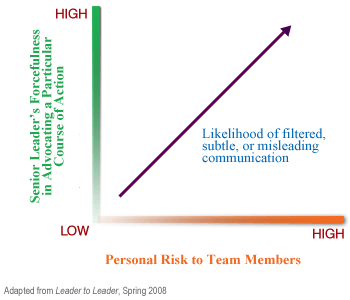 They list six behavioral flags or signals that might mean that the leader needs to take more direct action to get the information they need. In brief: Silence: In leadership teams, members who don’t support the trend of a decision often simply disengage from the dialogue and remain silent rather than pose a contrary point of view—particularly if the leader appears to support the decision or the group is moving quickly to closure. Who has checked out? Non-answers: People can opt out by appearing to agree with the leader when, in fact, they do not. “If you think it’s the right decision, that’s good enough for me.” Omissions: It is often what is not said that is most critical—particularly on issues that the leader believes will be problematic. Specific language: People surface their true feelings in hundreds of subtle ways. Leaders need to pay attention to the specific use of words that are flags suggesting that more discussion or follow-up is needed. Offline input: Often, the insights people bring to a leader (or each other) during the breaks of meetings or in informal hallway conversations are more important than what is said in formal discussions. E-mail traffic: In many firms, e-mail offers insight into potential issues that may require a leader’s attention. For example, an overly formal e-mail message with multiple people copied (or blind copied) is often a protective action taken by a team member with concerns. It is up to the leader to determine what is important and what is simply noise.
Posted by Michael McKinney at 01:26 AM
02.11.08

Insultants Wanted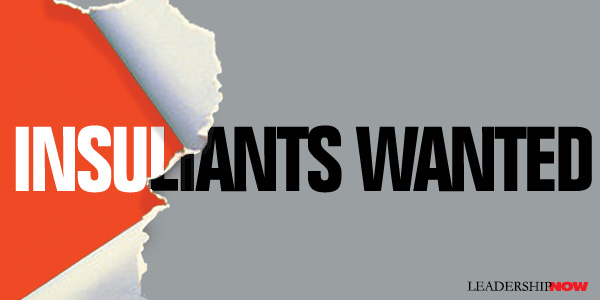 WE need people who will tell us like it is in the right way. Often we don’t like to hear what they have to say but we should never discourage them. Frequently, leaders are the last to know. Keith McFarland author of The Breakthrough Company, calls these straight-shooters insultants (inside consultants). He describes them as those people “willing to ask the tough questions that cause a company to think critically about its fundamental assumptions. The value of insultants is that they will go to great lengths to get their companies to reevaluate a position or adapt to a changing environment.”
WE need people who will tell us like it is in the right way. Often we don’t like to hear what they have to say but we should never discourage them. Frequently, leaders are the last to know. Keith McFarland author of The Breakthrough Company, calls these straight-shooters insultants (inside consultants). He describes them as those people “willing to ask the tough questions that cause a company to think critically about its fundamental assumptions. The value of insultants is that they will go to great lengths to get their companies to reevaluate a position or adapt to a changing environment.”
If you think that you welcome these people, think again. A survey showed that while 90 percent of CEOs believed that their companies regularly implemented ideas that the CEO initially didn’t like, only 60 percent of their direct reports agreed. McFarland reports that people tend to differ to authority and rank because they feel that they must know better. “But often authority figures are wrong, and if an organization doesn’t have a strong insultant culture, errors are likely to be propagated throughout the company.” If you feel you are an insultant, don't think you begin by charging in like a bull in a china shop. There is a right way and a wrong way to do things. You are trying to make the leader successful, not trying to show how smart you are or place the spotlight on yourself. Good insultants must learn to excel at relationships based on genuine care for others. McFarland offers these tips that one would do well to heed:
As a leader, you gain nothing by not knowing what people are thinking. People with ideas and challenges to your way of doing things are not necessarily being insubordinate. They are practicing leadership. Leaders can encourage a candid environment be celebrating productive failure, involving people enough in the issues that they can make intelligent contributions, focusing on both employees and customers that have left the company, and using humor to encourage frankness and trust. 
Posted by Michael McKinney at 01:47 PM
02.08.08

What to Do When Things Go Wrong
WHEN THINGS GO WRONG, we often begin by asking ourselves the wrong questions like “Why is this happening to me?” In QBQ, John Miller writes that “our first reactions are often negative, bringing to mind incorrect questions. But if in each moment of decision we can instead discipline our thoughts to look behind those initial questions and ask better ones (QBQ’s – the Questions Behind the Questions), the questions themselves will lead us to better results….The answers are in the questions.” When a problem (or a challenge is you prefer) arises, we start looking for some control of the situation. The problem is, we quite naturally begin by looking at those around us and ask the wrong types of questions like “why?” and “who?” The wrong questions take away any control of the situation we might otherwise gain. In LeaderShock, Greg Hicks suggests that we look for meaning in the situation first. Ask self-revealing questions like:
He adds, “You’re on shaky ground if you attempt to fix a problem without first understanding what it means to you and your organization. By looking for inherent meaning, you open a rich treasure chest of valuable gems that lead to new information, insight, and opportunities.” John Miller stresses that the right questions contain an “I” and not “you,” “they,” and “them.” “I” questions lead to action. “Questions that contain an “I” turn our focus away from other people and circumstances and put it back on ourselves, where it can do the most good. We can’t change other people. We can’t control circumstances and events. The only things we have any real control over are our own thoughts and actions. Asking questions that focus our efforts and energy on what we can do makes us significantly more effective, not to mention happier and less frustrated.”
Posted by Michael McKinney at 10:28 AM
01.25.08

Deciding How We Decide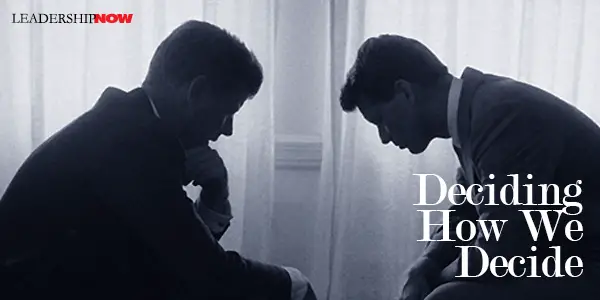
HOW WE COME to decisions has to be as important as the decisions we come to. Changing how we decide may be the fundamental shift we can make in how we—as individuals and organizations—change. It is appropriate to spend some time thinking about it. While a single person may make the final decision, it should always be made in an atmosphere of open listening and sharing. In Why Great Leaders Don’t Take Yes for an Answer, professor Michael Roberto, devotes a chapter to this issue. He begins by showing how John F. Kennedy changed the decision-making process from the tactics employed in the failed Bay of Pigs decision to the better process employed in coming to the successful conclusion of the Cuban Missile Crisis. It demonstrates “how leaders can learn from failures and then change the process of decision that they employ in the future.” It’s an interesting case in demonstrating the importance of deciding how we decide and having the mindset to do so. He discusses four critical choices that affect a leader’s ability to “cultivate constructive conflict and build enduring consensus: First, the leader determines the composition of the decision-making body. The selection should be based on access to expertise, implementation needs, the role of personal confidant, and the effect of demographic differences. Second, they shape the context in which deliberations will take place. What norms and ground rules will govern the discussions? Third, the leader determines how communication will take place among the participants. How will people exchange ideas and information, as well as generate and evaluate alternatives? Structured? Free exchange? Fourth, the leader must determine the extent and manner in which they will control the process and content of the decision. What roll will the leader play? Roberto adds these important cautionary comments about content-centric and process-centric learning: When decision failures occur, many executives focus on the issues involved, and they seek to identify the mistaken judgments and flawed assumptions that they made. However, many leaders do not push further to investigate why they made these errors. Too many of them engage only in content-centric learning. By that, I mean that they search for lessons about how they will make a different decision when faced with a similar business situation in the future.Good material. Check it out. See Also: 
Posted by Michael McKinney at 01:41 PM
12.19.07

How To Avoid Making the Wrong Moves: Think Twice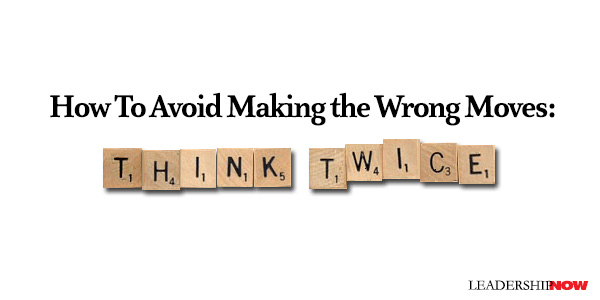
IN their 2008 Investor’s Guide, Fortune magazine offered ten tips to help you “prevent the heat of the moment from melting your better judgment.” The tips form an acronym – Think Twice – and are worth keeping in mind no matter what you’re thinking about.

Posted by Michael McKinney at 08:57 AM
12.14.07

Which Should You Have? Performance Goals versus Learning Goals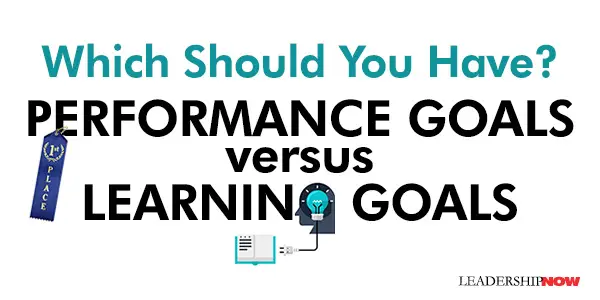
STANFORD UNIVERSITY psychologist Carol Dweck once made a great distinction between performance goals versus learning goals.
Learning goals are ones that are about increasing your competence. “It reflects a desire to learn new skills, master new tasks, or understand new things—a desire to get smarter.” Both goals she noted are common and can fuel achievement. So there’s nothing wrong with either one. “In fact,” she says, “in the best of all possible worlds, students could achieve both goals at the same time.” Unfortunately, we don’t live in the best of all possible worlds. One is usually pitted against the other. “The tasks that are best for learning are often challenging ones that involve displaying ignorance and risking periods of confusion and errors. The tasks that are best for looking smart are often ones that students are already good at and won’t really learn as much from doing.” What she has found is that an overemphasis on performance goals – wanting to look good – can foster a helpless response. In a 1988 study, they found that “many of the students with performance goals showed a clear helpless pattern in response to difficulty. A number of them condemned their ability, and their problem-solving deteriorated. “In sharp contrast, most of the students with learning goals showed a clear mastery-oriented pattern. In the face of failure, they did not worry about their intellect, they remained focused on the task, and they maintained their effective problem-solving strategies. “When children are focused on measuring themselves from their performance, failure is more likely to provoke a helpless response. When children are instead focused on learning, failure is likely to provoke continued effort.” Another interesting tidbit came out of the study. “Some children were told at the start of the study that they had the ability to do really well at the task. Others were told (temporarily) that their level of ability at the task was not so high. For students with performance goals, this message made a real difference: Students who were certain of their high ability were more likely to hold on in the face of failure and remain mastery-oriented. But students who thought their ability was lower fell right into a helpless response.” It made no difference to the student with learning goals. How are we structuring the environment in our schools and organizations? It seems to me we foster environments that encourage and reward levels of achievement and not degrees of learning. In such a case, most people would opt out for performance goals. Who wants to take a chance of being criticized for looking dumb? Are we learning or looking good? Incidentally, an important book by Carol Dweck has been released in paperback. It covers some of this material. Check out Mindset: The New Psychology of Success. 
Posted by Michael McKinney at 08:59 AM
12.07.07

Roger Martin on Assertive Inquiry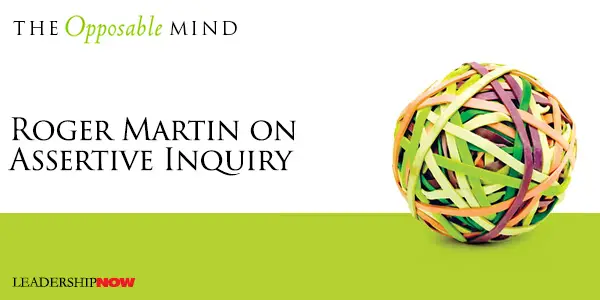 READERS have had some questions about "assertive inquiry" as presented in Roger Martin’s book The Opposable Mind. Here are some explanatory excerpts from the book:
READERS have had some questions about "assertive inquiry" as presented in Roger Martin’s book The Opposable Mind. Here are some explanatory excerpts from the book:
“When we interact with other people on the basis of a particular mental model, we usually try to defend that model against any challenges. Our energy goes into explaining our model to others and defending it from criticism. “The antidote to advocacy is inquiry, which produces meaningful dialogue. When you use assertive inquiry to investigate someone else’s metal model, you find saliencies that wouldn’t have occurred to you and causal relationships you didn’t perceive. You may not want to adopt the mental model as your own, but even the least compelling model can provide clues to saliencies or causal relationships that will generate a creative solution.” Ask:
Not:
Obviously tone is important here. If your attitude is one of really seeking to understand and build bridges, it will come across. Otherwise, it is just another way you’ve picked up to try to argue your point and that will come across too. Martin continues, “Assertive inquiry isn’t a form of challenge, but it is pointed. It explicitly seeks to explore the underpinnings of you own model and that of another person. Its aim is to learn about the salient data and causal maps baked into another person’s model, then use the insight gained to fashion a creative resolution of the conflict between that person’s model and your own.” 
Posted by Michael McKinney at 08:38 AM
11.30.07

How to Develop Integrative Thinking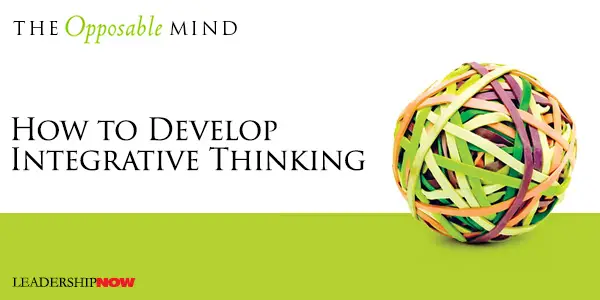
A 2007 study (PDF) conducted by the Center for Creative Leadership found that nearly 92 percent of the executives surveyed believe the challenges their organizations face are more complex than they were just five years ago. Organizations will continually be asked to do even more with less and respond even faster to changes in their industry and economy. Complexity is not going to go away, but developing the skills necessary for integrative thinking as described by Roger Martin in The Opposable Mind (the ability to hold two conflicting ideas in constructive tension) can be an effective way to keep from being sidelined by it. “Integrative thinking is largely a tacit skill in the heads of people who have cultivated, knowingly or otherwise, their opposable minds.” How do we develop integrative thinking? First, we begin by thinking about how we think. Martin writes, “When you refuse to take your thinking for granted, you give yourself the best opportunity to enhance and utilize your opposable mind to its fullest.” By taking a look at your personal knowledge system – how you know what you know – you can get some insight into how you make decisions. Martin has defined three areas, as shown in the diagram below, that guide and inform each other as your experiences grow. Stance: How you see and interact with the world; your philosophy. Martin lists six important ways of looking at the world and self. Tools: Integrative thinkers use generative reasoning (asking what might be instead of what is), causal modeling (considering not only linear and unidirectional relationships but nonlinear and multidirectional relationships as well) and, what I found helpful, assertive inquiry (not argumentative, but pointed questions seeking to find common ground). [Note: There is a great example beginning on page 159 in this regard.] Experiences: Your stance directly affects the kinds of experiences you will accumulate. Structured repetition of a consistent type of experiences develops mastery. Combined with originality, mastery will help you to grow. 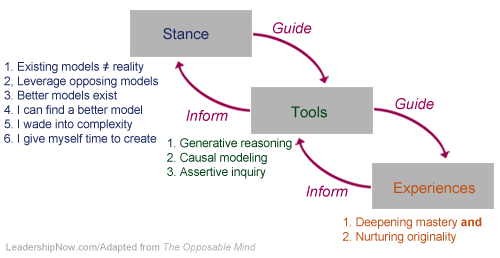 With an understanding of how these areas interact with each other, you can, over time, take an active role in crafting your personal knowledge system. Martin has packed into a short book, a good primer on developing a mind that can grapple with complex issues and find creative solutions that would otherwise be missed. It’s well worth your time. 
Posted by Michael McKinney at 12:08 AM
10.29.07

How To Get Great Ideas: Lessons for Brainstorming
IN 1941, advertising man Alex Osborn (BBDO) came up with the idea of “Thinking Up” which was later changed to brainstorming by his “thinking-up” colleagues. In an excellent book about innovative and productive thinking simply titled, Think Better, author Tim Hurson reviews Osborn’s list of four essential rules for effective brainstorming:
Hurson notes that studies have shown that the last third of a brainstorming session usually results in the best ideas. He calls it the miracle of the third third. “You’ll have a greater chance of coming up with that one brilliant idea if you get all the way to the third third than you will if you stop at the first “right” idea.” He writes: The first third of the session tends to produce mundane, every-one-has-thought-of-them-before ideas. These are the early thoughts that lie very close to the surface of our consciousness. They tend not to be new ideas at all but recollections of old ideas we’ve heard elsewhere. They are essentially reproductive thoughts. He says, “Brainstorming is like cholesterol—there’s good and bad, and most people have only experienced the bad.” We have all experienced brainstorming like this: There’s no separation of the different ideas of thinking going on. Creative, idea-generating thinking is being stopped cold by critical, judgmental think. Ideas are being killed before they’re fully articulated. He adds, that “Bad brainstorming is binary; ideas are either good or bad. Good brainstorming is full of maybes." The biggest issue we face in creative thinking is our own patterns of thought that keep us on the straight and narrow. We hold ourselves back because of personal notions of what is right and wrong and what will and won’t work. There’s no magic pill to conquer this. It takes a conscious effort. He suggests though that “Generating long lists of ideas flushes those early ideas out of your head so you can make room for new ones.” Tim Hurson is a founding partner of thinkx intellectual capital. It is a global consultancy for productive thinking and innovation. 
Posted by Michael McKinney at 10:53 AM
08.15.07

It's Not About Me?!?In The Ring in the Rubble, Gary Brandt brings up something that can hold us back from defining our problem, immobilize us, and block us from finding solutions. We tend to think that what we see is reality, and to forget that there is a much bigger world out there that, if we considered it, would put our situation into perspective. When we forget this, we tend to take our own perspective a little too seriously, and in the process, we take ourselves too seriously as well.Brandt suggests that a well-developed sense of humor makes a good antidote.
Posted by Michael McKinney at 08:25 AM
07.02.07

The Great Brain Robbery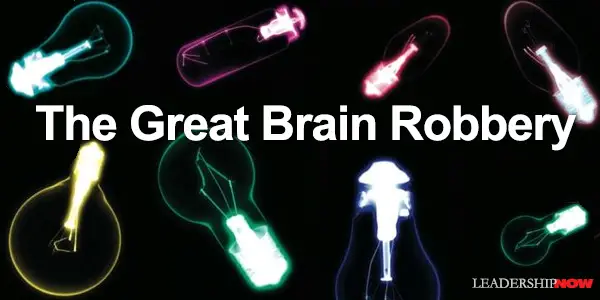
IN another post I quoted Will and Ariel Durant’s observation that out of every hundred new ideas ninety-nine or more will probably be inferior to the traditional responses which they propose to replace, comes a related idea. It may take a dose of humility to accept, but whatever problem you are faced with—whether personal of professional—someone else has faced the same problem and solved it. Although it sometimes gives us comfort to think we are different, we are not totally unique in this way. Paul Sloan, author of The Innovative Leader, says that we should harness other people’s solutions. Ray Considine called it The Great Brain Robbery. Baseball Hall-of-Fame inductee, Bill Veeck said, “There’s nothing wrong with stealing other people’s ideas. And anyone who doesn’t is presumptuous. Because there simply aren’t that many new ideas. You simply take something used somewhere else and adopt it for your own use.” These people aren’t talking about plagiarism. What they are saying is that we should find ideas that have worked for others and adapt them to our own life situations and to make them our own. By careful observation, you can start where others have finished and be the better for it. This is part of the thinking behind listening to others (especially your elders), reading biographies and histories. Armed with the knowledge of what others have done, you can jumpstart your problem-solving capabilities.  Sloan adds, “A successful innovation in your business does not have to be an all-new invention. It just has to be something new to your business that is beneficial…. Maybe every consulting firm does it but yours is the first doctors’ surgery to try it.” You need to cast your net widely and look around for connections in otherwise unrelated fields and disciplines and make their solutions your solutions. What can you adapt? 
Posted by Michael McKinney at 10:43 AM
04.21.07

Fast Company Interview with Sir James Dyson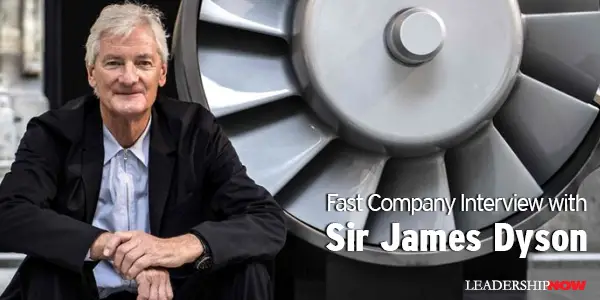
THE discussions on Appreciative Intelligence and Charles Pellerin’s views on the social leadership aspects of project management, parallel a good short interview in the May issue of Fast Company with Sir James Dyson. Here are a couple of his comments: FC: You once described the inventor's life as "one of failure." How so?
Posted by Michael McKinney at 11:13 PM
04.20.07

Charles Pellerin on Project Management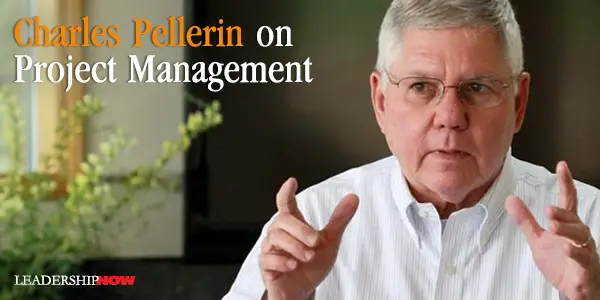
APPRECIATIVE INTELLIGENCE—the ability to perceive the positive inherent generative potential within the present—is an important component to develop as part of organizational culture. AI contributes to a high incidence of innovation and creativity and the potential development of previously unnoticed strengths in people. This happens by the actions of leaders at all levels, to encourage people to look at everyday issues—the commonplace—in a new way; by telling a new story. 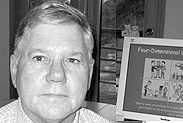 Can you explain what you mean by "social issues," and how they relate to leadership? This would help to explain the recent experiment reported in the Washington Post by Gene Weingarten to discover if violinist Josh Bell—and his Stradivarius—could stop busy commuters in their tracks. Surprisingly, he did not. If our story is to ignore street musicians and includes the belief that no famous musician would ever do it, then we will ignore street musicians and we will not scan the streets looking for our favorite artists. (If you haven’t read it yet, do so. It’s a great story.) Pellerin has been developing since his retirement from NASA in 1995, a leadership/culture assessment and learning system called "Four-Dimensional (4-D) Leadership." He states, “We began with workshops, and then added coaching, and now have Web-based diagnostics customized for NASA projects. Simply put, we make three measurements in each of the social dimensions -- directing, visioning, relating and valuing—that we believe are fundamental to effective leadership and efficient cultures. “I truly believe that we can identify and address the root cause of most project difficulties. That's my story. And many of the projects I'm working with are choosing to run that story as well -- because they see results. You know, no story is "good" or "bad." Some just get you the results you want and some don't.”
Posted by Michael McKinney at 07:21 AM
04.19.07

Appreciative Intelligence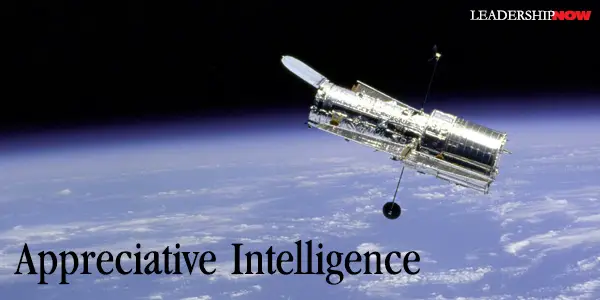
IN April 1990, shuttle Discovery launched the Hubble Space Telescope into its planned orbit. However, within weeks it became obvious that there was a serious problem with the primary mirror. Authors Tojo Thatchenkery and Carol Metzker describe the events that followed in their book Appreciative Intelligence: Seeing the Mighty Oak in the Acorn. Congress demanded an explanation for the failure. The project and its creators became the butt of late-night television jokes. Stress was high among NASA engineers, as were health problems. “It was traumatic,” said Charlie Pellerin, the former director of NASA’s astrophysics division, who oversaw the launch of the Hubble. Nobody could see how to fix the problem, which many seemed afraid even to address. Appreciative Intelligence is defined as “the ability to perceive the positive inherent generative potential within the present.” More simply, it is “the ability to see the mighty oak in the acorn. It is the ability to reframe a given situation (or person), to appreciate its positive aspects, and to see how the future unfolds from the generative aspects of the current situation.” These three characteristics form the foundation of appreciative intelligence. Reframing is about shifting reality by choosing what feedback we will ignore and what feedback we will pay attention to. Appreciating the positive is the ability to see the positive aspects of any given situation. To see how the future unfolds from the present refers to the ability to see what can be done instead of what can’t. Appreciative intelligence is the mindset that allows you to step back and access the situation and move forward instead of being thwarted by circumstances. Appreciative intelligence can, of course, be developed by consciously expanding your responses to situations as they occur. Asking yourself different questions by questioning your assumptions (what you know to be right), looking for positive and different meaning in what you experience, and becoming what Saul Bellow calls a first-class noticer, will help you improve your appreciative intelligence.Additionally, keep in mind the AI qualities of persistence, conviction that your actions matter, tolerance for uncertainty, and irrepressible resilience. As these qualities develop, so too will your creativity and success in finding a resolution to the issues you face. Appreciative Intelligence: Seeing the Mighty Oak in the Acorn provides in more detail what I have outlined here.
Additional Interest:

Posted by Michael McKinney at 07:42 AM
03.21.07

Charles Koch on Decision Making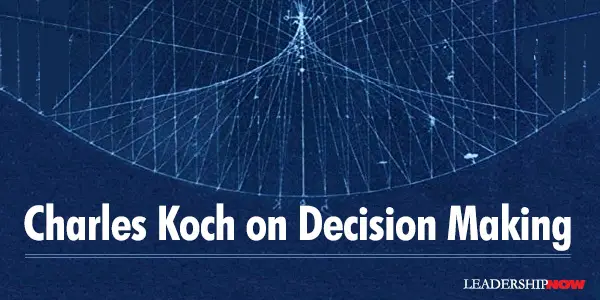
CHARLES KOCH finally published the ideas he applied and named Market-Based Management (MBM) in his book The Science of Success. While there is no such thing as the science of success (it is a comforting idea), this book presents a lot of ideas that are worth taking a look at for possible application elsewhere. I did appreciate his viewpoint on decision making: Proximity to a problem or process does not determine who is in the best position to make a decision. In a world characterized by knowledge-driven rapid change, top-down decision-making is commonly criticized as being highly inefficient. It is true that centralized command-and-control business management suffers from many of the same problems seen in centrally planned economies. Those with local knowledge are often in a better position to solve the problem at hand. The ideas and creative energy of all employees should be leveraged, but universally decentralized decision-making has its own problems. Some decisions, if made at the local level, can be unprofitable because a broader perspective is required. 
Posted by Michael McKinney at 01:43 AM
02.16.07

In Difference Lies the Potential to Contribute WE tend to think that if we get the smartest people all together in one room, we will get the best solutions. In a very readable book, The Difference, Scott Page shows that in fact diversity in thinking and perspective produces more and better solutions and contributes to overall productivity. He maintains that “when confronted with a difficult task, be it solving a problem, predicting the future, or making a choice, we benefit by including diverse people.” Value can be added just by virtue of its being different. How many disciplines have benefited from interdisciplinary approaches? Diversity doesn’t necessarily mean black/white or men/women, but diversity in thinking and perspective. He notes that “cognitive diversity increases innovation. Preference diversity leads to squabbles.” So we’re looking for relevant diversity and informed intelligence. 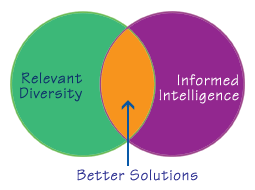 The trap we fall into is that we prefer to continue to work with and consult people who think like us—people with the same general background and types of experiences. The familiarity is more comfortable and seems right to us. In the end, we get the same way of looking at things and we bring the same kinds of tools to the table to tackle our problems. We miss important clues. If one of us gets stuck, then we all get stuck. “People who think alike get stuck.” We also create barriers to innovation and radically new ideas. A preference for working with people who bring the same formal perspectives to bear on a problem leads to segregation by function in firms and by discipline in the academy. In each case, the tendency to interact only with people like us creates the same micro-level dynamic. Each culture in a society, each identity group in a city, each department in a university, and each functional area of a firm ends up building walls around itself. As these walls become higher, the members of each group—be they Evangelicals, African Americans, chemists, or accountants—find themselves inside silos of their own creation. He suggests that we should not only get more kinds of people involved in tackling the issues, we should also encourage our people to think differently by giving them time to pursue individual projects that interest them (varied experience) and by creating skunk works type groups within the organization. He observes, “as individuals, we can accomplish only so much. We’re limited in our abilities. Our heads contain only so many neurons and axons. Collectively, we face no such constraint. We possess an incredible capacity to think differently. These differences can provide the seeds of innovation, progress, and understanding.” 
Posted by Michael McKinney at 08:56 AM
12.20.06

The Go PointMen make their own history, but they do not make it as they please; they do not make it under self-selected circumstances, but under circumstances existing already, given and transmitted from the past. 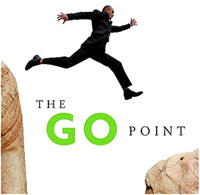 Yet, within those constraints, argues Michael Useem, we have the opportunity to make our own destiny. We all make decisions all the time. Some decisions are in consequential, but often we are called upon to make consequential decisions—those that affect other people. Some people are very good at consistently reaching good decisions in a timely way. Yet, it is surprising how many people are just not great at knowing when to pull the trigger, and how to pull it when they do. The Go Point seeks to address that concern. By taking us into the moment when decisions were made, both good and bad, Useem digs out the principles that emerge from these experiences. From these examples, he constructs templates of fifty principles and tools we can bear in mind when faced with similar types of decisions. He advises us to identify the five or ten lessons that are most salient for the decisions that we most frequently face and then concentrate on just those.
Yet, within those constraints, argues Michael Useem, we have the opportunity to make our own destiny. We all make decisions all the time. Some decisions are in consequential, but often we are called upon to make consequential decisions—those that affect other people. Some people are very good at consistently reaching good decisions in a timely way. Yet, it is surprising how many people are just not great at knowing when to pull the trigger, and how to pull it when they do. The Go Point seeks to address that concern. By taking us into the moment when decisions were made, both good and bad, Useem digs out the principles that emerge from these experiences. From these examples, he constructs templates of fifty principles and tools we can bear in mind when faced with similar types of decisions. He advises us to identify the five or ten lessons that are most salient for the decisions that we most frequently face and then concentrate on just those.
The underlying point in this book is that decision making is a learned skill. You've got to make decisions and then look back on them and mine what lessons you can in order to improve your next decision. Whether it's a long term decision or a split second decision, there is a point when you have to force yourself to make it. That moment is the go point. He writes, “The go point is not always a matter of getting to yes….Rather, the go point is that instant when the choice gets made, whether no or yes, and the commitment moves from consideration to action. How you jump at that moment can make a vast difference, not only for yourself but also for all around you." Below is a template for looking at some of the most commonly encountered problems in reaching a decision.
Posted by Michael McKinney at 08:49 AM
06.01.06

Problem Solving with a Design Attitude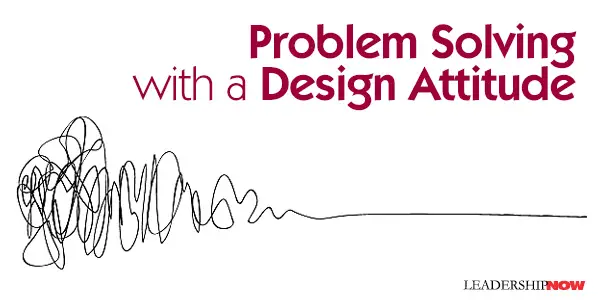
PROFESSORS Richard Boland and Fred Collopy from the Case Western Reserve University’s Weatherland School of Management had the opportunity to work with Frank O. Gehry on the management schools new building. The design process exposed them a problem solving approach they call a design attitude.  We believe that if managers adopted a design attitude, the world of business would be different and better. Managers would approach problems with a sensibility that swept in the broadest array of influences to shape inspiring and energizing designs for products, services, and processes that are both profitable and humanly satisfying. Working with Gehry has led them to see “how both management practice and education have allowed a limited and narrow vocabulary of decision making to drive an expansive and embracing vocabulary of design out of circulation. In our focus on teaching students advanced analytical techniques for choosing among alternatives, our attention to strengthening their design skills for shaping new alternatives has withered.” The most dominate approach we see today they call the decision attitude. This approach uses mathematical and scientific approaches—economic analysis, risk assessment, multiple criteria decision making, simulation, and the time value of money—to choose among alternatives. “It starts with the assumption that the alternative courses of action are ready at hand—that there is a good set of options already available, or at least readily obtainable. “ The design attitude on the other hand assumes the best alternative may have to be invented. Design thinking doesn’t mean bringing more creativity to bear. “Creativity itself is not going to bring us to the organizational, product, or process innovations we require. Creativity needs the guiding energy of a design attitude in order to focus our efforts on results that will be truly innovative and produce long-lasting organizational betterments.” Design is in that sense larger than creativity. Design provides a context for creativity by channeling it toward humanly satisfying purposes, and that is why we cannot allow calls for increased creativity and techniques for enhancing creativity to take the place of increased attention to s design attitude in management practice and education. The illustration below from The Central Office of Design adds a graphic explaination of design thinking.
They explain on their web site that they "start each project assuming nothing, especially about what the solution to the problem might be, and embark on the process with empathy for the final consumer of the solution. Whether it be an employee, child, or mother of three."
Posted by Michael McKinney at 12:36 AM
|
BUILD YOUR KNOWLEDGE


How to Do Your Start-Up Right STRAIGHT TALK FOR START-UPS 
Grow Your Leadership Skills NEW AND UPCOMING LEADERSHIP BOOKS 
Leadership Minute BITE-SIZE CONCEPTS YOU CAN CHEW ON 
Classic Leadership Books BOOKS TO READ BEFORE YOU LEAD |
| |||||||||||||||||||||||||||||||||||||||||||||||||||||||||||||||||||